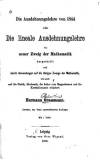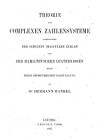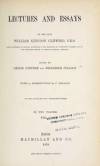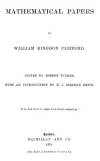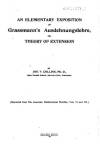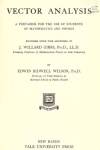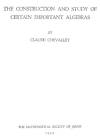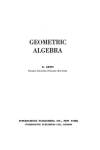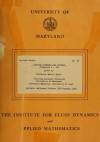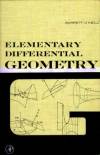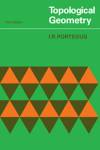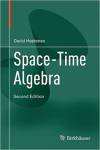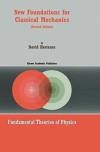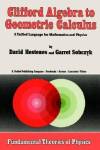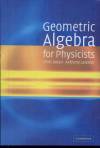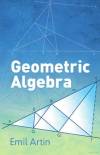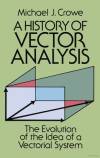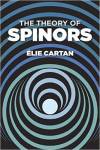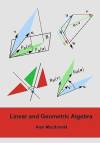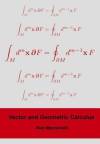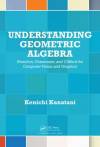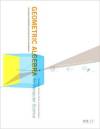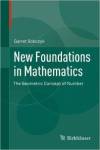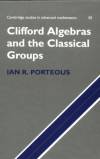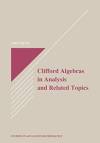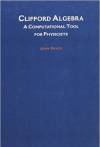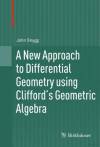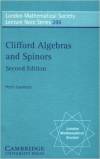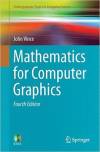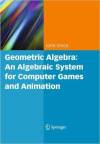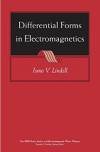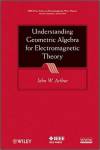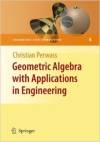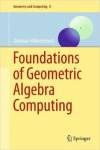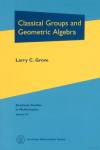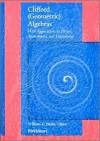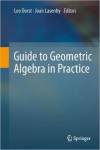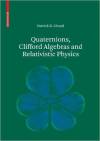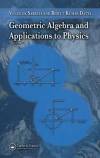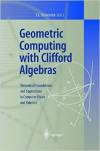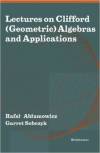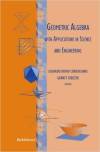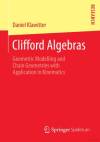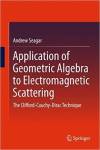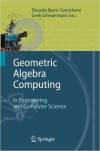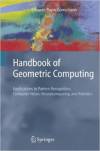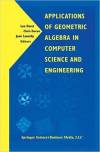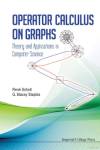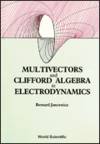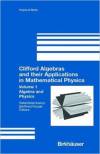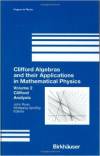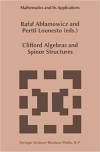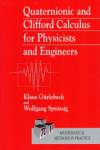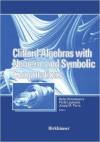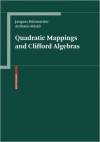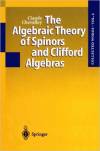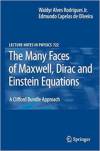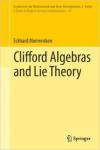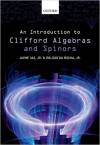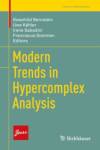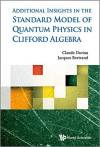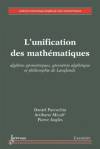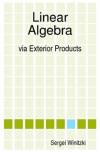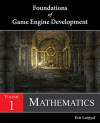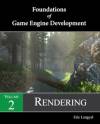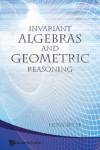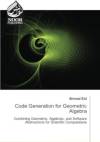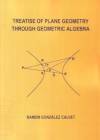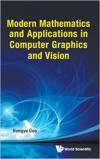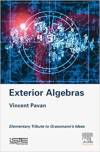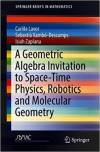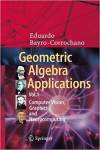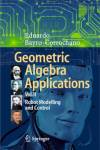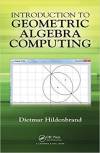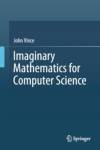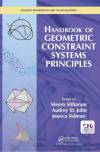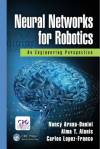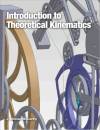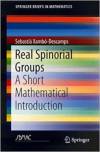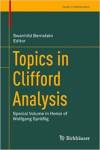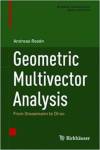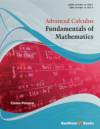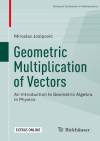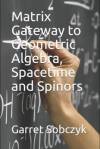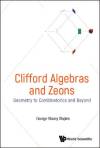Table of Contents
Geometric Algebra
Eine Sammlung nützlicher Ressourcen
Introduced by Hermann Grassmann and greatly expanded by William Kingdon Clifford during the 19th century, Geometric Algebras provide a proper abstract framework for the treatment of geometrical vector operations that extend naturally to general dimensions. Their concise concepts yield elegant and peculiarly coherent constructs, in contrast with the intricacies of Vector Calculus. Because of the geometric origin of their structures and close relation to quadratic forms they turn useful in a wide range of applications in theoretical and applied sciences across several fields.
Sites
Research
- Geometric Calculus Research & Development - David Hestenes, Arizona State University
This web site is dedicated to perfecting a universal mathematical language for science, extending its applications and promoting it throughout the scientific community. It advocates a universal scientific language grounded in an integrated Geometric and Inferential Calculus.
- Geometric algebra (based on Clifford algebra) - Leo Dorst, Daniel Fontijne, Intelligent Autonomous Systems, University of Amsterdam
Geometric algebra is a very convenient representational and computational system for geometry. We firmly believe that it is going to be the way computer science deals with geometrical issues. It contains, in a fully integrated manner, linear algebra, vector calculus, differential geometry, complex numbers and quaternions as real geometric entities, and lots more. This powerful language is based in Clifford algebra. David Hestenes was the among first to realize its enormous importance for physics, where it is now finding inroads. The revolution for computer science is currently in the making, and we hope to contribute to it.
- Geometric Algebra - Latest Research - Chris Doran, Anthony Lasenby, University of Cambridge
Conference proceedings, journal papers, lectures and reports.
- The Knowledge Management Research Group - KTH Royal Institute of Technology
- Cliffordians or Cliffhangers Study Group on Geometric Algebra
- Geometric Algebra OR Clifford Algebra at Google Scholar
- Geometric Algebra OR Clifford Algebra at Paperity
- Geometric Algebra OR Clifford Algebra at ResearchGate
- Geometric Algebra and Clifford Algebra at MathExchange
- Geometric Algebra topic at Quora
- Geometric Algebra at Observable
- Geometric Algebra topic at DuckDuckGo
- Geometric Algebra topic at GitHub
- Pre-University Geometric Algebra LinkedIn group
General
This page collects material related to the book Die Wissenschaft der extensive Grössen oder die Ausdehnungslehre Erster Teil, die lineale Ausdehnungslehre (1844) by Hermann Grassmann, which introduced for the first time basic concepts of what today is known as linear algebra (including affine spaces as torsors over vector spaces) and introduced in addition an exterior product on vectors, forming what today is known as exterior or Grassmann algebra.
- Applications of Grassmann's Extensive Algebra (1878) - Professor Clifford, American Journal of Mathematics, Vol. 1, No. 4, pp. 350-358
I propose to communicate in a brief form some applications of Grassmann's theory which it seems unlikely that I shall find time to set forth at proper length, though I have waited long for it. Until recently I was unacquainted with the Ausdehnungslehre, and knew only so much of it as is contained in the author's geometrical papers in Crelle's Journal and in Hankel's Lectures on Complex Numbers. I may, perhaps, therefore be permitted to express my profound admiration of that extraordinary work, and my conviction that its principles will exercise a vast influence upon the future of mathematical science. The present communication endeavors to determine the place of Quaternions and of what I have elsewhere called Biquaternions in the more extended system, thereby explaining the laws of those algebras in terms of simpler laws. It contains, next, a generalization of them, applicable to any number of dimensions; and a demonstration that the algebra thus obtained is always a compound of quaternion algebras which do not interfere with one another.
- Clifford Algebra at the WikiWikiWeb
- biVector.net - Geometric Algebra for CGI, Vision and Engineering
Clifford's Geometric Algebra enables a unified, intuitive and fresh perspective on vector spaces, giving elements of arbitrary dimensionality a natural home.
- Clifford / Geometric Algebra - Martin John Baker
Introduces whole classes of algebras that can be defined in multiple dimensions. We will call an element in this algebra a multivector. These algebras have different types of multiplication that can be applied to a given multivector.
- Clifford Algebra: A visual introduction - Steven Lehar
Clifford Algebra, a.k.a. Geometric Algebra, is a most extraordinary synergistic confluence of a diverse range of specialized mathematical fields, each with its own methods and formalisms, all of which find a single unified formalism under Clifford Algebra. It is a unifying language for mathematics, and a revealing language for physics.
- W. K. Clifford: The Geometry of Physics - Matthew R. Francis
William Kingdon Clifford (1845-1879) was an English mathematician and sometime philosopher who contributed to our understanding of geometry and its connection to physics.
- GA Net Updates - Eckhard Hitzer
This is an effort to revive GA-Net Updates, the instant archive service for GA-Net.
- Physics Using Geometric Algebra WikiBook
- Vector fields on manifolds - Akhil Mathew
Associated to the Riemannian bundle TM there is a bundle of Clifford algebras, Cl(TM), such that the fiber at each x in M is the Clifford algebra Cl(T_x M).
- Finding Alice In The Quaternion Looking Glass - Colin Keenan
(…) I will start in the Quaternion “looking glass” and find a way out to the Clifford Algebra Cl(3,0) used by Joy Christian in his counter-example to Bell's Theorem.
- Introduction to projective geometric algebra - Charles Gunn
At a student seminar at the TU Berlin in fall 2013, the following problem in plane geometry was posed, “Given a point lying on a line, and a second point lying on a second line, find the unique direct isometry mapping the first point/line pair to the second.”
- Interview with a Physicist: David Hestenes (2016) - Physics Forums Insights
- Less Weird Quaternions (2017) - Malte Skarupke
I've always been frustrated by how mysterious quaternions are. (…) That is until recently, when I came across the paper “Imaginary Numbers are not Real – the Geometric Algebra of Spacetime” which arrives at quaternions using only 3D math, using no imaginary numbers, and in a form that generalizes to 2D, 3D, 4D or any other number of dimensions.
- Let's remove Quaternions from every 3D Engine (2018) - Marc ten Bosch
There is a way to represents rotations called a Rotor that subsumes both Complex Numbers (in 2D) and Quaternions (in 3D) and even generalizes to any number of dimensions. We can build Rotors almost entirely from scratch, instead of defining quaternions out of nowhere and trying to explain how they work retroactively.
Quaternion Notices is dedicated to publishing news about quaternion conference sessions, seminars, and individual presentations; archives of related materials; links to quaternion resources.
Conferences
- Applied Geometric Algebra in Computer Science and Engineering (2015) - Sebastià Xambó-Descamps, Universitat Politècnica de Catalunya.
- Alterman Conference on Geometric Algebra and Summer School on Kähler Calculus (2016) - Sponsored by Eric Alterman and took place at the Transilvania University of Brasov (Romania) from August 1st to 9th.
- 17th Lluís Santaló Research Summer School (2016) took place from Monday 22 to Friday 26 in August, and its central topics were Geometric Algebra and Geometric Calculus and its applications to Mathematics, Physics, Computer Science and Engineering.
- International Summer School: Hypercomplex Numbers, Lie Groups, and Applications (2017) - Ivaïlo M. Mladenov, Bulgarian Academy of Sciences.
- Computer Graphics & Computer Vision with Geometric Algebra & Conformal Geometry (2017) - For the GraVisMa - Computer Graphics, Vision and Mathematics Conference.
- AGACSE 2018 (2018) - The 7th Conference on Applied Geometric Algebras in Computer Science and Engineering, University of Campinas.
- SIGGRAPH 2019 (2019) - Los Angeles: Course notes for Geometric Algebra for Computer Graphics arXiv version - Charles Gunn.
- ENGAGE 2020 (2020) - Empowering Novel Geometric Algebra for Graphics & Engineering Workshop, CGI 2020, Geneva (Switzerland).
- GAME2023 - Geometric Algebra Mini Event (2023) - DAE - Kortrijk, Belgium.
Book companion
- Geometric Algebra for Computer Science - Leo Dorst, Daniel Fontijne, Stephen Mann
Companion site to the book Geometric Algebra For Computer Science, An Object Oriented Approach to Geometry (Morgan Kaufmann).
- The Grassmann Algebra Book - John Browne
This is the companion site for the book “Grassmann Algebra: Exploring extended vector algebra with Mathematica” and for the Mathematica-based software package GrassmannAlgebra.
- Linear and Geometric Algebra and Vector and Geometric Calculus - Alan Macdonald, Luther College
Geometric algebra and its extension to geometric calculus simplify, unify, and generalize vast areas of mathematics that involve geometric ideas. Geometric algebra is an extension of linear algebra. The treatment of many linear algebra topics is enhanced by geometric algebra, for example, determinants and orthogonal transformations. And geometric algebra does much more, as it incorporates the complex, quaternion, and exterior algebras, among others. Geometric algebra and calculus provide a unified mathematical language for many areas of physics (classical and quantum mechanics, electrodynamics, relativity), computer science (graphics, robotics, computer vision), engineering, and other fields.
- Linear Algebra via Exterior Products - Sergei Winitzki
The official web site for the free textbook “Linear Algebra via Exterior Products” (2010) by Sergei Winitzki.
- Foundations of Game Engine Development - Eric Lengyel
Foundations of Game Engine Development is a new book series currently being written by Eric Lengyel. Its four volumes cover the essentials of game engine development in the broad areas of mathematics, rendering, animation, and physics.
- Mathematics for Physics - Adam Marsh
This book is meant to complement traditional textbooks by covering the mathematics used in theoretical physics beyond that typically covered in undergraduate math and physics courses. The idea is to provide an intuitive, visual overview of these mathematical tools, with guiding end goals including but not limited to spinors and gauge theories.
Journals
Advances in Applied Clifford Algebras (AACA) publishes high-quality peer-reviewed research papers as well as expository and survey articles in the area of Clifford algebras and their applications to other branches of mathematics, physics, engineering, and related fields. The journal ensures rapid publication “Online First'' and is organized in six sections: Analysis, Differential Geometry and Dirac Operators, Mathematical Structures, Theoretical and Mathematical Physics, Applications, and Book Reviews.
Wikipedia links
Personalities
Personal sites
- Geometric Algebra page, some links, talks and papers - Anthony Lasenby.
- Joan Lasenby - Signal Processing and Communications Laboratory, University of Cambridge.
- Geometric algebra (based on Clifford algebra) - Leo Dorst, University of Amsterdam.
- Gerald Sommer - University of Kiel.
- Dietmar Hildenbrand - Hochschule RheinMain.
- Paul Leopardi - Australian National University.
- Pertti Lounesto mirror - via Perttu Puska.
- Eduardo Jose Bayro-Corrochano - CINVESTAV.
- Interactive and animated Geometric Algebra with Cinderella - Eckhard Hitzer, International Christian University.
- William M. Pezzaglia Jr. - Department of Physics, Santa Clara University.
- Steven Lehar - Boston University.
- Physics Documents - John Denker.
- Garret Sobczyk - Universidad de las Americas-Puebla.
- Algebras of Electromagnetics - Perttu P. Puska, Helsinki University of Technology.
- Geometric Algebra Papers - Chris Lomont.
- Douglas Lundholm - Royal Institute of Technology (KTH).
- Maths for (Games) Programmers - Ian Bell.
- Ramon González Calvet - Institut Pere Calders.
- Geometric Algebra - Wacker Art Gallery.
- Clifford's Geometric Algebra of Physical Space (APS) - William Baylis, University of Windsor.
- Stephen Mann - University of Waterloo.
- Rafal Ablamowicz - Tennessee Technological University.
- Daniel Parrochia - Université de Lyon.
- Bertfried Fauser - Royal Holloway University of London.
- René Schott - Université de Lorraine.
- Writings - Peeter Joot.
- Kenichi Kanatani - Okayama University.
- John Vince - Bournemouth University.
- Steve Sangwine - University of Essex.
- Kurt Nalty - Austin Community College.
- Eric Lengyel - Terathon Software LLC.
- Marius Dorian Zaharia - University Politehnica of Bucharest.
- Charles G. Gunn - Institut für Mathematik, Technische Universität Berlin.
- Vitor Pamplona - EyeNetra.
- Geometric Algebra Explorer - Ahmad Hosny Eid.
- Roxana Bujack - Los Alamos National Laboratory.
- Dmitry Shirokov - National Research University (HSE) Moscow.
- Nicholas Wheeler - Reed College.
- Geometric Algebra - Quirino Sugon Jr., Ateneo de Manila University and Manila Observatory.
- Tim Havel - Massachusetts Institute of Technology.
- BitWorking Archives - Joe Gregorio.
- Lars Tingelstad - Norwegian University of Science and Technology.
- Dr Andreas Aristidou - Computer Graphics and Virtual Reality Laboratory, University of Cyprus.
- Vaclav Skala - Fellow of the Eurographics Association; University of West Bohemia.
- Sebastià Xambó-Descamps - Department of Mathematics, Universitat Politècnica de Catalunya.
- Derek Abbott - School of EEE, University of Adelaide.
- Wolftype - Pablo Colapinto.
- PhyMathEco - Georges Ringeisen.
- 810 Labs - Alex Arsenovic.
- Enki's blog - Steven De Keninck.
- Wilder Lopes - Signal-processing research engineer, UCit.
- Cohl Furey - Trinity Hall, University of Cambridge.
- SOiGUINE Quantum Computing - Alexander Soiguine.
- marctenbosch.com - Marc ten Bosch.
- Ripples in Space-Fabric - Gary Harper.
- Martin Erik Horn - University of Applied Sciences Berlin-Brandenburg.
- Samuel da Silva - Universidade Estadual Paulista.
- George Stacey Staples - Department of Mathematics & Statistics, Southern Illinois University Edwardsville.
- Rich Wareham - Department of Engineering, University of Cambridge.
- Fadoua Ghourabi - Department of Computer Science, Ochanomizu University, Tokyo.
- Andreas Rosén - Göteborgs Universitet, Chalmers Tekniska Högskola.
- Václav Zatloukal - Department of Physics, Czech Technical University in Prague.
- Matej Pavsic - Department of Theoretical Physics, Jožef Stefan Institute Slovenia.
- Rumbo Loxodromico - Mauricio López.
Other
- William and Lucy Clifford, A Story of Two Lives
William Kingdon Clifford was a leading mathematician, an influential philosopher and FRS. A leading champion of Darwin's evolutionary theory, and of scientific methods of reasoning, he sought an understanding of the nature of the universe and of the human mind and morality. He was forty years ahead of Einstein in proposing the concept of curved space. Clifford Algebra, which is fundamental to Dirac's theory of the electron, has now become significant in many areas of mathematics, physics and engineering. In 1874 Clifford married Lucy Lane, then already taking her first steps towards success as a novelist. During their four years of marriage, their Sunday salons attracted many famous scientific and literary personalities. After William's early death, Lucy became a close friend and confidante of Henry James. Amongst her wide circle of friends were George Eliot, Rudyard Kipling, Thomas Hardy, Oliver Wendell Holmes Jr., Thomas Huxley, Leslie Stephen and Virginia Woolf.
- Hermann Grassmann - Wikiquotes
Hermann Günther Grassmann (April 15, 1809 – September 26, 1877) was a German polymath, best known as a mathematician and linguist. His mathematical work was little noted until he was in his sixties. He was also a physicist, neohumanist, general scholar, and publisher.
- William Kingdon Clifford - Wikiquotes
William Kingdon Clifford (May 4, 1845 – March 3, 1879) was an English mathematician and philosopher.
- Grassmann's "Ausdehnungslehre" - Nature Letters to Editor (1893), R. W. Genese
Sir Robert Ball asks why no one has translated the “Ausdehnungslehre” into English. The answer is as regretable as simple—it would not pay. The number of mathematicians who, after the severe courses of the universities, desire to extend their reading is very small. It is something that a respectable few seek to apply what they have already learnt. The first duty of those who direct the studies of the universities is to provide that students may leave in possession of all the best means of future investigation. That fifty years after publication the principles of the “Ausdehnungslehre” should find no place in English mathematical education is indeed astonishing. Half the time given to such a wearisome subject as Lunar Theory would place a student in possession of many of the delightful surprises of Grassmann’s work, and set him thinking for himself. The “Ausdehnungslehre” has won the admiration of too many distinguished mathematicians to remain longer ignored. Clifford said of it: “I may, perhaps, be permitted to express my profound admiration of that extraordinary work, and my conviction that its principles will exercise a vast influence upon the future of mathematical science.” Useful or not, the work is “a thing of beauty,” and no mathematician of taste should pass it by. It is possible, nay, even likely, that its principles may be taught more simply; but the work should be preserved as a classic.
- Note on Grassmann's Calculus of Extension - Proceedings of the American Academy of Arts and Sciences (1877), C. S. Peirce
The last “Mathematische Annalen” contains a paper by H. Grassmann, on the application of his calculus of extension to Mechanics. He adopts the quaternion addition of vectors. But he has two multiplications, internal and external, just as the principles of logic require. (…) The relation of the two multiplications is exceedingly interesting. The system seems to me more suitable to three dimensional space, and also more natural than that of quaternions. The simplification of mechanical formulas is striking, but not more than quaternions would effect, that I see.
- The Lessons of Hermann Grassmann and the Nature of Abstractions - Jeffrey Emanuel
(…) To cut the story short, these ideas were totally revolutionary, and he ended up collecting them all several years later in his groundbreaking work, Die lineale Ausdehnungslehre, ein neuer Zweig der Mathematik, published in 1844 when he was 35. Grassmann essentially came up with a totally original and new conception of linear algebra. Instead of the more traditional development of systems of linear equations, vectors, matrices, determinants, etc., Grassmann had a more general and abstract conception of the subject, which focused on what is now known as an exterior algebra, also known as the “wedge product.”
Lecture notes and tutorials
- Geometric Algebra - Chris Doran, Anthony Lasenby, University of Cambridge.
- Geometric Algebra Computing lecture - Dietmar Hildenbrand, Technische Universität Darmstadt.
- Clifford algebra, geometric algebra, and applications - Douglas Lundholm, Royal Institute of Technology (KTH).
- Modeling 3D Euclidean Geometry (2003) - Daniel Fontijne, Leo Dorst. IEEE Computer Graphics and Applications.
- Introduction to Geometric Algebra, Visgraf IMPA - Leandro A. F. Fernandes, Manuel M. Oliveira, Instituto de Informática UFRGS.
- Clifford algebras and Lie groups (local)- Eckhard Meinrenken, University of Toronto.
- Applied Geometric Algebra (2009) - László Tisza, MIT OpenCourseWare.
- Theory and application of Grassmann Algebra (2011) - William C. Schulz, Northern Arizona University.
- What is geometric algebra? (2016) - Teuvo Laurinolli, Oulun Lyseon.
- Geometric Algebra and Calculus: Unified Language for Mathematics and Physics (2018) - Vaclav Zatloukal, Czech Technical University in Prague.
- Introduction to Geometric Algebra, a powerful tool for mathematics and physics (2019) - Denis Lamaker, Universiteit Utrecht.
- What is the Inverse of a Vector? (2021) - Matt Ferraro.
Videos
- Tutorial on Geometric Calculus (David Hestenes) - Nomen Nominandum. Part of the “5th conference on Applied Geometric Algebras in Computer Science and Engineering”.
- AGACSE 2012 - The 5th conference on Applied Geometric Algebras in Computer Science and Engineering took place from July 2 to July 4 in La Rochelle, France. It was organized by MIA, University of La Rochelle, and XLIM/SIC, University of Poitiers.
- Geometric Algebra and Geometric Calculus playlists - Alan Macdonald, Luther College.
- Tutorial on Clifford's Geometric Algebra playlist - Chris Squibb. Lectures by Eckhard Hitzer. University of Nagoya. Recorded 2012 by K. Tachibana, Kogakuin University.
- Generic programming of Generic Spaces: Compile-Time Geometric Algebra with C++11 - Pablo Colapinto, UC Santa Barbara.
- Geometric Algebra playlist - Mathoma.
- Geometric Algebra tutorial playlist - Nick Okamoto.
- Exterior Algebra aka Grassmann Algebra playlist - Mathview.
- Intro to differential forms playlist - David Metzler.
- The Vector Algebra War - UniAdel.
- Geometric Algebra of Clifford, Grassman, and Hestenes playlist - JimSmithInChiapas.
- The power of Geometric Algebra Computing for Mathematica - Dietmar Hildenbrand.
- Object Detection using Conformal Geometric Algebra - Aksel Sveier. Robotic Pick-and-Place demonstration.
- Quaternions and Clifford Algebras - Jonathan Hanke, University of Arizona.
- A Bigger Mathematical Picture for Computer Graphics - Eric Lengyel.
- Introduction to Geometric (Clifford) Algebra - Peter Joot.
- Applications of Conformal Geometric Algebra to Transmission Line Theory - Alex Arsenovic (810 Labs).
- Clifford Algebra, Majorana Particles and the Dirac Equation (by Louis Kauffman) - Institute of Advanced Studies (IAS).
- Introduction to Clifford algebra (by Professor Jose Vargas) - Roger Anderton.
- Division algebras and physics - Cohl Furey.
- Clifford Algebra (by Y-T Huang) - Yao-Chieh Hu.
- Wedge - The Geometric Algebra game - Pedro Alpiarça dos Santos.
- Joan Lasenby on Applications of Geometric Algebra in Engineering - Y Combinator.
- Let's remove Quaternions from every 3D Engine - Marc ten Bosch.
- Overview of Geometric Algebra - Jack Hanlon, via Aaron Murakami.
- Intro to clifford, a python package for geometric algebra - Alex Arsenovic (810 Labs).
- Gamma Matrices and the Clifford Algebra - Pretty Much Physics.
- JMM2018: A Brief introduction to Clifford Algebras - Johannes Familton.
- JuliaCon 2019: Geometric algebra in Julia with Grassmann.jl - Michael Reed.
- Geometric Algebra in F# - Andrew Willshire.
- SIGGRAPH 2019: Geometric Algebra for Computer Graphics - Charles Gunn and Steven De Keninck.
- GAME2020 - Geometric Algebra Mini Event - DAE Kortrijk, Belgium.
- A Swift Introduction to Geometric Algebra and From Zero to Geo - sudgylacmoe.
- Projective Geometric Algebra for Paraxial Geometric Optics - Katelyn Spadavecchia.
- Geometric Algebra Lectures - Miroslav Josipović.
- Quaternions and Clifford Algebra - Q. J. Ge and Anurag Purwar, Stony Brook University.
- Foundations of Geometric Algebra Computing - Lecture at ICU Tokyo, Dietmar Hildenbrand.
- Geometric Algebra - First Course in STEMCstudio, David Geo Holmes.
- AGACSE2021 - Selected talks.
- Plane-based Geometric Algebra Tutorial - Presentation at SIBGRAPI 2021, Steven De Keninck and Leo Dorst.
- Geometric Algebra - Talk at SIGGRAPH 2022, Alyn Rockwood and Dietmar Hildenbrand.
- Plane Based Geometric Algebra - Advanced Computational Applications of GA, Leo Dorst and Steven De Keninck.
- Why Geometric Algebra Should be in the Standard Linear Algebra Curriculum and Fun Applications of Geometric Algebra - Presentations at Parker Glynn-Adey seminars, Logan Lim.
- Geometric Clifford Algebra Networks and Clifford Neural Layers for PDE Modeling - Valence Labs, Johannes Brandstetter.
- Spinors for Beginners 11: What is a Clifford Algebra? - eigenchris.
- Why can't you multiply vectors? - Talk at Dutch Game Day 2023, Freya Holmér.
- GAME2023 Geometric Algebra Mini Event - Livestream.
- Geometric Algebra: The Prequel - at GAME2023, Steven De Keninck.
- Geometric Algebra Transformers: Revolutionizing Geometric Data - at Intelligent Systems Conference 2023, Taco Cohen.
- Pre-University Geometric Algebra Videos - This channel supports the LinkedIn group.
- Clifford Algebra and the Standard Model - Jason Blood.
- Amazing Things You Can Do in Geometric Algebra - Explained - ThoughtThrill.
Computing frameworks
- GAViewer & GA Sandbox - Leo Dorst, Daniel Fontijne, Stephen Mann.
- GA Package for Maple - Mark Ashdown, University of Cambridge.
- Geometric Algebra Module for Sympy - Alan Bromborsky.
- clifford: Geometric Algebra for Python - Robert Kern.
- CLUCalc - Christian Perwass, Kiel University.
- Cinderella - The Interactive Geometry Software.
- Gaalop - Geometric Algebra Algorithms Optimizer is a software to optimize geometric algebra files, Dietmar Hildenbrand.
- Gaalet - Geometric Algebra Algorithms Expression Templates, Florian Seybold.
- Gaigen - Geometric Algebra Implementation Generator, Daniel Fontijne.
- GluCat - Library of template classes which model the universal Clifford algebras over the field of real numbers, with arbitrary dimension and arbitrary signature, Paul Leopardi.
- CLICAL - Pertti Lounesto, University of Helsinki.
- Versor (libvsr) - Pablo Colapinto, UC Santa Barbara.
- versor.js - A Javascript port of the Versor geometric algebra library.
- Geometric Algebra in pymbolic - Andreas Klöckner.
- clifford: Geometric Algebra in Perl 6 - grondilu.
- multivector - Code to use with FriCAS, Martin Baker.
- Symbolic and Numeric Geometric Algebra Mathematica notebook, Terje Vold.
- Geoma - Patrick Stein.
- Geometric Algebra for Julia - Alessandro Andrioni.
- Geometric Algebra (Clifford Algebra) in GeoGebra - Jim Smith.
- Conformal Geometric Algebra Package for the Computational Geometry Algorithms Library (CGAL), Chaïm Zonnenberg.
- All Hail Geometric Algebra! - GA explorations in Haskell, Ben Lynn.
- Geometric Algebra for Free! in Haskell - Dan Piponi.
- Clifford Multivector Toolbox for MATLAB - Steve Sangwine, Eckhard Hitzer.
- GMac and GMac Guides - Geometric Macro (.NET), Ahmad Hosny Eid.
- game - Geometric Algebra Multivector Estimation framework with focus on the Euclidean and conformal model, Lars Tingelstad.
- ganja - Geometric Algebra for javascript, Steven De Keninck.
- CGAlgebra - Mathematica package for the 5D Conformal Geometric Algebra, Jose L. Aragon.
- GAonline Tutorial and App - A flask, clifford and threejs/javascript visualiser for (4,1) Conformal Geometric Algebra (CGA), Hugo Hadfield.
- OpenGA - Open-source Geometric Algebra, Wilder Lopes.
- Cl3 - Cl3 is a Haskell Library implementing standard functions for the Algebra of Physical Space Cl(3,0), Nathan Waivio.
- AlgeoSharp - A class library for using conformal geometric algebra in C#, reloZid.
- GAwxM - Geometric Algebra using wxMaxima, Stephen Abbott.
- Grassmann.jl Julia package - Grassmann-Clifford-Hestenes-Taylor differential geometric algebra of hyper-dual multivector forms, Dream Scatter.
- pygae - Pythonic Geometric Algebra Enthusiasts at GitHub.
- Klein - An implementation of 3D Projective Geometric Algebra, Jeremy Ong.
- CliffMath - Clifford algebra computations, including zeon, sym-Clifford, and idem-Clifford subalgebras, George Stacey Staples.
- TbGAL - Tensor-Based Geometric Algebra C++/Python Library, Eduardo Vera Sousa, Leandro A. F. Fernandes.
- G3 - A library for the Geometric Algebra of the Vector Space R^3, Markisus.
- Garamon Generator - Geometric Algebra Recursive and Adaptative Monster is a generator of C++ libraries dedicated to Geometric Algebra, Vincent Nozick, Stephane Breuils.
- Clifford Algebra Explorer - A powerful interactive tool for exploring the structures and properties of Clifford Algebras, OurCoreality.
Articles
- Oersted Medal Lecture 2002: Reforming the Mathematical Language of Physics (2002) - David Hestenes
The connection between physics teaching and research at its deepest level can be illuminated by Physics Education Research (PER). For students and scientists alike, what they know and learn about physics is profoundly shaped by the conceptual tools at their command. Physicists employ a miscellaneous assortment of mathematical tools in ways that contribute to a fragmentation of knowledge. We can do better! Research on the design and use of mathematical systems provides a guide for designing a unified mathematical language for the whole of physics that facilitates learning and enhances physical insight. This has produced a comprehensive language called Geometric Algebra, which I introduce with emphasis on how it simplifies and integrates classical and quantum physics. Introducing research-based reform into a conservative physics curriculum is a challenge for the emerging PER community. Join the fun!
- Grassmann’s Legacy (2011) - David Hestenes
(…) My purpose here is threefold: to extend my previous account of Grassmann’s pivotal role in the evolution of Geometric Algebra to place him in a broad historical context; to survey landmarks in the recent development of Geometric Calculus that demonstrate its current vigour and broad applicability; to explain precisely what extensions of Grassmann’s system were needed to meet his ambitious goals.
- Primer on Geometric Algebra for introductory mathematics and physics (2005) - David Hestenes
Objective of this workshop: To demonstrate with specific examples how geometric algebra unifies high school geometry with algebra and trigonometry and thereby simplifies and facilitates applications to physics and engineering.
- Vectors, Spinors, and Complex Numbers in Classical and Quantum Physics (1971) - David Hestenes
Geometric calculus is shown to unite vectors, spinors, and complex numbers into a single mathematical system with a comprehensive geometric significance. The efficacy of this calculus in physical applications is explicitly demonstrated.
- Clifford Algebra and The Interpretation of Quantum Mechanics (1986) - David Hestenes
The Dirac theory has a hidden geometric structure. This talk traces the conceptual steps taken to uncover that structure and points out significant implications for the interpretation of quantum mechanics. The unit imaginary in the Dirac equation is shown to represent the generator of rotations in a spacelike plane related to the spin. This implies a geometric interpretation for the generator of electromagnetic gauge transformations as well as for the entire electroweak gauge group of the Weinberg-Salam model. The geometric structure also helps to reveal closer connections to classical theory than hitherto suspected, including exact classical solutions of the Dirac equation.
- Clifford Algebra to Geometric Calculus. A Unified Language for Mathematics and Physics (1985) - David Hestenes, Garret Sobczyk, James Marsh
Physics and other applications of mathematics employ a miscellaneous assortment of mathematical tools in ways that contribute to a fragmentation of knowledge. We can do better! Research on the design and use of mathematical systems provides a guide for designing a unified mathematical language for the whole of physics that facilitates learning and enhances insight.The result of developments over several decades is acomprehensive language called Geometric Algebra with wide applications to physics and engineering. This lecture is an introduction to Geometric Algebra with the goal of incorporating it into the math/physics curriculum.
- An Interview with David Hestenes: His life and achievements (2012) - Mehmet Fatih Taşar, Sedef Canbazoğlu Bilici, Pınar Fettahlıoğlu
The following interview was conducted with Professor David Hestenes in Gazimağusa, North Cyprus on March 23, 2009 during his visit for attending the Frontiers in Science Education Research Conference. He has served the physics education community since late 70s. He is most notably known by the project he led named the Modeling Instruction. Also, the Force Concept Inventory (FCI for short) is a very well-known tool for diagnosing student misconceptions in introductory mechanics. He alone and within his research groups, throughout the many decades, drew attention to the ways of conducting rigorous physics education research and contributing to the improvement of physics teaching and learning.
- The Genesis of Geometric Algebra: A Personal Retrospective (2016) - David Hestenes
Even today mathematicians typically typecast Clifford Algebra as the “algebra of a quadratic form,” with no awareness of its grander role in unifying geometry and algebra as envisaged by Clifford himself when he named it Geometric Algebra. It has been my privilege to pick up where Clifford left off-to serve, so to speak, as principal architect of Geometric Algebra and Calculus as a comprehensive mathematical language for physics, engineering and computer science. This is an account of my personal journey in discovering, revitalizing and extending Geometric Algebra, with emphasis on the origin and influence of my book Space-Time Algebra. I discuss guiding ideas, significant results and where they came from—with recollection of important events and people along the way. Lastly, I offer some lessons learned about life and science.
- Geometric Algebra and its Application to Mathematical Physics (1994) - Chris Doran
This thesis is an investigation into the properties and applications of Clifford’s geometric algebra. (…) Clifford algebra provides the grammar from which geometric algebra is constructed, but it is only when this grammar is augmented with a number of secondary definitions and concepts that one arrives at a true geometric algebra. In fact, the algebraic properties of a geometric algebra are very simple to understand, they are those of Euclidean vectors, planes and higher-dimensional (hyper)surfaces. It is the computational power brought to the manipulation of these objects that makes geometric algebra interesting and worthy of study.
- Geometric Algebra – Leibnitz' Dream (2003) - Eckhard Hitzer
About 150 years ago, in 1844, the German high school teacher Hermann Grassmann published an ambitious work entitled The Linear Extension Theory, A New Branch of Mathematics. For Grassmann this was indeed The Branch of mathematics, which in his own words “far surpasses” all others. His subsequent work Geometric Algebra won the prize of 45 gold ducats set out by the Princely Jablonowski Society for the recreation and further establishment of the geometric calculus invented by G. W. Leibniz. Grassmann went on to prove the usefulness of his extension theory by applying it to the theory of tides and other phenomena in physics.
- Introduction to William Kingdon Clifford’s geometric algebras paper and presentation (2011) - Eckhard Hitzer
Geometric algebra was initiated by W.K. Clifford over 130 years ago. It unifies all branches of physics, and has found rich applications in robotics, signal processing, ray tracing, virtual reality, computer vision, vector field processing, tracking, geographic information systems and neural computing. This tutorial explains the basics of geometric algebra, with concrete examples of the plane, of 3D space, of spacetime, and the popular conformal model. Geometric algebras are ideal to represent geometric transformations in the general framework of Clifford groups (also called versor or Lipschitz groups). Geometric (algebra based) calculus allows e.g. to optimize learning algorithms of Clifford neurons, etc. arXiv version
- Applications of Clifford's Geometric Algebra (2013) - Eckhard Hitzer, Tohru Nitta, Yasuaki Kuroe
We survey the development of Clifford's geometric algebra and some of its engineering applications during the last 15 years. Several recently developed applications and their merits are discussed in some detail. We thus hope to clearly demonstrate the benefit of developing problem solutions in a unified framework for algebra and geometry with the widest possible scope: from quantum computing and electromagnetism to satellite navigation, from neural computing to camera geometry, image processing, robotics and beyond.
- Geometric operations implemented by conformal geometric algebra neural nodes (2013) - Eckhard Hitzer
(…) Apart from including curved objects, conformal geometric algebra has an elegant unified quaternion like representation for all proper and improper Euclidean transformations, including reflections at spheres, general screw transformations and scaling. Expanding the concepts of real and complex neurons we arrive at the new powerful concept of conformal geometric algebra neurons. These neurons can easily take the above mentioned geometric objects or sets of these objects as inputs and apply a wide range of geometric transformations via the geometric algebra valued weights.
- Hermann Graßmann and the Foundations of Linear Algebra (2009) - Jörg Liesen
Talk slides, SIAM Conference on Applied Linear Algebra (Monterey, CA, USA October 2009).
- William Kingdon Clifford (1845-1879) (2007) - Joseph Rooney
William Kingdon Clifford was an English mathematician and philosopher who worked extensively in many branches of pure mathematics and classical mechanics. Although he died young, he left a deep and long-lasting legacy, particularly in geometry. One of the main achievements that he is remembered for is his pioneering work on integrating Hamilton’s Elements of Quaternions with Grassmann’s Theory of Extension into a more general coherent corpus, now referred to eponymously as Clifford algebras. These geometric algebras are utilised in engineering mechanics (especially in robotics) as well as in mathematical physics (especially in quantum mechanics) for representing spatial relationships, motions, and dynamics within systems of particles and rigid bodies. Clifford’s study of geometric algebras in both Euclidean and non-Euclidean spaces led to his invention of the biquaternion, now used as an efficient representation for twists and wrenches in the same context as that of Ball’s Theory of Screws.
- Euclidean Geometric Objects in the Clifford Geometric Algebra of {Origin, 3-Space, Infinity} (2004) - Eckhard Hitzer
This paper concentrates on the homogeneous (conformal) model of Euclidean space (Horosphere) with subspaces that intuitively correspond to Euclidean geometric objects in three dimensions. Mathematical details of the construction and (useful) parametrizations of the 3D Euclidean object models are explicitly demonstrated in order to show how 3D Euclidean information on positions, orientations and radii can be extracted.
- A brief introduction to Clifford Algebra (2010) - Silvia Franchini, Giorgio Vassallo, Filippo Sorbello
Geometric algebra (also known as Clifford algebra) is a powerful mathematical tool that offers a natural and direct way to model geometric objects and their transformations. It is gaining growing attention in different research fields as physics, robotics, CAD/CAM and computer graphics. Clifford algebra makes geometric objects (points, lines and planes) into basic elements of computation and defines few universal operators that are applicable to all types of geometric elements. This paper provides an introduction to Clifford algebra elements and operators.
- A Very Brief Introduction to Clifford Algebra (2012) - Stephen Crowley
This article distills many of the essential definitions from the very thorough book, Clifford Algebras: An Introduction, by Dr D.J.H. Garling, with some minor additions.
- An Introduction to Geometric Algebra and Calculus (2014) - Alan Bromborsky
Geometric algebra is the Clifford algebra of a finite dimensional vector space over real scalars cast in a form most appropriate for physics and engineering. This was done by David Hestenes (Arizona State University) in the 1960's. From this start he developed the geometric calculus whose fundamental theorem includes the generalized Stokes theorem, the residue theorem, and new integral theorems not realized before. Hestenes likes to say he was motivated by the fact that physicists and engineers did not know how to multiply vectors.
- A Survey of Geometric Algebra and Geometric Calculus - Alan Macdonald
This paper is an introduction to geometric algebra and geometric calculus, presented in the simplest way I could manage, without worrying too much about completeness or rigor. An understanding of linear algebra and vector calculus is presumed. This should be sufficient to read most of the paper.
- Article Review: A Survey of Geometric Calculus and Geometric Algebra (2017) - Josh Pollock
In his article A Survey of Geometric Calculus and Geometric Algebra, Professor Alan Macdonald provides a brief introduction to geometric algebra (GA) and geometric calculus (GC) along with some applications to physics and a brief mention of the related projective and conformal geometric algebras. He only expects the reader to have knowledge of linear algebra and vector calculus. In this review, I hope to whet your appetite for GA and GC by showing some of its important results.
- An elementary construction of the geometric algebra (2013) - Alan Macdonald
We give a simple, elementary, direct, and motivated construction of the geometric algebra over R^n.
- Key developments in geometry in the 19th Century (2013) - Raymond O. Wells Jr
This paper describes several key discoveries in the 19th century that led to the modern theory of manifolds in the twentieth century: intrinsic differential geometry, projective geometry and higher dimensional manifolds and Riemannian geometry.
This is an exploratory collection of notes containing worked examples of a number of introductory applications of Geometric Algebra (GA), also known as Clifford Algebra. This writing is focused on undergraduate level physics concepts, with a target audience of somebody with an undergraduate engineering background.
- Geometric Algebra for Electrical Engineers (2018) - Peeter Joot
This book includes an introduction to Euclidean geometric algebra focused on R^2 and R^3, an introduction to geometric calculus and multivector Green's functions, applications to electromagnetism (82 pages), and some appendices. Many of the fundamental results of electromagnetism are derived directly from the multivector Maxwell's equation, in a streamlined and compact fashion. This includes some new results, and many of the existing non-relativistic results from the geometric algebra literature. As a conceptual bridge, the book includes many examples of how to extract familiar conventional results from simpler multivector representations. Also included in the book are some sample calculations exploiting unique capabilities that geometric algebra provides. In particular, vectors in a plane may be manipulated much like complex numbers, which has a number of advantages over working with coordinates explicitly.
- Geometric Computing with Clifford Algebras Theoretical Foundations and Applications in Computer Vision and Robotics (2001) - Gerald Sommer
This book presents a collection of contributions concerning the task of solving geometry related problems with suitable algebraic embeddings. It is not only directed at scientists who already discovered the power of Clifford algebras for their field, but also at those scientists who are interested in Clifford algebras and want to see how these can be applied to problems in computer science, signal theory, neural computation, computer vision and robotics. It was therefore tried to keep this book accessible to newcomers to applications of Clifford algebra while still presenting up to date research and new developments.
- Geometric Algebra and its Application to Computer Graphics (2004) - D. Hildenbrand, D. Fontijne, C. Perwass, L. Dorst
Early in the development of computer graphics it was realized that projective geometry is suited quite well to represent points and transformations. Now, maybe another change of paradigm is lying ahead of us based on Geometric Algebra. If you already use quaternions or Lie algebra in additon to the well-known vector algebra, then you may already be familiar with some of the algebraic ideas that will be presented in this tutorial. In fact, quaternions can be represented by Geometric Algebra, next to a number of other algebras like complex numbers, dual-quaternions, Grassmann algebra and Grassmann-Cayley algebra. In this half day tutorial we will emphasize that Geometric Algebra is a unified language for a lot of mathematical systems used in Computer Graphics and can be used in an easy and geometrically intuitive way in Computer Graphics.
- Geometric Computing in Computer Graphics and Robotics using Conformal Geometric Algebra (2006) - Dietmar Hildenbrand
The main contribution of this thesis is the geometrically intuitive and efficient algorithm for a computer animation application, namely an inverse kinematics algorithm for a virtual character. This algorithm is based on an embedding of quaternions in Conformal Geometric Algebra. For performance reasons two optimization approaches are used in a way to make the application now three times faster than the conventional solution. With these results we are convinced that Geometric Computing using Conformal Geometric Algebra will become more and more fruitful in a great variety of applications in computer graphics and robotics.
- Conformal Geometric Algebra in Stochastic Optimization Problems of 3D-Vision Applications (2009) - Christian Gebken
In the present work, the modeling capabilities of conformal geometric algebra (CGA) are harnessed to approach typical problems from the research field of 3D-vision. This increasingly popular methodology is then extended in a new fashion by the integration of a least squares technique into the framework of CGA. Specifically, choosing the linear Gauss-Helmert model as the basis, the most general variant of least squares adjustment can be brought into operation. The result is a new versatile parameter estimation, termed GH-method, that reconciles two different mathematical areas, that is algebra and stochastics, under the umbrella of geometry. The main concern of the thesis is to show up the advantages inhering with this combination.
- Conformal Geometry, Euclidean Space and Geometric Algebra (2002) - Chris Doran, Anthony Lasenby, Joan Lasenby
Projective geometry provides the preferred framework for most implementations of Euclidean space in graphics applications. Translations and rotations are both linear transformations in projective geometry, which helps when it comes to programming complicated geometrical operations. But there is a fundamental weakness in this approach - the Euclidean distance between points is not handled in a straightforward manner. Here we discuss a solution to this problem, based on conformal geometry. The language of geometric algebra is best suited to exploiting this geometry, as it handles the interior and exterior products in a single, unified framework. A number of applications are discussed, including a compact formula for reflecting a line off a general spherical surface.
- Circle and sphere blending with conformal geometric algebra (2003) - Chris Doran
Blending schemes based on circles provide smooth 'fair' interpolations between series of points. Here we demonstrate a simple, robust set of algorithms for performing circle blends for a range of cases. An arbitrary level of G-continuity can be achieved by simple alterations to the underlying parameterisation. Our method exploits the computational framework provided by conformal geometric algebra. This employs a five-dimensional representation of points in space, in contrast to the four-dimensional representation typically used in projective geometry. The advantage of the conformal scheme is that straight lines and circles are treated in a single, unified framework. As a further illustration of the power of the conformal framework, the basic idea is extended to the case of sphere blending to interpolate over a surface.
- Geometric Algebra (2012) - Eric Chisolm
This is an introduction to geometric algebra, an alternative to traditional vector algebra that expands on it in two ways: In addition to scalars and vectors, it defines new objects representing subspaces of any dimension; it defines a product that’s strongly motivated by geometry and can be taken between any two objects. For example, the product of two vectors taken in a certain way represents their common plane. This system was invented by William Clifford and is more commonly known as Clifford algebra. It’s actually older than the vector algebra that we use today (due to Gibbs) and includes it as a subset. Over the years, various parts of Clifford algebra have been reinvented independently by many people who found they needed it, often not realizing that all those parts belonged in one system. This suggests that Clifford had the right idea, and that geometric algebra, not the reduced version we use today, deserves to be the standard “vector algebra”.
- Direct Construction of Grassman, Clifford and Geometric Algebras (2010) - A. Cortzen
This is a simple way rigorously to construct Grassmann, Clifford and Geometric Algebras, allowing degenerate bilinear forms, infinite dimension, using fields or certain modules (characteristic 2 with limitation), and characterize the algebras in a coordinate free form. The construction is done in an orthogonal basis, and the algebras characterized by universality. The basic properties with short proofs provides a clear foundation for further development of the algebras.
- Geometric Algebra: A natural representation of three-space (2016) - James M. Chappell, Azhar Iqbal, and Derek Abbott
Historically, there have been many attempts to produce an appropriate mathematical formalism for modeling the nature of physical space, such as Euclid's geometry, Descartes' system of Cartesian coordinates, the Argand plane, Hamilton's quaternions and Gibbs' vector system using the dot and cross products. We illustrate however, that Clifford's geometric algebra (GA) provides the most elegant description of physical space. Supporting this conclusion, we firstly show how geometric algebra subsumes the key elements of the competing formalisms and secondly how it provides an intuitive representation of the basic concepts of points, lines, areas and volumes. We also provide two examples where GA has been found to provide an improved description of two key physical phenomena, electromagnetism and quantum theory, without using tensors or complex vector spaces.
- Clifford algebra, geometric algebra, and applications (2016) - Douglas Lundholm, Lars Svensson
These are lecture notes for a course on the theory of Clifford algebras, with special emphasis on their wide range of applications in mathematics and physics. Clifford algebra is introduced both through a conventional tensor algebra construction (then called geometric algebra) with geometric applications in mind, as well as in an algebraically more general form which is well suited for combinatorics, and for defining and understanding the numerous products and operations of the algebra. The various applications presented include vector space and projective geometry, orthogonal maps and spinors, normed division algebras, as well as simplicial complexes and graph theory. arXiv version
- Universal Geometric Algebra (1988) - David Hestenes
The claim that Clifford algebra should be regarded as a universal geometric algebra is strengthened by showing that the algebra is applicable to nonmetrical as well as metrical geometry. Clifford algebra is used to develop a coordinate-free algebraic formulation of projective geometry. Major theorems of projective geometry are reduced to algebraic identities which apply as well to metrical geometry. Improvements in the formulation of linear algebra are suggested to simplify its intimate relation to projective geometry. Relations among Clifford algebras of different dimensions are interpreted geometrically as “projective and conformal splits.” The conformal split is employed to simplify and elucidate the pin and spin representations of the conformal group for arbitrary dimension and signature.
- New Tools for Computational Geometry and Rejuvenation of Screw Theory (2010) - David Hestenes
Conformal Geometric Algebraic (CGA) provides ideal mathematical tools for construction, analysis, and integration of classical Euclidean, Inversive & Projective Geometries, with practical applications to computer science, engineering, and physics. This paper is a comprehensive introduction to a CGA tool kit. Synthetic statements in classical geometry translate directly to coordinate-free algebraic forms. Invariant and covariant methods are coordinated by conformal splits, which are readily related to the literature using methods of matrix algebra, biquaternions, and screw theory. Designs for a complete system of powerful tools for the mechanics of linked rigid bodies are presented.
- A simplified approach to electromagnetism using geometric algebra (2010) - James M. Chappell
A new simplified approach for teaching electromagnetism is presented using the formalism of geometric algebra (GA) which does not require vector calculus or tensor index notation, thus producing a much more accessible presentation for students. The four-dimensional spacetime proposed is completely symmetrical between the space and time dimensions, thus fulfilling Minkowski's original vision. In order to improve student reception we also focus on forces and the conservation of energy and momentum, which take a very simple form in GA, so that students can easily build on established intuitions in using these laws developed from studying Newtonian mechanics. The potential formulation is also integrated into the presentation that allows an alternate solution path, as well as an introduction to the Lagrangian approach.
- Electromagnetic energy-momentum equation without tensors: a geometric algebra approach (2008) - Quirino M. Sugon Jr., Daniel J. McNamara
In this paper, we define energy-momentum density as a product of the complex vector electromagnetic field and its complex conjugate. We derive an equation for the spacetime derivative of the energy-momentum density. We show that the scalar and vector parts of this equation are the differential conservation laws for energy and momentum, and the imaginary vector part is a relation for the curl of the Poynting vector. We can show that the spacetime derivative of this energy-momentum equation is a wave equation. Our formalism is Dirac-Pauli-Hestenes algebra in the framework of Clifford (Geometric) algebra Cl(4,0).
- Fundamental Theorem of Calculus (2008) - Garret Sobczyk
A simple but rigorous proof of the Fundamental Theorem of Calculus is given in geometric calculus, after the basis for this theory in geometric algebra has been explained. Various classical examples of this theorem, such as the Green’s and Stokes’ theorem are discussed, as well as the new theory of monogenic functions, which generalizes the concept of an analytic function of a complex variable to higher dimensions.
- Paracatadioptric Geometry using Conformal Geometric Algebra (2008) - Carlos Lopez-Franco
In this work a comprehensive geometric model for paracatadioptric sensors has been presented. The model is based on the equivalence between paracatadioptric projection and the inversion. The main reason for using the inversion is that it can be represented by a versor (i.e. a special group of multivectors) in the CGA. The advantage of this representation is that it can be applied not only to points but also to point-pairs, lines, circles, spheres and planes.
- Quaternions and Geometric Algebra (2006) - Martin Erik Horn
In the last one and a half centuries, the analysis of quaternions has not only led to further developments in mathematics but has also been and remains an important catalyst for the further development of theories in physics. At the same time, Hestenes’ geometric algebra provides a didactically promising instrument to model phenomena in physics mathematically and in a tangible manner. Quaternions particularly have a catchy interpretation in the context of geometric algebra which can be used didactically. The relation between quaternions and geometric algebra is presented with a view to analysing its didactical possibilities.
- A Minimalist Construction of the Geometric Algebra (2006) - R.D. Arthan
The geometric algebra is constructed from minimal raw materials.
- Geometric algebra and particle dynamics (2005) - Jose B. Almeida
In this presentation I explore the possible choices for the imaginary unit in the Dirac equation to show that SU(3) and SU(2) symmetries arise naturally from such choices. The quantum numbers derived from the imaginary unit are unusual but a simple conversion allows the derivation of electric charge and isospin, quantum numbers for two families of particles. This association to elementary particles is not final because further understanding of the role played by the imaginary unit is needed.
- Geometric (Clifford) algebra and its applications (2006) - Douglas Lundholm
In this Master of Science Thesis I introduce geometric algebra both from the traditional geometric setting of vector spaces, and also from a more combinatorial view which simplifies common relations and operations. This view enables us to define Clifford algebras with scalars in arbitrary rings and provides new suggestions for an infinite-dimensional approach. Furthermore, I give a quick review of classic results regarding geometric algebras, such as their classification in terms of matrix algebras, the connection to orthogonal and Spin groups, and their representation theory. A number of lower-dimensional examples are worked out in a systematic way using so called norm functions, while general applications of representation theory include normed division algebras and vector fields on spheres.
- Interaction and Entanglement in the Multiparticle Spacetime Algebra (2001) - Timothy Havel, Chris Doran
The multiparticle spacetime algebra (MSTA) is an extension of Dirac theory to a multiparticle setting, which was first studied by Doran, Gull and Lasenby. The geometric interpretation of this algebra, which it inherits from its one-particle factors, possesses a number of physically compelling features, including simple derivations of the Pauli exclusion principle and other nonlocal effects in quantum physics. Of particular importance here is the fact that all the operations needed in the quantum (statistical) mechanics of spin 1/2 particles can be carried out in the “even subalgebra” of the MSTA. This enables us to “lift” existing results in quantum information theory regarding entanglement, decoherence and the quantum/classical transition to space-time.
- Analysis of 1 and 2 Particle Quantum Systems using Geometric Algebra (2001) - Rachel Parker, Chris Doran
When two or more subsystems of a quantum system interact with each other they can become entangled. In this case the individual subsystems can no longer be described as pure quantum states. For systems with only 2 subsystems this entanglement can be described using the Schmidt decomposition. This selects a preferred orthonormal basis for expressing the wavefunction and gives a measure of the degree of entanglement present in the system. The extension of this to the more general case of n subsystems is not yet known. We present a review of this process using the standard representation and apply this method to the geometric algebra representation. This latter form has the advantage of suggesting a generalisation to n subsystems.
- Geometric Algebra in Quantum Information Processing (2001) - Timothy Havel, Chris Doran
Develops a geometric model for coupled two-state quantum systems (qubits), which is formulated using geometric (aka Clifford) algebra. It begins by showing how Euclidean spinors can be interpreted as entities in the geometric algebra of a Euclidean vector space. This algebra is then lifted to Minkowski space-time and its associated geometric algebra, and the insights this provides into how density operators and entanglement behave under Lorentz transformations are discussed. The direct sum of multiple copies of space-time induces a tensor product structure on the associated algebra, in which a suitable quotient is isomorphic to the matrix algebra conventionally used in multi-qubit quantum mechanics. Finally, the utility of geometric algebra in understanding both unitary and nonunitary quantum operations is demonstrated on several examples of interest in quantum information processing.
- Spacetime Algebra and Electron Physics (2016) - Chris Doran, Anthony Lasenby et al.
This paper surveys the application of geometric algebra to the physics of electrons. It first appeared in 1996 and is reproduced here with only minor modifications. Subjects covered include non-relativistic and relativistic spinors, the Dirac equation, operators and monogenics, the Hydrogen atom, propagators and scattering theory, spin precession, tunnelling times, spin measurement, multiparticle quantum mechanics, relativistic multiparticle wave equations, and semiclassical mechanics.
- A representation of twistors within geometric (Clifford) algebra (2006) - Elsa Arcaute, Anthony Lasenby, Chris Doran
In previous work by two of the present authors, twistors were re-interpreted as 4-d spinors with a position dependence within the formalism of geometric (Clifford) algebra. Here we extend that approach and justify the nature of the position dependence. We deduce the spinor representation of the restricted conformal group in geometric algebra, and use it to show that the position dependence is the result of the action of the translation operator in the conformal space on the 4-d spinor. We obtain the geometrical description of twistors through the conformal geometric algebra, and derive the Robinson congruence.
- Events and cosmological spaces through twistors in the geometric (Clifford) algebra formalism (2006) - Elsa Arcaute, Anthony Lasenby, Chris Doran
Events in Minkowski space-time can be obtained from the intersection of two twistors with no helicity. These can be represented within the geometric (Clifford) algebra formalism, in a particular conformal space that is constructed from a quantum system of two particles. The realisation takes place in the multiparticle space-time algebra. This representation allows us to identify an event with the wave-function for a non-charged Klein-Gordon particle. A more general point can also be obtained, if the space is complexified and the twistors have non-zero helicity. In this case, such a point is no longer an event, but it can be identified with the wave-function for a charged Klein-Gordon particle.
Geometric Algebra (GA) is a mathematical language that aids a unified approach and understanding in topics across mathematics, physics and engineering. In this contribution, we introduce the Spacetime Algebra (STA), and discuss some of its applications in electromagnetism, quantum mechanics and acoustic physics. Then we examine a gauge theory approach to gravity that employs GA to provide a coordinate free formulation of General Relativity, and discuss what a suitable Lagrangian for gravity might look like in two dimensions. Finally the extension of the gauge theory approach to include scale invariance is briefly introduced, and attention drawn to the interesting properties with respect to the cosmological constant of the type of Lagrangians which are favoured in this approach.
- Skew ray tracing in a step-index optical fiber using Geometric Algebra (2015) - Angeleene S. Ang, Quirino M. Sugon, Daniel J. McNamara
We used Geometric Algebra to compute the paths of skew rays in a cylindrical, step-index multimode optical fiber. To do this, we used the vector addition form for the law of propagation, the exponential of an imaginary vector form for the law of refraction, and the juxtaposed vector product form for the law of reflection. In particular, the exponential forms of the vector rotations enables us to take advantage of the addition or subtraction of exponential arguments of two rotated vectors in the derivation of the ray tracing invariants in cylindrical and spherical coordinates. We showed that the light rays inside the optical fiber trace a polygonal helical path characterized by three invariants that relate successive reflections inside the fiber: the ray path distance, the difference in axial distances, and the difference in the azimuthal angles. We also rederived the known generalized formula for the numerical aperture for skew rays, which simplifies to the standard form for meridional rays.
- Geometric algebra, qubits, geometric evolution, and all that (2015) - Alexander Soiguine
The earlier approach is used for description of qubits and geometric phase parameters, the things critical in the area of topological quantum computing. The used tool, Geometric (Clifford) Algebra is the most convenient formalism for that case. Generalization of formal complex plane to an an arbitrary plane in three dimensions and of usual Hopf fibration to the map generated by an arbitrary unit value element of even sub-algebra of the three-dimensional Geometric Algebra are resulting in more profound description of qubits compared to quantum mechanical Hilbert space formalism.
- The geometric algebra lift of qubits via basic solutions of Maxwell equation (2018) - Alexander Soiguine
Conventional quantum mechanical qubits can be lifted to states as even three dimensional geometric algebra operators that act on observables. The operators may be implemented via the two types of Maxwell equation solution polarizations. Solution of Maxwell equation in geometric algebra formalism gives g-qubits which are exact lifts of conventional qubits. Therefore, it unambiguously reveals actual meaning of complex parameters of qubits of the commonly accepted Hilbert space quantum mechanics and, particularly, directly demonstrates the option of instant non-locality of states.
- Polarizations as States and Their Evolution in Geometric Algebra Terms with Variable Complex Plane (2018) - Alexander Soiguine
Recently suggested scheme of quantum computing uses g-qubit states as circular polarizations from the solution of Maxwell equations in terms of geometric algebra, along with clear definition of a complex plane as bivector in three dimensions. Here all the details of receiving the solution, and its polarization transformations are analyzed. The results can particularly be applied to the problems of quantum computing and quantum cryptography. The suggested formalism replaces conventional quantum mechanics states as objects constructed in complex vector Hilbert space framework by geometrically feasible framework of multivectors.
- State/observable interactions using basic geometric algebra solutions of the Maxwell equation (2018) - Alexander Soiguine
Maxwell equation in geometric algebra formalism with equally weighted basic solutions is subjected to continuously acting Clifford translation. The received states, operators acting on observables, are analyzed with different values of the Clifford translation time factor and through the observable measurement results.
- The null subspace of G(4,1) as source of the main physical theories (2004) - Jose B. Almeida
The author intends to show that GR and Quantum Mechanics (QM) can be seen as originating from properties of the null subspace of 5-dimensional space with signature (−++++), together with its associated geometric algebra G4,1. The space so defined is really 4-dimensional because the null condition effectively reduces the dimensionality by one. Besides generating GR and QM, the same space generates also 4-dimensional Euclidean space where dynamics can be formulated and is quite often equivalent to the relativistic counterpart. Euclidean relativistic dynamics resembles Fermat’s principle extended to 4 dimensions and is thus designated as 4-Dimensional Optics (4DO).
- Star Products and Geometric Algebra (2008) - Peter Henselder, Allen C. Hirshfeld, Thomas Spernat
The formalism of geometric algebra can be described as deformed super analysis. The deformation is done with a fermionic star product, that arises from deformation quantization of pseudoclassical mechanics. If one then extends the deformation to the bosonic coefficient part of superanalysis one obtains quantum mechanics for systems with spin. This approach clarifies on the one hand the relation between Grassmann and Clifford structures in geometric algebra and on the other hand the relation between classical mechanics and quantum mechanics. Moreover it gives a formalism that allows to handle classical and quantum mechanics in a consistent manner.
- The Construction of Spinors in Geometric Algebra (2008) - Matthew R. Francis, Arthur Kosowsky
The relationship between spinors and Clifford (or geometric) algebra has long been studied, but little consistency may be found between the various approaches. However, when spinors are defined to be elements of the even subalgebra of some real geometric algebra, the gap between algebraic, geometric, and physical methods is closed. Spinors are developed in any number of dimensions from a discussion of spin groups, followed by the specific cases of U(1), SU(2), and SL(2,C) spinors. The physical observables in Schr¨odinger-Pauli theory and Dirac theory are found, and the relationship between Dirac, Lorentz, Weyl, and Majorana spinors is made explicit. The use of a real geometric algebra, as opposed to one defined over the complex numbers, provides a simpler construction and advantages of conceptual and theoretical clarity not available in other approaches.
- An introduction to spinors (2013) - Andrew M. Steane
We introduce spinors, at a level appropriate for an undergraduate or first year graduate course on relativity, astrophysics or particle physics. The treatment assumes very little mathematical knowledge (mainly just vector analysis and some idea of what a group is). The SU(2)-SO(3) homomorphism is presented in detail. Lorentz transformation, chirality, and the spinor Minkowski metric are introduced. Applications to electromagnetism, parity violation, and to Dirac spinors are presented. A classical form of the Dirac equation is obtained, and the (quantum) prediction that g=2 for Dirac particles is presented.
A new characterization of anticommutativity of (unbounded) self-adjoint operators is presented in connection with Clifford algebra. Some consequences of the characterization and applications are discussed.
- Clifford Algebra Derivation of the Characteristic Hypersurfaces of Maxwell's Equations (1992) - William M. Pezzaglia Jr.
An alternative, pedagogically simpler derivation of the allowed physical wave fronts of a propagating electromagnetic signal is presented using geometric algebra. Maxwell’s equations can be expressed in a single multivector equation using 3D Clifford algebra (isomorphic to Pauli algebra spinorial formulation of electromagnetism). Subsequently one can more easily solve for the time evolution of both the electric and magnetic field simultaneously in terms of the fields evaluated only on a 3D hypersurface. The form of the special “characteristic” surfaces for which the time derivative of the fields can be singular are quickly deduced with little effort.
- Theories of Maxwellian Design (1998) - Nicholas Wheeler
(…) It is my strong feeling that it is time—long past time—to bring that unfortunate state of affairs to an end. It is wrong to suppose that one need be a state-of-the-art differential geometer to make effective use of the exterior calculus. The formalism imposes demands certainly not greater than those of tensor analysis (from which it arises as a powerful special case), and in practical applications does its work even more simply and swiftly than vector analysis. And, as it is my intention here to demonstrate, it does pass Kelvin’s test, does put us in position to say new things about some moderately interesting new questions, to say things that are quite beyond the reach of vector analysis, and which if formulated in the language of tensor analysis would entail such a “debouch d'indices” as to remain almost certainly unsaid.
- Transformational principles latent in the theory of Clifford Algebras (2003) - Nicholas Wheeler
My purpose in this informal material will be to refresh/consolidate my own thought concerning a subject that has engaged my attention from time to time over the years, but not recently. I do so because aspects of the subject have become the focus of a thesis effort by Nakul Shankar, whose awkward situation is that he is going to have to change horses in midstream: I will direct the first phase of his project, but will be obliged to pass the baton to Tom Wieting & Darrell Schroeter at mid-year. A large part of my effort here, therefore, will be directed to the the establishment of some degree of notational and conceptual commonality, and to construction of a clear statement of my own motivating interests in this area.
- The Making of a Geometric Algebra Package in Matlab (1999) - Stephen Mann, Leo Dorst, Tim Bouma
In this paper, we describe our development of GABLE, a Matlab implementation of the Geometric Algebra based on Cl(p,q) (where p + q = 3) and intended for tutorial purposes. Of particular note are the matrix representation of geometric objects, effective algorithms for this geometry (inversion, meet and join), and issues in efficiency and numerics.
- Performance and elegance of five models of 3D Euclidean geometry in a ray tracing application (2003) - Daniel Fontijne, Leo Dorst
Computations of 3D Euclidean geometry can be performed using various computational models of different effectiveness. In this paper we compare five alternatives: 3D linear algebra, 3D geometric algebra, a mix of 4D homogeneous coordinates and Plucker coordinates, a 4D homogeneous model using geometric algebra, and the 5D conformal model using geometric algebra.
- Clifford Algebra with Mathematica (2008) - G. Aragon-Camarasa, G. Aragon-Gonzalez et al.
The Clifford algebra of a n-dimensional Euclidean vector space provides a general language comprising vectors, complex numbers, quaternions, Grassmann algebra, Pauli and Dirac matrices. In this work, a package for Clifford algebra calculations for the computer algebra program Mathematica is introduced through a presentation of the main ideas of Clifford algebras and illustrative examples. This package can be a useful computational tool since allows the manipulation of all these mathematical objects. It also includes the possibility of visualize elements of a Clifford algebra in the 3-dimensional space.
- Robot Vision in the Language of Geometric Algebra (2007) - Gerald Sommer, Christian Gebken
(…) Another problem to be coped with in designing robot vision systems is the diversity of contributing disciplines. These are signal theory and image processing, pattern recognition including learning theory, robotics, computer vision and computing science. Because these disciplines developed separately, they are using different mathematical languages as modeling frameworks. Besides, their modeling capabilities are limited. These limitations are caused to a large extend by the dominant use of vector algebra. Fortunately, geometric algebras (GA) as the geometrically interpreted version of Clifford algebras (CA) (Hestenes & Sobczyk, 1984) deliver a reasonable alternative to vector algebra.
- Applications of Geometric Algebra in Robot Vision (2004) - Gerald Sommer
In this tutorial paper we will report on our experience in the use of geometric algebra (GA) in robot vision. The results could be reached in a long term research programme on modelling the perception-action cycle within geometric algebra. We will pick up three important applications from image processing, pattern recognition and computer vision. By presenting the problems and their solutions from an engineering point of view, the intention is to stimulate other applications of GA.
- Design of Algorithms of Robot Vision Using Conformal Geometric Algebra (2007) - Luis Falcon-Morales, Eduardo Bayro-Corrochano
In this paper the authors will apply a mathematical system, the Conformal Geometric Algebra (CGA), to propose applications in computer vision and robotics. The CGA keeps our intuition and insight of the problem's geometry at hand, besides helping us to reduce the computational problems' burden.
- A Theory of Neural Computation with Clifford Algebras (2005) - Sven Buchholz
The present thesis introduces Clifford Algebra as a framework for neural computation. Clifford Algebra subsumes, for example, the reals, complex numbers and quaternions. Neural computation with Clifford algebras is model–based. This principle is established by constructing Clifford algebras from quadratic spaces. Then the subspace grading inherent to any Clifford algebra is introduced, which allows the representation of different geometric entities like points, lines, and so on. The above features of Clifford algebras are then taken as motivation for introducing the Basic Clifford Neuron (BCN), which is solely based on the geometric product of the underlying Clifford algebra.
- Clifford perspective on Klein’s Geometry (2009) - Sebastian Xambo
Klein's Erlangen Program provided an organizing principle for geometry based on the notion of group of transformations and the study of its invariants. It allowed, in particular, to think of projective geometry as a unifying framework for affine, metric and hyperbolic geometries (or, in Cayley's motto, “Projective geometry is all geometry”). The impact of these ideas on the teacher's training was developed in detail one century ago in the volume “Geometrie”, the second of “Elementarmathematik vom höheren Standpunk aus”.
- A quick introduction to Clifford algebras (2003) - Paul Leopardi
- VERSOR Spatial Computing with Conformal Geometric Algebra (2011) - Pablo Colapinto
This Master’s thesis investigates new computer graphics synthesis techniques made possible by the Euclidean, spherical, and hyperbolic transformational capacities of conformal geometric algebra [CGA]. An explication of the mathematical system’s geometric elements is followed by documentation of Versor – an integrated CGA software library for immersive 3D visualizations and dynamic simulations.
- Boosted Surfaces: Synthesis of 3D Meshes using Point Pair Generators in the Conformal Model (2012) - Pablo Colapinto
This paper introduces a new technique for the formulation of parametric surfaces. As previously shown by Dorst and Valkenburg, point pairs in the 5D conformal model of geometric algebra can be leveraged as generators of “simple” orbit-inducing rotors. In the current work, null point pairs are treated as surface and mesh control points which can be linearly interpolated. Here, they are used to construct continuous topological transformations. Using simple boosting rotors, some basic algorithms are proposed, including the boosting rotor which takes a circle of radius r to a line tangent to it at point p, and the boost-with-a-twist which generates a Hopf bundle. We will explore their effect when integrated in a field, and examine a few techniques for defining such rotors in homogenous coordinates: the translation of tangent vectors, the geometric product of points, and the interpolation of point pairs. Applying these rotors to points and circles provides an novel and efficient basis for creating boosted forms.
- Introduction to Clifford Algebra (2016) - John Denker
- Electromagnetism using Geometric Algebra versus Components (2016) - John Denker
The task for today is to compare some more-sophisticated and less-sophisticated ways of expressing the laws of electromagnetism. In particular we compare Geometric Algebra, ordinary vectors, and vector components. We do this in the spirit of the correspondence principle: whenever you learn a new formalism, you should check that it is consistent with what you already know.
- Maxwell's Equations (2008) - Daniel Henry Gottlieb
We express Maxwell's equations as a single equation, first using the divergence of a special type of matrix field to obtain the four current, and then the divergence of a special matrix to obtain the Electromagnetic field. These two equations give rise to a remarkable dual set of equations in which the operators become the matrices and the vectors become the fields. The decoupling of the equations into the wave equation is very simple and natural. The divergence of the stress energy tensor gives the Lorentz Law in a very natural way. We compare this approach to the related descriptions of Maxwell’s equations by biquaternions and Clifford algebras.
- Geometric Algebra for Electrical and Electronic Engineers (2014) - James M. Chappell et al.
In this paper, we explicate the suggested benefits of Clifford's geometric algebra (GA) when applied to the field of electrical engineering. Engineers are always interested in keeping formulas as simple or compact as possible, and we illustrate that geometric algebra does provide such a simplified representation in many cases. We also demonstrate an additional structural check provided by GA for formulas in addition to the usual checking of physical dimensions. Naturally, there is an initial learning curve when applying a new method, but it appears to be worth the effort, as we show significantly simplified formulas, greater intuition, and improved problem solving in many cases.
- Geometric Algebra Primer (2003) - Jaap Suter
Adopted with great enthusiasm in physics, geometric algebra slowly emerges in computational science. Its elegance and ease of use is unparalleled. By introducing two simple concepts, the multivector and its geometric product, we obtain an algebra that allows subspace arithmetic. It turns out that being able to “calculate” with subspaces is extremely powerful, and solves many of the hacks required by traditional methods. This paper provides an introduction to geometric algebra. The intention is to give the reader an understanding of the basic concepts, so advanced material becomes more accessible.
- Coordinate-Free Projective Geometry for Computer Vision (1999) - Hongbo Li, Gerald Sommer
(…) Hestenes (1966) proposed a technique called space-time split to realize the Clifford algebra of the Euclidean space in the Clifford algebra of the Minkowskii space. The technique is later generalized to projective split by Hestenes and Ziegler (1991) for projective geometry. We find that a version of this technique offers us exactly what we need: three-dimensional linear spaces imbedded in a four-dimensional one, whose origins do not concur with that of the four dimensional space but whose Clifford algebras are realized in that of the four-dimensional space.
- Applications of Conformal Geometric Algebra in Computer Vision and Graphics (2005) - Rich Wareham, Jonathan Cameron, Joan Lasenby
This paper introduces the mathematical framework of conformal geometric algebra (CGA) as a language for computer graphics and computer vision. Specifically it discusses a new method for pose and position interpolation based on CGA which firstly allows for existing interpolation methods to be cleanly extended to pose and position interpolation, but also allows for this to be extended to higher-dimension spaces and all conformal transforms (including dilations). In addition, we discuss a method of dealing with conics in CGA and the intersection and reflections of rays with such conic surfaces. Possible applications for these algorithms are also discussed.
- Imaginary Numbers are not Real — the Geometric Algebra of Spacetime (1993) - Stephen Gull, Anthony Lasenby, Chris Doran
This paper contains a tutorial introduction to the ideas of geometric algebra, concentrating on its physical applications. We show how the definition of a ‘geometric product’ of vectors in 2- and 3-dimensional space provides precise geometrical interpretations of the imaginary numbers often used in conventional methods. Reflections and rotations are analysed in terms of bilinear spinor transformations, and are then related to the theory of analytic functions and their natural extension in more than two dimensions (monogenics). Physics is greatly facilitated by the use of Hestenes’ spacetime algebra, which automatically incorporates the geometric structure of spacetime. This is demonstrated by examples from electromagnetism. In the course of this purely classical exposition many surprising results are obtained — results which are usually thought to belong to the preserve of quantum theory. We conclude that geometric algebra is the most powerful and general language available for the development of mathematical physics.
- A Unified Mathematical Language for Physics and Engineering in the 21st Century (2000) - Joan Lasenby, Anthony Lasenby, Chris Doran
(…) We will chart the resurgence of the algebras of Clifford and Grassmann in the form of a framework known as Geometric Algebra (GA). GA was pioneered in the mid-1960’s by the American physicist and mathematician, David Hestenes. It has taken the best part of 40 years but there are signs that his claims that GA is the universal language for physics and mathematics are now beginning to take a very real form. Throughout the world there are an increasing number of groups who apply GA to a range of problems from many scientific fields. While providing an immensely powerful mathematical framework in which the most advanced concepts of quantum mechanics, relativity, electromagnetism etc. can be expressed, it is claimed that GA is also simple enough to be taught to school children!
- A Geometric Algebra Approach to Some Problems of Robot Vision (2003) - Gerald Sommer
Geometric algebra has been proved to be a powerful mathematical language for robot vision. We give an overview of some research results in two different areas of robot vision. These are signal theory in the multidimensional case and knowledge based neural computing. In both areas a considerable extension of the modeling has been achieved by applying geometric algebra.
- Applications of Geometric Algebra in Computer Vision (2000) - Christian Perwass
(…) We discuss multiple view tensors from a geometric point of view. We show that in this way multiple view tensors can be expressed in a unified way, and that constraints on them can be found from simple geometric considerations. In the last part of this chapter we discuss projective reconstructions from trifocal tensors. We find that the consistency of a trifocal tensor has no particular influence on the quality of reconstruction.
- Geometric Algebra Illustrated by Cinderella (2003) - Eckhard Hitzer
Conventional illustrations of the rich elementary relations and physical applications of geometric algebra are helpful, but restricted in communicating full generality and time dependence. The main restrictions are one special perspective in each graph and the static character of such illustrations. Several attempts have been made to overcome such restrictions. But up till now very little animated and fully interactive, free, instant access, online material is available. This report presents therefore a set of over 90 newly developed JAVA applets.
- Square Roots of -1 in Real Clifford Algebras (2012) - Eckhard Hitzer, Jacques Helmstetter, Rafal Ablamowicz
It is well known that Clifford (geometric) algebra offers a geometric interpretation for square roots of -1 in the form of blades that square to minus 1. This extends to a geometric interpretation of quaternions as the side face bivectors of a unit cube. Systematic research has been done on the biquaternion roots of -1, abandoning the restriction to blades. Biquaternions are isomorphic to the Clifford (geometric) algebra Cl(3,0) of R3. Further research on general algebras Cl(p,q) has explicitly derived the geometric roots of -1 for p+q≤4. The current research abandons this dimension limit and uses the Clifford algebra to matrix algebra isomorphisms in order to algebraically characterize the continuous manifolds of square roots of -1 found in the different types of Clifford algebras, depending on the type of associated ring (R, H, R^2, H^2, or C).
- Relativistic Physics as Application of Geometric Algebra (2013) - Eckhard Hitzer
This review of relativistic physics integrates the works of Hamilton, Grassmann, Maxwell, Clifford, Einstein, Hestenes and lately the Cambridge (UK) Geometric Algebra Research Group. We start with the geometric algebra of spacetime (STA). We show how frames and trajectories are described and how Lorentz transformations acquire their fundamental rotor form. Spacetime dynamics deals with spacetime rotors, which have invariant and frame dependent splits. Spacetime rotor equations yield the proper acceleration (bivector) and the Fermi (vector) derivative.
- Tutorial on Reflections in Geometric Algebra (2013) - Eckhard Hitzer
This tutorial focuses on describing the implementation and use of reflections in the geometric algebras of three-dimensional (3D) Euclidean space and in the five-dimensional (5D) conformal model of Euclidean space. In the latter reflections at parallel planes serve to implement translations as well. Combinations of reflections allow to implement all isometric transformations.
- Rotations of Vectors via Geometric Algebra (2016) - Jim Smith
This document is part of a series of resources that I am preparing in support of Professor David Hestenes's goal of using Geometric Algebra (GA) to integrate high-school algebra, geometry, trigonometry, and physics into a coherent curriculum.
- Does Geometric Algebra provide a loophole to Bell's Theorem? (2015) - Richard D. Gill
One of the aims of the paper is to explore geometric algebra as a tool for quantum information and to explain why it did not live up to its early promise. The short answer is: because the mapping between 3D geometry and the mathematics of one qubit is already thoroughly understood, while the extension to a system of entangled qubits does not bring in new geometric insights but on the contrary merely reproduces the usual complex Hilbert space approach in a slightly clumsy way.
- Analysis of Point Clouds Using Conformal Geometric Algebra (2008) - Dietmar Hildenbrand, Eckhard Hitzer
This paper presents some basics for the analysis of point clouds using the geometrically intuitive mathematical framework of conformal geometric algebra. In this framework it is easy to compute with osculating circles for the description of local curvature. Also methods for the fitting of spheres as well as bounding spheres are presented. In a nutshell, this paper provides a starting point for shape analysis based on this new, geometrically intuitive and promising technology. Keywords: geometric algebra, geometric computing, point clouds, osculating circle, fitting of spheres, bounding spheres.
- Spin and Clifford algebras, an introduction (2010) - Marc Lachieze-Rey
In this short pedagogical presentation, we introduce the spin groups and the spinors from the point of view of group theory. We also present, independently, the construction of the low dimensional Clifford algebras. And we establish the link between the two approaches. Finally, we give some notions of the generalisations to arbitrary spacetimes, by the introduction of the spin and spinor bundles.
- Geometric Algebra: An Introduction with Applications in Euclidean and Conformal Geometry (2013) - Richard Alan Miller
This thesis presents an introduction to geometric algebra for the uninitiated. It contains examples of how some of the more traditional topics of mathematics can be reexpressed in terms of geometric algebra along with proofs of several important theorems from geometry. We introduce the conformal model. This is a current topic among researchers in geometric algebra as it is finding wide applications in computer graphics and robotics.
- Multiplication of vectors and structure of 3D Euclidean space (2016) - Miroslav Josipovic
The aim of this paper is to introduce the interested reader to the world of geometric algebra.
- Geometric Algebras for Euclidean Geometry (2016) - Charles G. Gunn
The discussion of how to apply geometric algebra to euclidean n-space has been clouded by a number of conceptual misunderstandings which we first identify and resolve, based on a thorough review of crucial but largely forgotten themes from 19th century mathematics. We then introduce the dual projectivized Clifford algebra P(R∗_n,0,1) (euclidean PGA) as the most promising homogeneous (1-up) candidate for euclidean geometry. We compare euclidean PGA and the popular 2-up model CGA (conformal geometric algebra), restricting attention to flat geometric primitives, and show that on this domain they exhibit the same formal feature set. We thereby establish that euclidean PGA is the smallest structure-preserving euclidean GA. We compare the two algebras in more detail, with respect to a number of practical criteria, including implementation of kinematics and rigid body mechanics. We then extend the comparison to include euclidean sphere primitives. We conclude that euclidean PGA provides a natural transition, both scientifically and pedagogically, between vector space models and the more complex and powerful CGA.
- Doing euclidean plane geometry using projective geometric algebra (2016) - Charles G. Gunn
The article presents a new approach to euclidean plane geometry based on projective geometric algebra (PGA). It is designed for anyone with an interest in plane geometry, or who wishes to familiarize themselves with PGA. After a brief review of PGA, the article focuses on P(R∗_2,0,1), the PGA for euclidean plane geometry. It first explores the geometric product involving pairs and triples of basic elements (points and lines), establishing a wealth of fundamental metric and non-metric properties. It then applies the algebra to a variety of familiar topics in plane euclidean geometry and shows that it compares favorably with other approaches in regard to completeness, compactness, practicality, and elegance. The seamless integration of euclidean and ideal (aka infinite) elements forms an essential and novel feature of the treatment.
In the last years, Geometric Algebra with its Euclidean, Homogeneous and Conformal models attract the research interest in many areas of Computer Science and Engineering and particularly in Computer Graphics as it is shown that they can produce more efficient and smooth results than other algebras. In this paper, we present an all-inclusive algorithm for real-time animation interpolation and GPU-based geometric skinning of animated, deformable virtual characters using the Conformal model of Geometric Algebra (CGA). We compare our method with standard quaternions, linear algebra matrices and dual-quaternions blending and skinning algorithms and we illustrate how our CGA-GPU inclusive skinning algorithm can provide as smooth and more efficient results as state-of-the-art previous methods. Furthermore, the elements of CGA that handle transformations (CGA motors) can support translation, rotation and dilation(uniform scaling) of joints under a single, GPU-supported mathematical framework and avoid conversion between different mathematical representations in contrast to quaternions and dual-quaternions that support only rotation and rotation-translation respectively.
- GPU Collision Detection in Conformal Geometric Space (2011) - Eduardo Roa, Victor Theoktisto, Marta Fairen, Isabel Navazo
We derive a conformal algebra treatment unifying all types of collisions among points, vectors, areas (defined by bivectors and trivectors) and 3D solid objects (defined by trivectors and quadvectors), based in a reformulation of collision queries from R^3 to conformal R^(4,1) space. The algebraic formulation in this 5D space is then implemented in GPU to allow faster parallel computation queries. Results show expected orders of magnitude improvements computing collisions among known mesh models, allowing interactive rates without using optimizations and bounding volume hierarchies.
- Geometric Algebras and Extensors (2008) - V. V. Fernandez, A. M. Moya, W. A. Rodrigues Jr.
This is the first paper in a series (of four) designed to show how to use geometric algebras of multivectors and extensors to a novel presentation of some topics of differential geometry which are important for a deeper understanding of geometrical theories of the gravitational field. In this first paper we introduce the key algebraic tools for the development of our program, namely the euclidean geometrical algebra of multivectors Cl(V,GE) and the theory of its deformations leading to metric geometric algebras Cl(V,G) and some special types of extensors. Those tools permit obtaining, the remarkable golden formula relating calculations in Cl(V,G) with easier ones in Cl(V,GE) (e.g., a noticeable relation between the Hodge star operators associated to G and GE).
- Geometric Algebras (2008) - V. V. Fernandez, A. M. Moya, W. A. Rodrigues Jr.
This is the first paper in a series of eight where in the first three we develop a systematic approach to the geometric algebras of multivectors and extensors, followed by five papers where those algebraic concepts are used in a novel presentation of several topics of the differential geometry of (smooth) manifolds of arbitrary global topology. A key tool for the development of our program is the mastering of the euclidean geometrical algebra of multivectors that is detailed in the present paper.
- Euclidean Clifford Algebra (2001) - V. V. Fernandez, A. M. Moya, W. A. Rodrigues Jr.
In this paper we introduce the concept of euclidean Clifford algebra Cl(V,GE) for a given euclidean structure on V , i.e., a pair (V,GE) where GE is a euclidean metric for V (also called an euclidean scalar product).
- Metric Tensor Vs. Metric Extensor (2001) - V. V. Fernandez, A. M. Moya, W. A. Rodrigues Jr.
In this paper we give a comparison between the formulation of the concept of metric for a real vector space of finite dimension in terms of tensors and extensors. A nice property of metric extensors is that they have inverses which are also themselves metric extensors. This property is not shared by metric tensors because tensors do not have inverses.
- Metric Clifford Algebra (2001) - V. V. Fernandez, A. M. Moya, W. A. Rodrigues Jr.
In this paper we introduce the concept of metric Clifford algebra Cl(V;g) for a n-dimensional realvector space V endowed with a metric extensor g whose signature is (p;q), with p+q=n.
- Multivector Functions of a Real Variable (2001) - V. V. Fernandez, A. M. Moya, W. A. Rodrigues Jr.
This paper is an introduction to the theory of multivector functions of a real variable. The notions of limit, continuity and derivative for these objects are given. The theory of multivector functions of a real variable, even being similar to the usual theory of vector functions of a real variable, has some subtle issues which make its presentation worthwhile.We refer in particular to the derivative rules involving exterior and Clifford products, and also to the rule for derivation of a composition of an ordinary scalar function with a multivector function of a real variable.
- Multivector Functions of a Multivector Variable (2001) - V. V. Fernandez, A. M. Moya, W. A. Rodrigues Jr.
In this paper we develop with considerable details a theory of multivector functions of a p-vector variable. The concepts of limit, continuity and differentiability are rigorously studied.
- Multivector Functionals (2001) - V. V. Fernandez, A. M. Moya, W. A. Rodrigues Jr.
In this paper we introduce the concept of multivector functionals. We study some possible kinds of derivative operators that can act in interesting ways on these objects such as, e.g., the A-directional derivative and the generalized concepts of curl, divergence and gradient.
- Lagrangian Formalism for Multiform Fields on Minkowski Spacetime (2016) - V. V. Fernandez, A. M. Moya, W. A. Rodrigues Jr.
We present an introduction to the mathematical theory of the Lagrangian formalism for multiform fields on Minkowski spacetime based on the multiform and extensor calculus. Our formulation gives a unified mathematical description for the main relativistic field theories including the gravitational field.
- Extensors in Geometric Algebra (2008) - V. V. Fernandez, A. M. Moya, W. A. Rodrigues Jr.
This paper, the third in a series of eight introduces some of the basic concepts of the theory of extensors needed for our formulation of the differential geometry of smooth manifolds . Key notions such as the extension and generalization operators of a given linear operator (a (1, 1)-extensor) acting on a real vector space V are introduced and studied in details.
- Multivector and Extensor Fields on Smooth Manifolds (2008) - V. V. Fernandez, A. M. Moya, W. A. Rodrigues Jr.
The main objective of this paper (second in a series of four) is to show how the Clifford and extensor algebras methods introduced in a previous paper of the series are indeed powerful tools for performing sophisticated calculations appearing in the study of the differential geometry of a n-dimensional manifold M of arbitrary topology, supporting a metric field g (of given signature (p, q)) and an arbitrary connection ∇.
- Metric Compatible Covariant Derivatives (2008) - V. V. Fernandez, A. M. Moya, W. A. Rodrigues Jr.
This paper, sixth in a series of eight, uses the geometric calculus on manifolds developed in the previous papers of the series to introduce through the concept of a metric extensor field g a metric structure for a smooth manifold M. The associated metric compatible connection extensor field, the associated Christoffel operators and a notable decomposition of those objects are given.
- Clifford and Extensor Calculus and the Riemann and Ricci Extensor Fields of Deformed Structures (2008) - V. V. Fernandez, A. M. Moya, W. A. Rodrigues Jr.
Here (the last paper in a series of four) we end our presentation of the basics of a systematical approach to the differential geometry of a smooth manifold M (supporting a metric field g and a general connection ∇) which uses the geometric algebras of multivector and extensors (fields) developed in previous papers.
- Duality Products of Multivectors and Multiforms, and Extensors (2008) - V. V. Fernandez, A. M. Moya, W. A. Rodrigues Jr.
In this paper we study in details the properties of the duality product of multivectors and multiforms (used in the definition of the hyperbolic Clifford algebra of multivefors) and introduce the theory of the k multivector and l multiform variables multivector (or multiform) extensors over V studying their properties with considerable detail.
- Covariant Derivatives of Multivector and Multiform Fields (2008) - V. V. Fernandez, A. M. Moya, E. Notte-Cuello, W. A. Rodrigues Jr.
A simple theory of the covariant derivatives, deformed derivatives and relative covariant derivatives of multivector and multiform fields is presented using algebraic and analytical tools developed in previous papers.
- Covariant Derivatives of Extensor Fields (2013) - V. V. Fernandez, A. M. Moya, E. Notte-Cuello, W. A. Rodrigues Jr.
A simple theory of the covariant derivatives, deformed derivatives and relative covariant derivatives of extensor fields is present using algebraic and analytical tools developed in previous papers. Several important formulas are derived.
- Algebra y Fibrados de Clifford con aplicaciones (2010) - Eduardo Notte-Cuello
Tema de física-matemática, donde las Álgebras y Fibrados de Clifford son una estructura que tiene la finalidad de unificar los campos físicos (de Maxwell, gravitacionales, etc.). Se ha considerado que éstos son objetos matemáticos diferentes y las Álgebras de Clifford, al igual que la Teoría de Cuerdas, han tratado de unificarlos.
- Geometric and Extensor Algebras and the Differential Geometry of Arbitrary Manifolds (2008) - V. V. Fernandez, A. M. Moya, W. A. Rodrigues Jr.
We give in this paper which is the third in a series of four a theory of covariant derivatives of representatives of multivector and extensor fields on an arbitrary open set U ⊂ M, based on the geometric and extensor calculus on an arbitrary smooth manifold M.
- Conformal Mappings in Geometric Algebra (2012) - Garret Sobczyk
(…) In order to justify this tour de force introduction to the methods of geometric algebra in differential geometry, we will show how deep relationships regarding conformal mappings are readily at hand.
- Geometric Number Systems and Spinors (2015) - Garret Sobczyk
The real number system is geometrically extended to include three new anticommuting square roots of plus one, each such root representing the direction of a unit vector along the orthonormal coordinate axes of Euclidean 3-space. The resulting geometric (Clifford) algebra provides a geometric basis for the famous Pauli matrices which, in turn, proves the consistency of the rules of geometric algebra. The flexibility of the concept of geometric numbers opens the door to new understanding of the nature of space-time, and of Pauli and Dirac spinors as points on the Riemann sphere, including Lorentz boosts.
- Group Manifolds in Geometric Algebra (2016) - Garret Sobczyk
This article explores group manifolds which are efficiently expressed in lower dimensional (Clifford) geometric algebras. The spectral basis of a geometric algebra allows the insightful transition between a geometric algebra of multivectors and its representation as a matrix over the real or complex numbers, or over the quaternions or split quaternions.
- An introduction to geometric algebra with an application in rigid body mechanics (1992) - Terje G. Vold
This paper presents a tutorial of geometric algebra, a very useful but generally unappreciated extension of vector algebra. The emphasis is on physical interpretation of the algebra and motives for developing this extension, and not on mathematical rigor. The description of rotations is developed and compared with descriptions using vector and matrix algebra. The use of geometric algebra in physics is illustrated by solving an elementary problem in classical mechanics, the motion of a freely spinning axially symmetric rigid body.
- An introduction to geometric calculus and its application to electrodynamics (1992) - Terje G. Vold
A tutorial of geometric calculus is presented as a continuation of the development of geometric algebra in a previous paper. The geometric derivative is defined in a natural way that maintains the close correspondence between geometric algebra and the algebra of real numbers. The use of geometric calculus in physics is illustrated by expressing some basic results of electrodynamics.
- Efficient Implementation of Geometric Algebra (2007) - Daniel Fontijne
This thesis addresses the computational and implementational aspects of geometric algebra, and shows that its mathematical promise can be made into programming reality: geometric algebra provides a modular, structured specification language for geometry whose implementations can be automatically generated, leading to an efficiency that is competitive with the (hand-) optimized code based on the traditional linear algebra approach.
- Rotating Astrophysical Systems and a Gauge Theory Approach to Gravity (1997) - Anthony Lasenby, Chris Doran, et al.
We discuss three applications of a gauge theory of gravity to rotating astrophysical systems. The theory employs gauge fields in a flat Minkowski background spacetime to describe gravitational interactions. The iron fluorescence line observed in AGN is discussed, assuming that the line originates from matter in an accretion disk around a Kerr (rotating) black hole. Gauge-theory gravity, expressed in the language of Geometric Algebra, allows very efficient numerical calculation of photon paths. From these paths we are able to infer the line shape of the iron line. Comparison with observational data allows us to constrain the black hole parameters, and, for the first time, infer an emissivity profile for the accretion disk.
- Grassmann, Geometric Algebra and Cosmology (2009) - Anthony Lasenby
Will discuss some aspects along the route from Grassmann to Cosmology via Geometric Algebra: A short introduction to Geometric Algebra and an interesting new version — Conformal Geometric Algebra (CGA). Brief advertisement for Gauge Theory Gravity, and a recent extension to scale invariance. Application of CGA to de Sitter space and a novel slightly closed universe model CGA and Bianchi models, including a non-singular Bianchi IX universe. How the Cosmic Microwave Background constrains these, and some other areas in fundamental physics.
- Inverse kinematics computation in computer graphics and robotics using conformal geometric algebra (2005) - Dietmar Hildenbrand, Julio Zamora, Eduardo Bayro-Corrochano
We focus on inverse kinematics applications in computer graphics and robotics based on Conformal Geometric Algebra. Here, geometric objects like spheres and circles that are often needed in inverse kinematics algorithms are simply represented by algebraic objects. We present algorithms for the inverse kinematics of a human arm like kinematic chain and for the grasping of robots and virtual humans. The main benefits of using geometric algebra in the virtual reality software Avalon are the easy, compact and geometrically intuitive formulation of the algorithms and the immediate computation of quaternions.
- Efficient Inverse Kinematics Algorithm Based on Conformal Geometric Algebra using Reconfigurable Hardware (2008) - Dietmar Hildenbrand, Holger Lange, Florian Stock, Andreas Koch
This paper presents a very efficient approach for algorithms developed based on conformal geometric algebra using reconfigurable hardware. We use the inverse kinematics of the arm of a virtual human as an example, but we are convinced that this approach can be used in a wide field of computer animation applications. We describe the original algorithm on a very high geometrically intuitive level as well as the resulting optimized algorithm based on symbolic calculations of a computer algebra system. The main focus then is to demonstrate our approach for the hardware implementation of this algorithm leading to a very efficient implementation.
- Inverse Kinematics solutions using Conformal Geometric Algebra AGACSE presentation (2011) - Andreas Aristidou, Joan Lasenby
This paper describes a novel iterative Inverse Kinematics (IK) solver, FABRIK, that is implemented using Conformal Geometric Algebra (CGA). FABRIK uses a forward and backward iterative approach, finding each joint position via locating a point on a line. We use the IK of a human hand as an example of implementation where a constrained version of FABRIK was employed for pose tracking. The hand is modeled using CGA, taking advantage of CGA’s compact and geometrically intuitive framework and that basic entities in CGA, such as spheres, lines, planes and circles, are simply represented by algebraic objects. This approach can be used in a wide range of computer animation applications and is not limited to the specific problem discussed here. The proposed hand pose tracker is real-time implementable and exploits the advantages of CGA for applications in computer vision, graphics and robotics.
- Solution of Inverse Kinematics for 6R Robot Manipulators With Offset Wrist Based on Geometric Algebra (2013) - Zhongtao Fu, Wenyu Yang, Zhen Yang
In this paper, we present an efficient method based on geometric algebra for computing the solutions to the inverse kinematics problem (IKP) of the 6R robot manipulators with offset wrist. Due to the fact that there exist some difficulties to solve the inverse kinematics problem when the kinematics equations are complex, highly nonlinear, coupled and multiple solutions in terms of these robot manipulators stated mathematically, we apply the theory of Geometric Algebra to the kinematic modeling of 6R robot manipulators simply and generate closed-form kinematics equations, reformulate the problem as a generalized eigenvalue problem with symbolic elimination technique, and then yield 16 solutions. Finally, a spray painting robot, which conforms to the type of robot manipulators, is used as an example of implementation for the effectiveness and real-time of this method.
- Inverse Kinematics for Industrial Robots using Conformal Geometric Algebra (2016) - A. Kleppe, O. Egeland
This paper shows how the recently developed formulation of conformal geometric algebra can be used for analytic inverse kinematics of two six-link industrial manipulators with revolute joints. The paper demonstrates that the solution of the inverse kinematics in this framework relies on the intersection of geometric objects like lines, circles, planes and spheres, which provides the developer with valuable geometric intuition about the problem. It is believed that this will be very useful for new robot geometries and other mechanisms like cranes and topside drilling equipment. The paper extends previous results on inverse kinematics using conformal geometric algebra by providing consistent solutions for the joint angles for the different configurations depending on shoulder left or right, elbow up or down, and wrist flipped or not. Moreover, it is shown how to relate the solution to the Denavit-Hartenberg parameters of the robot.
- A geometric approach for the analysis and computation of the intrinsic camera parameters (2000) - Eduardo Bayro-Corrochano, Bodo Rosenhahn
The authors of this paper adopted the projected characteristics of the absolute conic in terms of the Pascal's theorem to propose an entirely new camera calibration method based on purely geometric thoughts. The use of this theorem in the geometric algebra framework allows us to compute a projective invariant using the conics of only two images which expressed using brackets helps us to set enough equations to solve the calibration problem. The method requires restricted controlled camera movements. Our method is less sensitive to noise as the Kruppa's-equation-based methods. Experiments with simulated and real images confirm that the performance of the algorithm is reliable.
- Kinematics of Robot Manipulators in the Motor Algebra (2000) - Eduardo Bayro-Corrochano, Detlef Kahler
(…) In this chapter we are concerned with the extension of the representation capabilities of the dual numbers, particularly using the motor algebra beside the point and line representation we are able to model the motion of planes. This widens up the possibilities for the modelling of the motion of the basic geometric objects referred to frames attached to the robot manipulator which according to the circumstances simplify the complexity of the problem preserving the underlying geometry. After giving the modelling of prismatic and revolute transformations of a robot manipulator using points, lines and planes we solve the direct and inverse kinematics of robot manipulators. Using the motion of points, lines and planes in terms of motors we present constraints for a simple grasping task. The chapter shows clearly the advantages of the use of representations in motor algebra for solving problems related to robot manipulators.
- Modeling and Pose Control of Robotic Manipulators and Legs using Conformal Geometric Algebra (2015) - Oscar Carbajal-Espinosa et al
Controlling the pose of a manipulator involves finding the correct configuration of the robot’s elements to move the end effector to a desired position and orientation. In order to find the geometric relationships between the elements of a robot manipulator, it is necessary to define the kinematics of the robot. We present a synthesis of the kinematical model of the pose for this type of robot using the conformal geometric algebra framework. In addition, two controllers are developed, one for the position tracking problem and another for the orientation tracking problem, both using an error feedback controller. The stability analysis is carried out for both controllers, and their application to a 6-DOF serial manipulator and the legs of a biped robot are presented. By proposing the error feedback and Lyapunov functions in terms of geometric algebra, we are opening a new venue of research in control of manipulators and robot legs that involves the use of geometric primitives, such as lines, circles, planes, spheres.
- Competitive runtime performance for inverse kinematics algorithms using conformal geometric algebra (2006) - Dietmar Hildenbrand, Daniel Fontijne, Yusheng Wang, Marc Alexa, Leo Dorst
Conformal geometric algebra is a powerful tool to find geometrically intuitive solutions. We present an approach for the combination of compact and elegant algorithms with the generation of very efficient code based on two different optimization approaches with different advantages, one is based on Maple, the other one is based on the code generator Gaigen 2. With these results, we are convinced that conformal geometric algebra will be able to become fruitful in a great variety of applications in Computer Graphics.
- Implementation of a Clifford algebra co-processor design on a field programmable gate array (2003) - Christian Perwass, Christian Gebken, Gerald Sommer
We present the design of a Clifford algebra co-processor and its implementation on a Field Programmable Gate Array (FPGA). To the best of our knowledge this is the first such design developed. The design is scalable in both the Clifford algebra dimension and the bit width of the numerical factors. Both aspects are only limited by the hardware resources. Furthermore, the signature of the underlying vector space can be changed without reconfiguring the FPGA. High calculation speeds are achieved through a pipeline architecture.
- A Geometric Algebra Co-Processor for Color Edge Detection (2015) - Biswajit Mishra, Peter Wilson, Reuben Wilcock
This paper describes advancement in color edge detection, using a dedicated Geometric Algebra (GA) co-processor implemented on an Application Specific Integrated Circuit (ASIC). GA provides a rich set of geometric operations, giving the advantage that many signal and image processing operations become straightforward and the algorithms intuitive to design. The use of GA allows images to be represented with the three R, G, B color channels defined as a single entity, rather than separate quantities. A novel custom ASIC is proposed and fabricated that directly targets GA operations and results in significant performance improvement for color edge detection.
- Gaalop - High Performance Parallel Computing based on Conformal Geometric Algebra (2009) - Dietmar Hildenbrand, Joachim Pitt, Andreas Koch
We present Gaalop (Geometric algebra algorithms optimizer), our tool for high performance computing based on conformal geometric algebra. The main goal of Gaalop is to realize implementations that are most likely faster than conventional solutions. In order to achieve this goal, our focus is on parallel target platforms like FPGA (field-programmable gate arrays) or the CUDA technology from NVIDIA. We describe the concepts, the current status, as well as the future perspectives of Gaalop dealing with optimized software implementations, hardware implementations as well as mixed solutions. An inverse kinematics algorithm of a humanoid robot is described as an example.
- Geometric Algebra enhanced Precompiler for C++ and OpenCL (2012) - Patrick Charrier
From a programmer's perspective, the integration of GA directly into C++, OpenCL, and CUDA, yields a high level of intuitiveness. Coupled with a highly efficient generative software tool like Gaalop in the background, an integration sets new standards to GA-powered software development. An advanced integration itself including other comforts, and to make GA-usage available to a broad audience, is the purpose of this work.
Applied Geometric Algebra in Computer Science and Engineering, July 29-31, 2015 Barcelona, Spain.
- Compiling Geometric Algebra Computations into Reconfigurable Hardware Accelerators (2010) - Jens Huthmann, Peter Muller et al.
Geometric Algebra (GA), a generalization of quaternions and complex numbers, is a very powerful framework for intuitively expressing and manipulating the complex geometric relationships common to engineering problems. However, actual processing of GA expressions is very compute intensive, and acceleration is generally required for practical use. GPUs and FPGAs offer such acceleration, while requiring only low-power per operation. In this paper, we present key components of a proof-of-concept compile flow combining symbolic and hardware optimization techniques to automatically generate hardware accelerators from the abstract GA descriptions that are suitable for high-performance embedded computing.
- Computational Complexity Reductions using Clifford Algebras (2008) - Rene Schott, G. Stacey Staples
This paper is an extension of earlier work, in which the current authors investigated complexity reductions for a number of combinatorial and graph-theoretic problems. (…) Given a computing architecture based on Clifford algebras, the natural context for determining an algorithm's time complexity is in terms of the number of geometric (Clifford) operations required. This paper assumes the existence of such a processor and examines a number of combinatorial problems known to be of NP time complexity.
(…) a new circuit analysis approach is developed using geometric algebra. In a new domain – coined as the GN domain – multivectors describe circuit and power quantities, circuit quantities obey Kirchhoff’s circuit laws, it is possible to apply the superposition principle and a better sense of the flow of currents and powers in the examined circuits is shown. The power multivector results from the geometric product of the voltage and current multivectors. The power multivector allows a decomposition that accounts for the total active and non-active power, involves the well-known power terms of the sinusoidal case – reactive and active average power – and two new terms: degrading power and reactive power due to harmonic interactions.
- Using Geometric Algebra to Understand Pattern Rotations in Multiple Mirror Optical Systems (1997) - Jack Hanlon, Hans Ziock
Geometric Algebra (GA) is a new formulation of Clifford Algebra that includes vector analysis without notation changes. Most applications of GA have been in theoretical physics, but GA is also a very good analysis tool for engineering. As an example, we use GA to study pattern rotation in optical systems with multiple mirror reflections. The common ways to analyze pattern rotations are to use rotation matrices or optical ray trace codes, but these are often inconvenient. We use GA to develop a simple expression for pattern rotation that is useful for designing or tolerancing pattern rotations in a multiple mirror optical system by inspection.
- Object Detection in 3D images using Conformal Geometric Algebra (2016) - Adam Leon Kleppe, Lars Tingelstad, Olav Egeland
This paper presents an approach for detecting geometric objects in a point cloud from a depth image. The methods in the approach are described and implemented in Conformal Geometric Algebra, resulting in more general, elegant and powerful methods.
- New foundations for Geometric Algebra (2013) - R. González Calvet
New foundations for geometric algebra are proposed based upon the existing isomorphisms between geometric and matrix algebras. Each geometric algebra always has a faithful real matrix representation with a periodicity of 8. On the other hand, each matrix algebra is always embedded in a geometric algebra of a convenient dimension. The geometric product is also isomorphic to the matrix product, and many vector transformations such as rotations, axial symmetries and Lorentz transformations can be written in a form isomorphic to a similarity transformation of matrices.
- Early Proceedings of the Alterman Conference (2016) - Eric Alterman
- Using Geometric Algebra to Study Optical Aberrations (1997) - Jack Hanlon, Hans Ziock
This paper uses Geometric Algebra (GA) to study vector aberrations in optical systems with square and round pupils. GA is a new way to produce the classical optical aberration spot diagrams on the Gaussian image plane and surfaces near the Gaussian image plane. Spot diagrams of the third, fifth and seventh order aberrations for square and round pupils are developed to illustrate the theory.
- Applied Geometric Algebra (2009) - László Tisza
Over the last 100 years, the mathematical tools employed by physicists have expanded considerably, from differential calculus, vector algebra and geometry, to advanced linear algebra, tensors, Hilbert space, spinors, Group theory and many others. These sophisticated tools provide powerful machinery for describing the physical world, however, their physical interpretation is often not intuitive. These course notes represent Prof. Tisza's attempt at bringing conceptual clarity and unity to the application and interpretation of these advanced mathematical tools. In particular, there is an emphasis on the unifying role that Group theory plays in classical, relativistic, and quantum physics.
- The Geometry in Geometric Algebra (2014) - Kristopher N. Kilpatrick
We present an axiomatic development of geometric algebra. One may think of a geometric algebra as allowing one to add and multiply subspaces of a vector space. Properties of the geometric product are proven and derived products called the wedge and contraction product are introduced. Linear algebraic and geometric concepts such as linear independence and orthogonality may be expressed through the above derived products. Some examples with geometric algebra are then given.
- Geometric Algebra: A Unified Mathematical Language for Physics (2003) - William Baylis
A Workshop at the AAPT Winter Meeting in Austin, Texas, January 12, 2003, organized in cooperation with David Hestenes.
- Applications of Clifford Algebras in Physics (2003) - William Baylis
Clifford's geometric algebra is a powerful language for physics that clearly describes the geometric symmetries of both physical space and spacetime. Some of the power of the algebra arises from its natural spinorial formulation of rotations and Lorentz transformations in classical physics. This formulation brings important quantum-like tools to classical physics and helps break down the classical/quantum interface. It also unites Newtonian mechanics, relativity, quantum theory, and other areas of physics in a single formalism and language. This lecture is an introduction and sampling of a few of the important applications in physics.
- Why i? (1991) - William Baylis, J. Huschilt, Jiansu Wei
How is it that complex numbers, involving the imaginary i=√-1 play such an important role in physics, which always measures real quantities? An answer can be given in the framework of the vector algebra of three-dimensional space, in which an associative, invertible product of vectors is defined. In this mathematical structure, also known as the Pauli algebra, i arises naturally and carries geometrical significance. In particular, i enters as the unit volume element, and imaginary vectors are pseudovectors which represent planes, such as planes of rotation or reflection. The i from the vector algebra is related to common applications of imaginary numbers in physics, including rotations in a plane, electromagnetic waves, and phase factors and operator relations in quantum mechanics. Moreover, the same algebra of real three-dimensional vectors which yields complex numbers also forms the basis for a complex four-dimensional space with the Minkowski metric and provides a natural formalism for compact, covariant treatments of relativistic phenomena.
- The Octonions (2001) - John Baez
The octonions are the largest of the four normed division algebras. While somewhat neglected due to their nonassociativity, they stand at the crossroads of many interesting fields of mathematics. Here we describe them and their relation to Clifford algebras and spinors, Bott periodicity, projective and Lorentzian geometry, Jordan algebras, and the exceptional Lie groups. We also touch upon their applications in quantum logic, special relativity and supersymmetry.
- Let's have fun with Geometric Algebra (2014) - Jirka Velebil
We will do some truly anarchistic computations in basic geometry. We will make these anarchistic computations a part of the establishment. Using the establishment, we will show some quite charming ways of thinking about basic geometry.
- A Covariant Approach to Geometry using Geometric Algebra (2004) - Anthony Lasenby, Joan Lasenby, Richard Wareham
This report aims to show that using the mathematical framework of conformal geometric algebra – a 5-dimensional representation of 3-dimensional space – we are able to provide an elegant covariant approach to geometry. In this language, objects such as spheres, circles, lines and planes are simply elements of the algebra and can be transformed and intersected with ease. In addition, rotations, translation, dilations and inversions all become rotations in our 5-dimensional space; we will show how this enables us to provide very simple proofs of complicated constructions. We give examples of the use of this system in computer graphics and indicate how it can be extended into an even more powerful tool – we also discuss its advantages and disadvantages as a programming language. Lastly, we indicate how the framework might possibly be used to unify all geometries, thus enabling us to deal simply with the projective and non-Euclidean cases.
- Computer Graphics using Conformal Geometric Algebra (2006) - Richard Wareham
This thesis investigates the emerging field of Conformal Geometric Algebra (CGA) as a new basis for a CG framework. Computer Graphics is, fundamentally, a particular application of geometry. From a practical standpoint many of the low-level problems to do with rasterising triangles and projecting a three-dimensional world onto a computer screen have been solved and hardware especially designed for this task is available.
- 3D Motion from structures of points, lines and planes (2007) - Andrea Dell'Acqua, Augusto Sarti, Stefano Tubaro
In this article we propose a method for estimating the camera motion from a video-sequence acquired in the presence of general 3D structures. Solutions to this problem are commonly based on the tracking of point-like features, as they usually back-project onto viewpoint-invariant 3D features. In order to improve the robustness, the accuracy and the generality of the approach, we are interested in tracking and using a wider class of structures. In addition to points, in fact, we also simultaneously consider lines and planes. In order to be able to work on all such structures with a compact and unified formalism, we use here the Conformal Model of Geometric Algebra, which proved very powerful and flexible.
- Geometric Algebra in Linear Algebra and Geometry (2001) - Jose Maria Pozo, Garret Sobczyk
This article explores the use of geometric algebra in linear and multilinear algebra, and in affine, projective and conformal geometries. Our principal objective is to show how the rich algebraic tools of geometric algebra are fully compatible with, and augment the more traditional tools of matrix algebra. The novel concept of an h-twistor makes possible a simple new proof of the striking relationship between conformal transformations in a pseudoeuclidean space to isometries in a pseudoeuclidean space of two higher dimensions. The utility of the h-twistor concept, which is a generalization of the idea of a Penrose twistor to a pseudoeuclidean space of arbitrary signature, is amply demonstrated in a new treatment of the Schwarzian derivative.
- Clifford analysis formulation of electromagnetism (2007) - Ghislain R. Franssens
We present a formulation of electromagnetism in vacuum and in the presence of an arbitrary gravitational field, based on Clifford analysis over a pseudo-Riemannian space with signature (1,3). We show that it is possible to solve the direct electromagnetic radiation problem in four dimensional form, without invoking electromagnetic potentials and solely by analytical means. Our method reveals that the full electromagnetic field can be completely expressed in terms of a particular solution of the underlying scalar wave equation, so that calculating the customary Green's dyadic is superfluous.
- The Vector Algebra War: A Historical Perspective (2016) - James M. Chappell et al.
There are a wide variety of different vector formalisms currently utilized in engineering and physics. For example, Gibbs' three-vectors, Minkowski four-vectors, complex spinors in quantum mechanics, and quaternions used to describe rigid body rotations and vectors defined in Clifford geometric algebra. With such a range of vector formalisms in use, it thus appears that there is as yet no general agreement on a vector formalism suitable for science as a whole. This is surprising, in that, one of the primary goals of 19th century science was to suitably describe vectors in 3-D space. This situation also has the unfortunate consequence of fragmenting knowledge across many disciplines, and requiring a significant amount of time and effort in learning the various formalisms. We thus historically review the development of our various vector systems and conclude that Clifford's multivectors best fulfills the goal of describing vectorial quantities in three dimensions and providing a unified vector system for science.
- Representation of physical quantities: From scalars, vectors, tensors and spinors to multivectors (2016) - D. Sen, Deeprodyuti Sen
Mathematical representations of physical variables and operators are of primary importance in developing a theory – the relationship among different relevant quantities of any physical process. A thorough account of the representations of different classes of physical variables is drawn up with a brief discussion of various related mathematical systems including quaternion and spinor. The present study would facilitate an introduction to the 'geometric algebra', which provides an immensely productive unification of these systems and promises more.
- Geometric-Algebra Adaptive Filters (2018) - Wilder B. Lopes, Cassio G. Lopes
This document introduces a new class of adaptive filters, namely Geometric-Algebra Adaptive Filters (GAAFs). Those are generated by formulating the underlying minimization problem (a least-squares cost function) from the perspective of Geometric Algebra (GA), a comprehensive mathematical language well-suited for the description of geometric transformations. Also, differently from the usual linear-algebra approach, Geometric Calculus (the extension of Geometric Algebra to differential calculus) allows to apply the same derivation techniques regardless of the type (subalgebra) of the data, i.e., real, complex-numbers, quaternions etc. Exploiting those characteristics (among others), a general least-squares cost function is posed, from which the GAAFs are designed.
- Geometric-Algebra LMS Adaptive Filter and its Application to Rotation Estimation (2016) - Wilder B. Lopes, Anas Al-Nuaimi, Cassio G. Lopes
This paper exploits Geometric (Clifford) Algebra (GA) theory in order to devise and introduce a new adaptive filtering strategy. From a least-squares cost function, the gradient is calculated following results from Geometric Calculus (GC), the extension of GA to handle differential and integral calculus. The novel GA least-mean-squares (GA-LMS) adaptive filter, which inherits properties from standard adaptive filters and from GA, is developed to recursively estimate a rotor (multivector), a hypercomplex quantity able to describe rotations in any dimension. The adaptive filter (AF) performance is assessed via a 3D point-clouds registration problem, which contains a rotation estimation step. Calculating the AF computational complexity suggests that it can contribute to reduce the cost of a full-blown 3D registration algorithm, especially when the number of points to be processed grows. Moreover, the employed GA/GC framework allows for easily applying the resulting filter to estimating rotors in higher dimensions.
- 6DOF Point Cloud Alignment using Geometric Algebra-based Adaptive Filtering (Presentation) (2016) - Anas Al-Nuaimi, Wilder B. Lopes, et al.
In this paper we show that a Geometric Algebra-based least-mean-squares adaptive filter (GA-LMS) can be used to recover the 6-degree-of-freedom alignment of two point clouds related by a set of point correspondences. We present a series of techniques that endow the GA-LMS with outlier (false correspondence) resilience to outperform standard least squares (LS) methods that are based on Singular Value Decomposition (SVD). We furthermore show how to derive and compute the step size of the GA-LMS.
El presente artículo habla sobre una comparativa entre varios modelados robóticos, lo anterior ya que se ha comprobado que existen distintas y muy variadas técnicas para modelar sistemas robóticos en la literatura, por lo cual en este texto se ilustran algunos modelados para mostrar ventajas y desventajas de cada uno de ellos. Por un lado se exhibe el modelado clásico por medio de matrices homogéneas, y por otro un modelado diferente a lo usual, el cual es denominado utilizando Algebra Geométrica Conformal.
- The Clifford algebra and the Spinor group of a Hilbert space (1972) - P. de la Harpe
Clifford algebras constitute an essential tool in the study of quadratic forms. However, for infinite dimensional problems, it seems often natural to ask for some extra topological structure on these algebras. The present note studies such structures on an example which is the analogue for Hilbert spaces of arbitrary dimension of the standard algebras Cl^k for finite dimensional real vector spaces (the C_k's of Atiyah-Bott-Shapiro).
- A Clifford algebraic Approach to Line Geometry (2014) - Daniel Klawitter
In this paper we combine methods from projective geometry, Klein's model, and Clifford algebra. We develop a Clifford algebra whose Pin group is a double cover of the group of regular projective transformations. The Clifford algebra we use is constructed as homogeneous model for the five-dimensional real projective space P^5(R) where Klein's quadric M^4_2 defines the quadratic form. We discuss all entities that can be represented naturally in this homogeneous Clifford algebra model.
- Ortogonal Approach for Haptic Rendering Algorithm based in Conformal Geometric Algebra (2014) - Gabriel Sepulveda-Cervantes, Edgar A. Portilla-Flores
This work presents a novel method for haptic rendering contact force and surface properties for virtual objects using the Conformal Geometric Algebra orthogonal decomposition approach. The mathematical representation of geometric primitives along with collision algorithms based on its mathematical properties is presented. The orthogonal decomposition of contact and interaction forces is achieved using the same framework and dynamic properties in both subspaces are rendered simultaneously. Comparing with vector calculus, the Conformal Geometric Algebra (CGA) approach provides an easier and more intuitive way to deal with haptic rendering problems due to its inner properties and a simpler representation of geometric objects and linear transformation. The results of the evaluation of the method using a 3 DOF haptic device are presented.
- An Algebra of Pieces of Space -- Hermann Grassmann to Gian Carlo Rota (2009) - Henry Crapo
We sketch the outlines of Gian Carlo Rota's interaction with the ideas that Hermann Grassmann developed in his Ausdehnungslehre of 1844 and 1862, as adapted and explained by Giuseppe Peano in 1888. This leads us past what Rota variously called 'Grassmann-Cayley algebra', or 'Peano spaces', to the Whitney algebra of a matroid, and finally to a resolution of the question “What, really, was Grassmann's regressive product?”. This final question is the subject of ongoing joint work with Andrea Brini, Francesco Regonati, and William Schmitt.
- Geometric algebra for vector fields analysis and visualization: mathematical settings, overview and applications (2014) - Chantal Oberson Ausoni, Pascal Frey
The formal language of Clifford's algebras is attracting an increasingly large community of mathematicians, physicists and software developers seduced by the conciseness and the efficiency of this compelling system of mathematics. This contribution will suggest how these concepts can be used to serve the purpose of scientific visualization and more specifically to reveal the general structure of complex vector fields. We will emphasize the elegance and the ubiquitous nature of the geometric algebra approach, as well as point out the computational issues at stake.
- Celestial mechanics with geometric algebra (1983) - David Hestenes
Geometric algebra is introduced as a general tool for Celestial Mechanics. A general method for handling finite rotations and rotational kinematics is presented. The constants of Kepler motion are derived and manipulated in a new way. A new spinor formulation of perturbation theory is developed.
- Revisiting Special Relativity: A Natural Algebraic Alternative to Minkowski Spacetime (2012) - James M. Chappell, Azhar Iqbal, Nicolangelo Iannella, Derek Abbott
(…) As an alternative to a planar Minkowski space-time of two space dimensions and one time dimension, we replace the unit imaginary i, with the Clifford bivector i = e_1 e_2 for the plane that also squares to minus one, but which can be included without the addition of an extra dimension, as it is an integral part of the real Cartesian plane with the orthonormal basis e1 and e2. We find that with this model of planar spacetime, using a two dimensional Clifford multivector, the spacetime metric and the Lorentz transformations follow immediately as properties of the algebra. This also leads to momentum and energy being represented as components of a multivector and we give a new efficient derivation of Compton's scattering formula, and a simple formulation of Dirac's and Maxwell's equations. Based on the mathematical structure of the multivector, we produce a semi-classical model of massive particles, which can then be viewed as the origin of the Minkowski spacetime structure and thus a deeper explanation for relativistic effects. We also find a new perspective on the nature of time, which is now given a precise mathematical definition as the bivector of the plane.
- Geometric Algebra, Spacetime Physics and Gravitation (1996) - Stephen Gull, Anthony Lasenby, Chris Doran
Clifford's 'geometric algebra' is presented as the natural language for expressing geometrical ideas in mathematical physics. Its spacetime version 'spacetime algebra' is introduced and is shown to provide a powerful, invariant description of relativistic physics. Applications to electromagnetism and gravitation are discussed.
- Coordinate independent update formulas for versor Clifford neurons (2008) - Sven Buchholz, Eckhard Hitzer, Kanta Tachibana
We study the optimization of neural networks with Clifford geometric algebra versor and spinor nodes. For that purpose important multivector calculus results are introduced. Such nodes are generalizations of real, complex and quaternion spinor nodes. In particular we consider nodes that can learn all proper and improper Euclidean transformations with so-called conformal versors. Thus a single node can correctly compute full 3D screws and rotoinversions with off-origin axis and off-origin points of inversion. The latter is a unique property of our proposed versor neuron. Computing inversions by ordinary real-valued networks is not easily possible due to its nonlinear nature. Simulation on learning inversions illustrating these facts are provided in the paper.
- Spin and Clifford algebras, an introduction (2010) - Marc Lachieze-Rey
In this short pedagogical presentation, we introduce the spin groups and the spinors from the point of view of group theory. We also present, independently, the construction of the low dimensional Clifford algebras. And we establish the link between the two approaches. Finally, we give some notions of the generalisations to arbitrary spacetimes, by the introduction of the spin and spinor bundles.
- Application of geometric algebra to theoretical molecular spectroscopy (2001) - Janne Pesonen
In this work, geometric algebra has been applied to construct a general yet practical way to obtain molecular vibration-rotation kinetic energy operators, and related quantities, such as Jacobians. (…) The methods of geometric algebra are applied with good success to the description of the large amplitude inversion vibration of ammonia.
- An explanation for galaxy rotation curves using a Clifford multivector spacetime framework (2012) - James M. Chappell, Nicolangelo Iannella, Azhar Iqbal, Derek Abbott
We explore the consequences of space and time described within the Clifford multivector of three dimensions Cl(3,0), where space consists of three-vectors and time is described with the three bivectors of this space. When describing the curvature around massive bodies, we show that this model of spacetime when including the Hubble expansion naturally produces the correct galaxy rotation curves without the need for dark matter.
- Functions of Multivector Variables (2015) - James M. Chappell, Azhar Iqbal, Lachlan J. Gunn, Derek Abbott
As is well known, the common elementary functions defined over the real numbers can be generalized to act not only over the complex number field but also over the skew (non-commuting) field of the quaternions. In this paper, we detail a number of elementary functions extended to act over the skew field of Clifford multivectors, in both two and three dimensions. Complex numbers, quaternions and Cartesian vectors can be described by the various components within a Clifford multivector and from our results we are able to demonstrate new inter-relationships between these algebraic systems.
- Time As a Geometric Property of Space (2016) - James M. Chappell, John G. Hartnett, Nicolangelo Iannella, Azhar Iqbal, Derek Abbott
The proper description of time remains a key unsolved problem in science. (…) In order to answer this question we begin by exploring the geometric properties of three-dimensional space that we model using Clifford geometric algebra, which is found to contain sufficient complexity to provide a natural description of spacetime. This description using Clifford algebra is found to provide a natural alternative to the Minkowski formulation as well as providing new insights into the nature of time. Our main result is that time is the scalar component of a Clifford space and can be viewed as an intrinsic geometric property of three-dimensional space without the need for the specific addition of a fourth dimension.
- The Dirac Equation: an approach through Geometric Algebra (2009) - S. K. Pandey, R. S. Chakravarti
We solve the Dirac equation for a free electron in a manner similar to Toyoki Koga, but using the geometric theory of Clifford algebras which was initiated by David Hestenes. Our solution exhibits a spinning field, among other things.
- Geometric Roots of −1 in Clifford Algebras Cl(p,q) with p + q ≤ 4 (2009) - Eckhard Hitzer, Rafal Ablamowicz
It is known that Clifford (geometric) algebra offers a geometric interpretation for square roots of −1 in the form of blades that square to minus 1. This extends to a geometric interpretation of quaternions as the side face bivectors of a unit cube. (…) We now extend this research to general algebras Cl(p,q). We fully derive the geometric roots of −1 for the Clifford (geometric) algebras with p + q ≤ 4.
- Color Image Representation Using Multivector (2014) - Somasis Roy, Anirban Mitra, Sanjit Kumar Setua
This paper discusses about Clifford Algebra and its significance in a color image representation. A color image following RGB color model is described by a multivector in 3D space. The color blades in the multivector define the colors. Different shades of color can be obtained by applying rotor operator on those blades. Clifford color space is introduced to define each color against a pixel of an image in form of a color blade. A multivector function is derived from this space for explaining the color image. In simpler way, it is proposed that a color image is stored in the Clifford color space. This paper is also useful in the reduction of computation time for color image processing as every Grade–k vectors are colors.
- Analyzing Real Vector Fields with Clifford Convolution and Clifford Fourier Transform (2009) - Wieland Reich, Gerik Scheuermann
Post-processing in computational fluid dynamics as well as processing of fluid flow measurements needs robust methods that can deal with scalar as well as vector fields. While image processing of scalar data is a well-established discipline, there is a lack of similar methods for vector data. This paper surveys a particular approach defining convolution operators on vector fields using geometric algebra. This includes a corresponding Clifford Fourier transform including a convolution theorem. Finally, a comparison is tried with related approaches for a Fourier transform of spatial vector or multivector data.
- Clifford Fourier Transform on Vector Fields (2004) - Julia Ebling, Gerik Scheuermann
(…) Clifford convolution is a unified notation for the convolution of scalar and vector fields. It has nice geometric properties which were used for pattern matching on vector fields. In image processing, convolution and Fourier transform are closely connected by the convolution theorem. In this paper, we extend the Fourier transform to general elements of the Clifford Algebra, called multivectors, which include scalars and vectors. The resulting convolution theorems for the Clifford convolution and the derivation theorems are extensions of the theorems for convolution and Fourier transform on scalar fields. The Clifford Fourier transform allows a frequency analysis of vector fields and of the behavior of vector valued filters. In frequency space, vectors are transformed into general mulitvectors of the Clifford Algebra. Many basic vector valued pattern such as source, sink, saddle points and potential vortices can be described by a few multivectors in frequency space.
- Vectors and Beyond: Geometric Algebra and its Philosophical Significance (2010) - Peter Simmons
The purpose of this paper is to draw the attention of philosophers and others interested in the applicability of mathematics to a quiet revolution that is taking place around the theory of vectors and their application.
- Spacetime algebra as a powerful tool for electromagnetism (2014) - Justin Dressel, Konstantin Y. Bliokh, Franco Nori
We present a comprehensive introduction to spacetime algebra that emphasizes its practicality and power as a tool for the study of electromagnetism. We carefully develop this natural (Clifford) algebra of the Minkowski spacetime geometry, with a particular focus on its intrinsic (and often overlooked) complex structure. Notably, the scalar imaginary that appears throughout the electromagnetic theory properly corresponds to the unit 4-volume of spacetime itself, and thus has physical meaning. The electric and magnetic fields are combined into a single complex and frame-independent bivector field, which generalizes the Riemann-Silberstein complex vector that has recently resurfaced in studies of the single photon wave function.
- Fundamentals of Grassmann Algebra (2012) and Grassmann Algebra in Game Development (2014) - Eric Lengyel
Presentations at the Game Developers Conference (GDC).
- Rigid Body Dynamics using Clifford Algebra (2000) - J.M. Selig, E. Bayro-Corrochano
In this paper the dynamics of rigid bodies is recast into a Clifford algebra formalism. Specifically, the algebra Cl(0,6,2), is used and it is shown how velocities, momenta and inertias can be represented by elements of this algebra. The equations of motion for a rigid body are simply derived by differentiating the momentum of the body.
- Rigid-Body Pose and Position Interpolation using Geometric Algebra (2009) - R. Wareham, J. Lasenby
This paper presents a method of interpolating between two or more general displacements (rotation and translation). The resulting interpolated path is smooth and possesses a number of desirable properties. It differs from existing algorithms which require factorising the pose into separate rotation and translation components and is derived from an intuitively appealing framework – i.e. a natural extension of the standard interpolation scheme for pure rotations. The mathematical framework used for the derivation is that of geometric algebra. While this paper presents the theory behind the interpolation and its description as a tool, we also outline the possible advantages of using this technique for vision and graphics applications.
- Geometry, Kinematics, and Rigid Body Mechanics in Cayley-Klein Geometries (2011) - Charles Gunn
This thesis arose out of a desire to understand and simulate rigid body motion in 2- and 3-dimensional spaces of constant curvature. The results are arranged in a theoretical part and a practical part. The theoretical part first constructs necessary tools — a family of real projective Clifford algebras — which represent the geometric relations within the above mentioned spaces with remarkable fidelity. These tools are then applied to represent kinematics and rigid body dynamics in these spaces, yielding a complete description of rigid body motion there. The practical part describes simulation and visualization results based on this theory.
- On the Homogeneous Model of Euclidean Geometry (2011) - Charles Gunn
We attach the degenerate signature (n, 0, 1) to the projectivized dual Grassmann algebra P(/\R^(n+1)*) to obtain the Clifford algebra P(R^*_n,0,1) and explore its use as a model for euclidean geometry. We avoid problems with the degenerate metric by constructing an algebra isomorphism J between the Grassmann algebra and its dual that yields non-metric meet and join operators. We focus on the cases of n = 2 and n = 3 in detail, enumerating the geometric products between k- and l-blades. We establish that sandwich operators of the form X→gX~g provide all euclidean isometries, both direct and indirect. We locate the spin group, a double cover of the direct euclidean group, inside the even subalgebra of the Clifford algebra, and provide a simple algorithm for calculating the logarithm of such elements. We conclude with an elementary account of euclidean rigid body motion within this framework.
- Introduction to Pauli Geometric Algebra (2009) - Manuel Berrondo
Geometric algebras (also called Clifford algebras) are used to endow physical spaces with a useful algebraic structure. By analyzing the physical system within this context, we can find alternate interpretations of the underlying physics. These can simplify computational problems in addition to giving us much more compact and clean notation. In most cases the results can be expressed in a coordinate free way, introducing an appropriate coordinate system only when necessary.
- Motor Estimation using Heterogeneous Sets of Objects in Conformal Geometric Algebra (2016) - Lars Tingelstad, Olav Egeland
In this paper we present a novel method for nonlinear rigid body motion estimation from noisy data using heterogeneous sets of objects of the conformal model in geometric algebra. The rigid body motions are represented by motors. We employ state-of-the-art nonlinear optimization tools and compute gradients and Jacobian matrices using forward-mode automatic differentiation based on dual numbers. The use of automatic differentiation enables us to employ a wide range of cost functions in the estimation process. This includes cost functions for motor estimation using points, lines and planes. Moreover, we explain how these cost functions make it possible to use other geometric objects in the conformal model in the motor estimation process, e.g., spheres, circles and tangent vectors.
- Anisotropy without tensors: a novel approach using geometric algebra (2007) - Sérgio A. Matos, Marco A. Ribeiro, Carlos R. Paiva
The most widespread approach to anisotropic media is dyadic analysis. However, to get a geometrical picture of a dielectric tensor, one has to resort to a coordinate system for a matrix form in order to obtain, for example, the index-ellipsoid, thereby obnubilating the deeper coordinate-free meaning of anisotropy itself. To overcome these shortcomings we present a novel approach to anisotropy: using geometric algebra we introduce a direct geometrical interpretation without the intervention of any coordinate system. By applying this new approach to biaxial crystals we show the effectiveness and insight that geometric algebra can bring to the optics of anisotropic media.
- Finding best-fit polyhedral rotations with geometric algebra (2001) - Stephen A. Wells, Martin T. Dove, Matthew G. Tucker
There are many minerals whose structure is well described as a framework of linked SiO4 tetrahedra. Since the energy cost of stretching the Si–O bond is much greater than the cost of changing the bridging Si–O–Si bond angle, these structures may to a first approximation be analysed using the rigid-unit picture, in which the polyhedra are treated as completely rigid. In order to compare the predictions of rigid-unit theory with the results of other forms of simulation, we wish to determine how well a given set of atomic motions can be described in terms of rigid-unit motion. We present a set of techniques for finding the polyhedral rotations that most closely fit a given set of atomic motions, and for quantifying the residual distortion of the polyhedra. The formalism of geometric (Clifford) algebra proved very convenient for handling arbitrary rotations, and we use this formalism in our rotor-fitting analysis.
- Forward Displacement Analysis of a General 6-3 Stewart Platform Using Conformal Geometric Algebra (2016) - WEI Feng, WEI Shimin, ZHANG Ying, LIAO Qizheng
In this paper, a new algorithm for the forward displacement analysis of a general 6-3 Stewart platform (6-3SPS) based on conformal geometric algebra (CGA) is presented. First, a 6-3SPS structure is changed into an equivalent 2RPS-2SPS structure. Then, two kinematic constraint equations are established based on the geometric characteristics, one of which is built according to the point characteristic four-ball intersection in CGA. A 16th-degree univariate polynomial equation is derived from the aforementioned two equations by the Sylvester resultant elimination. Finally, a numerical example is given to verify the algorithm.
- A Geometric Modeling and Computing Method for Direct Kinematic Analysis of 6-4 Stewart Platforms (2018) - Ying Zhang, Xin Liu et al.
A geometric modeling and solution procedure for direct kinematic analysis of 6-4 Stewart platforms with any link parameters is proposed based on conformal geometric algebra (CGA). Firstly, the positions of the two single spherical joints on the moving platform are formulated by the intersection, dissection, and dual of the basic entities under the frame of CGA. Secondly, a coordinate-invariant equation is derived via CGA operation in the positions of the other two pairwise spherical joints. Thirdly, the other five equations are formulated in terms of geometric constraints. Fourthly, a 32-degree univariate polynomial equation is reduced from a constructed 7 by 7 matrix which is relatively small in size by using a Grobner-Sylvester hybrid method. Finally, a numerical example is employed to verify the solution procedure.
- Geometry of Spin: Clifford Algebraic Approach (2016) - Rukhsan-Ul-Haq
Spin is a fundamental degree of freedom of matter and radiation.In quantum theory, spin is represented by Pauli matrices. Then the various algebraic properties of Pauli matrices are studied as properties of matrix algebra. What has been shown in this article is that Pauli matrices are a representation of Clifford algebra of spin and hence all the properties of Pauli matrices follow from the underlying algebra.
- Great Spirit Conversing (2016) - Bernd Schmeikal
Last time that I met Walter Thirring, in his twilight years, we exchanged a few letters and papers, and spoke about fermion fields, space-time spinors and the incorrigible refutations of Relativity Theory. He said to me that, mathematically, some peculiar local transitions between Euclidean Space and Minkowski Space would not contradict Relativity Theory. He associated these events with the phenomenon of Emergent time. According to his experience, these events seemed possible. I investigated and elaborated his idea by the aid of algebra. I found that, provided a geometric algebra isomorphism can be thought as physically relevant, and assuming phenomena of emergent time, there would exist surprising transitions between rather different Clifford algebras Cl(3,1) and Cl(4,0), one generated by Minkowski space R^3,1 and the other by Euclidean R^4.
- DOA Estimation of Cylindrical Conformal Array Based on Geometric Algebra (2016) - Minjie Wu, Xiaofa Zhang, Jingjian Huang, Naichang Yuan
Due to the variable curvature of the conformal carrier, the pattern of each element has a different direction. The traditional method of analyzing the conformal array is to use the Euler rotation angle and its matrix representation. However, it is computationally demanding especially for irregular array structures. In this paper, we present a novel algorithm by combining the geometric algebra with Multiple Signal Classification (MUSIC), termed as GA-MUSIC, to solve the direction of arrival (DOA) for cylindrical conformal array. And on this basis, we derive the pattern and array manifold. Compared with the existing algorithms, our proposed one avoids the cumbersome matrix transformations and largely decreases the computational complexity. The simulation results verify the effectiveness of the proposed method.
- The Standard Model Algebra (2018) - Ovidiu Cristinel Stoica
A simple geometric algebra is shown to contain automatically the leptons and quarks of a family of the Standard Model, and the electroweak and color gauge symmetries, without predicting extra particles and symmetries. The algebra is already naturally present in the Standard Model, in two instances of the Clifford algebra Cl6, one being algebraically generated by the Dirac algebra and the weak symmetry generators, and the other by a complex three-dimensional representation of the color symmetry, which generates a Witt decomposition which leads to the decomposition of the algebra into ideals representing leptons and quarks. The two instances being isomorphic, the minimal approach is to identify them, resulting in the model proposed here.
- Standard model physics from an algebra? (2015) - Cohl Furey
This thesis constitutes a first attempt to derive aspects of standard model particle physics from little more than an algebra. Here, we argue that physical concepts such as particles, causality, and irreversible time may result from the algebra acting on itself. We then focus on a special case by considering the algebra R⊗C⊗H⊗O, the tensor product of the only four normed division algebras over the real numbers. Using nothing more than R⊗C⊗H⊗O acting on itself, we set out to find standard model particle representations: a task which occupies the remainder of this text.
- Energy Conservation Law in Industrial Architecture: An Approach through Geometric Algebra (2016) - Juan C. Bravo, Manuel V. Castilla
(…) a new circuit analysis approach using geometric algebra is used to develop the most general proof of energy conservation in industrial building loads. In terms of geometric objects, this powerful tool calculates the voltage, current, and apparent power in electrical systems in non-sinusoidal, linear/nonlinear situations. In contrast to the traditional method developed by Steinmetz, the suggested powerful tool extends the concept of phasor to multivector-phasors and is performed in a new Generalized Complex Geometric Algebra structure (CGn), where Gn is the Clifford algebra in n-dimensional real space and C is the complex vector space.
- Sandwich Products and Reflections (2015) - Martin Erik Horn
As reflections are an elementary part of model construction in physics, we really should look for a mathematical picture which allows for a very general description of reflections. The sandwich product delivers such a picture. Using the mathematical language of Geometric Algebra, reflections at vectors of arbitrary dimensions and reflections at multivectors (i.e. at linear combinations of vectors of arbitrary dimensions) can be described mathematically in an astonishingly coherent picture.
- Antisymmetric Matrices Are Real Bivectors (2001) - Eckhard Hitzer
This paper briefly reviews the conventional method of obtaining the canonical form of an antisymmetric (skewsymmetric, alternating) matrix. Conventionally a vector space over the complex field has to be introduced. After a short introduction to the universal mathematical “language” Geometric Calculus, its fundamentals, i.e. its “grammar” Geometric Algebra (Clifford Algebra) is explained. This lays the groundwork for its real geometric and coordinate free application in order to obtain the canonical form of an antisymmetric matrix in terms of a bivector, which is isomorphic to the conventional canonical form. Then concrete applications to two, three and four dimensional antisymmetric square matrices follow. Because of the physical importance of the Minkowski metric, the canonical form of an antisymmetric matrix with respect to the Minkowski metric is derived as well. A final application to electromagnetic fields concludes the work.
- A Wave Equation including Leptons and Quarks for the Standard Model of Quantum Physics in Clifford Algebra (2014) - Claude Daviau, Jacques Bertrand
A wave equation with mass term is studied for all fermionic particles and antiparticles of the first generation: electron and its neutrino, positron and antineutrino, quarks u and d with three states of color and antiquarks u' and d'. This wave equation is form invariant under the Cl*_3 group generalizing the relativistic invariance. It is gauge invariant under the U(1)*SU(2)*SU(3) group of the standard model of quantum physics. The wave is a function of space and time with value in the Clifford algebra Cl_1,5. Then many features of the standard model, charge conjugation, color, left waves, and Lagrangian formalism, are obtained in the frame of the first quantization.
- Three Clifford Algebras for Four Kinds of Interactions (2016) - Claude Daviau, Jacques Bertrand
Three Clifford algebras are sufficient to describe all interactions of modern physics: The Clifford algebra of the usual space is enough to describe all aspects of electromagnetism, including the quantum wave of the electron. The Clifford algebra of space-time is enough for electro-weak interactions. To get the gauge group of the standard model, with electro-weak and strong interactions, a third algebra is sufficient, with only two more dimensions of space. The Clifford algebra of space allows us to include also gravitation. We discuss the advantages of our approach.
- Towards the Unification of All Interactions (The First Part: The Spinor Wave) (2016) - Claude Daviau, Jacques Bertrand, Dominique Girardot
For the unification of gravitation with electromagnetism, weak and strong interactions, we use a unique and very simple framework, the Clifford algebra of space Cl_3 = M_2(C). We enlarge our previous wave equation to the general case, including all leptons, quarks and antiparticles of the first generation. The wave equation is a generalization of the Dirac equation with a compulsory non-linear mass term. This equation is form invariant under the Cl_3^∗ group of the invertible elements in the space algebra. The form invariance is fully compatible with the U(1)*SU(2)*SU(3) gauge invariance of the standard model.
- Towards the Unification, Part 2: Simplified Equations, Covariant Derivative, Photons (2016) - Claude Daviau, Jacques Bertrand, Dominique Girardot
We continue the study of the Standard Model of Quantum Physics in the Clifford algebra of space. We get simplified mass terms for the fermion part of the wave. We insert the simplified equations in the frame of General Relativity. We construct the electromagnetic field of the photon, alone boson without proper mass. We explain how the Pauli principle comes from the equivalence principle of General Relativity. We transpose in the frame of the algebra of space the second quantification of the electromagnetic field. We discuss the changes introduced here.
- Primitive Shape Detection in Point Clouds (2016) - Aksel Sveier
A primitive shape detection algorithm is implemented in a C++ based software. The algorithm is implemented for planes, spheres and cylinders. Results show that the algorithm is able to detect the shapes in data sets containing up to 90% outliers. Furthermore, a real-time tracking algorithm based on the primitive shape detection algorithm is implemented to track primitives in a real-time data stream from a 3D camera. The run-time of the tracking algorithm is well below the required rate for a 60 frames per second data stream. A multiple shape detection algorithm is also developed. The goal is to detect multiple shapes in a point cloud with a single run of the algorithm. The algorithm is implemented for spheres and results show that multiple spheres can be successfully detected in a point cloud. The accuracy and efficiency of the algorithms is demonstrated in a robotic pick-and-place task.
This article provides a summary, without proofs, of the fundamental algebraic concepts and operations of GA. After this, the article contains an explanation of how to transform high-level mathematical GA products and algebraic operations into equivalent lower-level computations on multivector coordinates. The aim is to provide a computational basis for implementing compilers that can automatically perform such conversion for the purpose of efficient software implementations of GA-based models and algorithms.
- Sobre el Problema de Riemann en el Análisis de Clifford (2003) - Dixan Peña-Peña, Juan Bory-Reyes
El problema de contorno de Riemann para funciones analíticas en el plano complejo es bien conocido, en el presente artículo nosotros consideramos una versión de éste en dimensiones superiores. El objetivo de este texto es ofrecer un informe moderno en el estudio del problema de Riemann en el sentido del análisis de Clifford en dominios con fronteras geométricamente complicadas. Es posible transferir, de una manera conveniente, las ideas principales para el problema tres-dimensional al caso de altas dimensiones. La herramienta principal utilizada es considerar la integración sobre las fronteras de los dominios respecto de la medida de Hausdorff.
- Una Invitación al Análisis de Clifford (2003) - Richard Delanghe, Juan Bory-Reyes
Una panorámica de los tópicos principales y herramientas básicas del Análisis de Clifford se presenta en este artículo, al mismo tiempo, las principales fórmulas integrales relacionadas con la integral tipo Cauchy — y su versión singular — son analizadas en un contexto multidimensional, con el uso de las técnicas de álgebras de Clifford. Se incluyen también algunas notas históricas sobre el desarrollo de este campo de investigación.
- Surface Approximation using Growing Self-Organizing Nets and Gradient Information (2007) - Jorge Rivera-Rovelo, Eduardo Bayro-Corrochano
In this paper we show how to improve the performance of two self-organizing neural networks used to approximate the shape of a 2D or 3D object by incorporating gradient information in the adaptation stage. The methods are based on the growing versions of the Kohonen's map and the neural gas network. Also, we show that in the adaptation stage the network utilizes efficient transformations, expressed as versors in the conformal geometric algebra framework, which build the shape of the object independent of its position in space (coordinate free).
- Geometric Advanced Techniques for Robot Grasping using Stereoscopic Vision (2007) - Julio Zamora-Esquivel, Eduardo Bayro-Corrochano
In this paper the authors propose geometric techniques to deal with the problem of grasping objects relying on their mathematical models. For that we use the geometric algebra framework to formulate the kinematics of a three finger robotic hand. Our main objective is by formulating a kinematic control law to close the loop between perception and actions. This allows us to perform a smooth visually guided object grasping action.
- Robot Object Manipulation Using Stereoscopic Vision and Conformal Geometric Algebra (2011) - Julio Zamora-Esquivel, Eduardo Bayro-Corrochano
This paper uses geometric algebra to formulate, in a single framework, the kinematics of a three finger robotic hand, a binocular robotic head, and the interactions between 3D objects, all of which are seen in stereo images. The main objective is the formulation of a kinematic control law to close the loop between perception and actions, which allows to perform a smooth visually guided object manipulation.
- Control of Disturbing Loads in Residential and Commercial Buildings via Geometric Algebra (2013) - Manuel-V. Castilla
This paper defines a nonactive power multivector from the most advanced multivectorial power theory based on the geometric algebra (GA). The new concept can have more importance on harmonic loads compensation, identification, and metering, between other applications. Likewise, this paper is concerned with a pioneering method for the compensation of disturbing loads. In this way, we propose a multivectorial relative quality index associated with the power multivector. It can be assumed as a new index for power quality evaluation, harmonic sources detection, and power factor improvement in residential and commercial buildings.
- A Methodology of Three-Dimensional Medical Image Registration Based on Conformal Geometric Invariant (2014) - Liang Hua et al.
A three-dimensional multimodality medical image registration method using geometric invariant based on conformal geometric algebra (CGA) theory is put forward for responding to challenges resulting from many free degrees and computational burdens with 3D medical image registration problems. The mathematical model and calculation method of dual-vector projection invariant are established using the distribution characteristics of point cloud data and the point-to-plane distance-based measurement in CGA space. The translation operator and geometric rotation operator during registration operation are built in Clifford algebra (CA) space.
- Geometric Algebra Techniques in Flux Compactifications (2016) - Calin Iuliu Lazaroiu, Elena Mirela Babalic, and Ioana Alexandra Coman
We study “constrained generalized Killing (s)pinors,” which characterize supersymmetric flux compactifications of supergravity theories. Using geometric algebra techniques, we give conceptually clear and computationally effective methods for translating supersymmetry conditions into differential and algebraic constraints on collections of differential forms. In particular, we give a synthetic description of Fierz identities, which are an important ingredient of such problems.
- Unified Spatial Intersection Algorithms Based on Conformal Geometric Algebra (2016) - Feng Zhang et al.
In this study, we propose algorithms based on Conformal Geometric Algebra to determine the spatial relationships between geographic objects in a unified manner. The unified representation and intersection computation can be realized for geometric objects of different dimensions. Different basic judgment rules are provided for different simple geometries. The algorithms are designed and implemented using MapReduce to improve the efficiency of the algorithms.
- Szegő projections for hardy spaces of monogenic functions and applications (2002) - Swanhild Bernstein, Loredana Lanzani
We introduce Szegő projections for Hardy spaces of monogenic functions defined on a bounded domain Ω in R^n. We use such projections to obtain explicit orthogonal decompositions for L^2(bΩ). As an application, we obtain an explicit representation of the solution of the Dirichlet problem for balls and half spaces with L^2, Clifford algebra-valued, boundary datum.
- Clifford algebra-valued orthogonal polynomials in the open unit ball of Euclidean space (2004) - Fred Brackx, Nele De Schepper, Frank Sommen
A new method for constructing Clifford algebra-valued orthogonal polynomials in the open unit ball of Euclidean space is presented. In earlier research, we only dealt with scalar-valued weight functions. Now the class of weight functions involved is enlarged to encompass Clifford algebra-valued functions. The method consists in transforming the orthogonality relation on the open unit ball into an orthogonality relation on the real axis by means of the so-called Clifford-Heaviside functions. Consequently, appropriate orthogonal polynomials on the real axis give rise to Clifford algebra-valued orthogonal polynomials in the unit ball.
- Riemann Boundary Value Problem for Triharmonic Equation in Higher Space (2014) - Longfei Gu
We mainly deal with the boundary value problem for triharmonic function with value in a universal Clifford algebra.
- Explicit isomorphisms of real Clifford algebras (2006) - N. Degirmenci, S. Karapazar
It is well known that the Clifford algebra Cl(p,q) associated to a nondegenerate quadratic form on R^n(n=p+q) is isomorphic to a matrix algebra K(m) or direct sum K(m)⊕K(m) of matrix algebras, where K=R,C,H. On the other hand, there are no explicit expressions for these isomorphisms in literature. In this work, we give a method for the explicit construction of these isomorphisms.
- Octonionic representations of Clifford algebras and triality (1994) - Jorg Schray, Corinne A. Manogue
The theory of representations of Clifford algebras is extended to employ the division algebra of the octonions or Cayley numbers. In particular, questions that arise from the non-associativity and non-commutativity of this division algebra are answered. Octonionic representations for Clifford algebras lead to a notion of octonionic spinors and are used to give octonionic representations of the respective orthogonal groups. Finally, the triality automorphisms are shown to exhibit a manifest Sigma_3 x SO(8) structure in this framework.
- What the Kähler Calculus can do that other calculi cannot (2016) - Jose G. Vargas
Underlied by Clifford algebra of differential forms — like tangent Clifford algebra underlies the geometric calculus — it brings about a fresh new view of quantum mechanics. This view arises, almost without effort, from the equation which is in Kähler Calculus what the Dirac equation is in traditional quantum mechanics.
- The Atiyah–Singer index theorem (2015) - Dan Berwick-Evans, via Tony Feng
Lecture notes about the Atiyah-Singer index theorem.
- The Heat Equation and the Atiyah-Singer Index Theorem (2015) - David Reutter
The Atiyah-Singer index theorem is a milestone of twentieth century mathematics. Roughly speaking, it relates a global analytical datum of a manifold — the number of solutions of a certain linear PDE — to an integral of local topological expressions over this manifold. The index theorem provided a link between analysis, geometry and topology, paving the way for many further applications along these lines.
- Clifford algebra decompositions of conformal orthogonal group elements (2015) - G. Stacey Staples, David Wylie
Beginning with a finite-dimensional vector space V equipped with a nondegenerate quadratic form Q, we consider the decompositions of elements of the conformal orthogonal group CO_Q(V), defined as the direct product of the orthogonal group O_Q(V) with dilations. Utilizing the correspondence between conformal orthogonal group elements and “decomposable” elements of the associated Clifford algebra, Cl_Q(V), a decomposition algorithm is developed.
- Basic Intelligence Processing Space (2016) - Bernd Schmeikal
This paper investigates a universal creative system. Originally, this was referred to by its creator as an autonomic string manipulation system. Forty years ago, it was capable of such important operations as tetracoding (TTC) and binary basic intellector processing (BIP). After going deeper into the set of possible transformations, in both a sequential and a parallel manner, Joel Isaacson and Louis Kauffman had brought this down to the essential action of Recursive Distinctioning (RD).
- Anyons in three dimensions with geometric algebra (2016) - Alexander Soiguine
Even though it has been almost a century since quantum mechanics planted roots, the field has its share of unresolved problems. It could be the result of a wrong mathematical structure providing inadequate understanding of the quantum phenomena.
- A New Formalization of Origami in Geometric Algebra (2016) - Tetsuo Ida, Jacques Fleuriot, and Fadoua Ghourabi
We present a new formalization of origami modeling and theorem proving using a geometric algebra. We formalize in Isabelle/HOL a geometric algebra G_3 to treat origamis in both 2D and 3D physical space. We define G_3 as a type class of Isabelle/HOL. The objects in G_3 are multivectors. We prove that the co-datatype of a multivector is an element instance of the type class G_3. We prove by Isabelle/HOL a large number of identities and equations that hold in G_3. With G_3 we then reformulate Huzita’s elementary origami folds in equations of multivectors.
- 3D Oriented Projective Geometry Through Versors of R^3,3 (2016) - Leo Dorst
It is possible to set up a correspondence between 3D space and R^3,3, interpretable as the space of oriented lines (and screws), such that special projective collineations of the 3D space become represented as rotors in the geometric algebra of R^3,3. We show explicitly how various primitive projective transformations (translations, rotations, scalings, perspectivities, Lorentz transformations) are represented, in geometrically meaningful parameterizations of the rotors by their bivectors. Odd versors of this representation represent projective correlations, so (oriented) reflections can only be represented in a non-versor manner. Specifically, we show how a new and useful 'oriented reflection' can be defined directly on lines. We compare the resulting framework to the unoriented R^3,3 approach of Klawitter, and the R^4,4 rotor-based approach by Goldman et al. in terms of expressiveness and efficiency.
- The Construction of 3D Conformal Motions (2016) - Leo Dorst
This paper exposes a very geometrical yet directly computational way of working with conformal motions in 3D. With the increased relevance of conformal structures in architectural geometry, and their traditional use in CAD, its results should be useful to designers and programmers. In brief, we exploit the fact that any 3D conformal motion is governed by two well-chosen point pairs: the motion is composed of (or decomposed into) two specific orthogonal circular motions in planes determined by those point pairs. The resulting orbit of a point is an equiangular spiral on a Dupin cyclide. These results are compactly expressed and programmed using conformal geometric algebra (CGA), and this paper can serve as an introduction to its usefulness.
- Vector field computations in Clifford's geometric algebra (2013) - Eckhard Hitzer, Roxana Bujack, Gerik Scheuermann
Exactly 125 years ago G. Peano introduced the modern concept of vectors in his 1888 book “Geometric Calculus - According to the Ausdehnungslehre (Theory of Extension) of H. Grassmann”. Unknown to Peano, the young British mathematician W. K. Clifford in his 1878 work “Applications of Grassmann's Extensive Algebra” had already 10 years earlier perfected Grassmann's algebra to the modern concept of geometric algebras, including the measurement of lengths (areas and volumes) and angles (between arbitrary subspaces). This leads currently to new ideal methods for vector field computations in geometric algebra, of which several recent exemplary results will be introduced.
- Geometric algebra method for multidimensionally-unified GIS computation (2012) - LinWang Yuan et al.
Seamless multidimensional handling and coordinate-free characteristics of geometric algebra (GA) provide means to construct multidimensionally-unified GIS computation models. Using the multivector representation for basic geometric objects within GA, we are able to construct adaptable unified geometric-topological structural models of a multidimensional geographical scene. Multidimensional operators found within the geometry, topology and GIS analysis are developed with basic GA operators. A unified computational framework is proposed, it unifies expressions and operation structures, as well as supports the analysis of multidimensional complex scenes.
- Automatic Multivector Differentiation and Optimization (2016) - Lars Tingelstad, Olav Egeland
In this work, we present a novel approach to nonlinear optimization of multivectors in the Euclidean and conformal model of geometric algebra by introducing automatic differentiation. This is used to compute gradients and Jacobian matrices of multivector valued functions for use in nonlinear optimization where the emphasis is on the estimation of rigid body motions.
- A Treatise on Quantum Clifford Algebras (2002) - Bertfried Fauser
Quantum Clifford Algebras (QCA), i.e. Clifford Hopf gebras based on bilinear forms of arbitrary symmetry, are treated in a broad sense. Five alternative constructions of QCAs are exhibited. Grade free Hopf gebraic product formulas are derived for meet and join of Grassmann-Cayley algebras including co-meet and co-join for Grassmann-Cayley co-gebras which are very efficient and may be used in Robotics, left and right contractions, left and right co-contractions, Clifford and co-Clifford products, etc. The Chevalley deformation, using a Clifford map, arises as a special case.
This paper is a survey of work done on N-graded Clifford algebras (GCAs) and N-graded skew Clifford algebras (GSCAs) [VVW, SV, CaV, NVZ, VVe1, VVe2]. In particular, we discuss the hypotheses necessary for these algebras to be Artin Schelter-regular [AS, ATV1] and show how certain 'points' called, point modules, can be associated to them.
- Target Detection in Three-Dimension Sensor Networks Based on Clifford Algebra (2009) - Tiancheng He, Weixin Xie, Wenming Cao
The three-dimensional sensor networks are supposed to be deployed for many applications. So it is significant to do research on the problems of coverage and target detection in three-dimensional sensor networks. In this paper, we introduced Clifford algebra in 3D Euclidean space, developed the coverage model of 3D sensor networks based on Clifford algebra, and proposed a method for detecting target moving. With Clifford Spinor, calculating the target moving formulation is easier than traditional methods in sensor node's coverage area.
- A Novel Signal Processing Coprocessor for n-Dimensional Geometric Algebra Applications (2014) - Biswajit Mishra, Mittu Kochery, Peter Wilson, Reuben Wilcock
This paper provides an implementation of a novel signal processing co-processor using a Geometric Algebra technique tailored for fast and complex geometric calculations in multiple dimensions. This is the first hardware implementation of Geometric Algebra to specifically address the issue of scalability to multiple (1-8) dimensions. This paper presents a detailed description of the implementation, with a particular focus on the techniques of optimization used to improve performance. Results are presented which demonstrate at least 3x performance improvements compared to previously published work.
- Singularity Analysis of a Novel Minimally-Invasive-Surgery Hybrid Robot Using Geometric Algebra (2016) - Tanio K. Kanev
The paper presents an analysis of the singularities of a novel type of medical robot for minimally invasive surgery (MIS) using the language of the geometric algebra. The analysis focuses on the parallel manipulator, which is the key component of the robot. The proposed new parallel manipulator provides a remote centre of motion located at the incision point of the patient’s body. The aim of the paper is to derive the geometric condition for singularity in terms of geometric algebra and thus to reveal the singular configurations in order to avoid them during the surgical procedure. The obtained geometric condition for singularity leads further to the derivation of the algebraic formulation of the singularity surface which is graphically presented.
- The Spingroup and its actions in discrete Clifford analysis (2017) - Hilde De Ridder, Franciscus Sommen
Recently, it has been established that the discrete star Laplace and the discrete Dirac operator, i.e. the discrete versions of their continuous counterparts when working on the standard grid, are rotation-invariant. This was done starting from the Lie algebra so(m,C) corresponding to the special orthogonal Lie group SO(m), considering its representation in the discrete Clifford algebra setting and proving that these operators are symmetries of the Dirac and Laplace operators. This set-up showed in an abstract way that representation-theoretically the discrete setting mirrors the Euclidean Clifford analysis setting. However from a practical point of view, the group-action remains indispensable for actual calculations. In this paper, we define the discrete Spingroup, which is a double cover of SO(m), and consider its actions on discrete functions. We show that this group-action makes the spaces Hk and Mk into Spin(m)-representations. We will often consider the compliance of our results to the results under the so(m,C)-action.
- Iterants, Idempotents and Clifford algebra in Quantum Theory (2017) - Rukhsan Ul Haq, Louis Kauffman
We explore the algebra of quantum idempotents and show that they generate Iterant algebra (defined in the paper), Lie algebra, Grassmann algebra and Clifford algebra which is very interesting because these later algebras were introduced for the geometry of spaces and hence are called geometric algebras. Thus the projection operator representation gives a new meaning to these geometric algebras in that they are also underlying algebras of quantum processes and also they bring geometry closer to the quantum theory. It should be noted that projection operators not only make lattices of quantum logic but they also span projective geometry.
- Double conformal space-time algebra (2017) - Robert Benjamin Easter, Eckhard Hitzer
The Double Conformal Space-Time Algebra (DCSTA) is a high-dimensional 12D Geometric Algebra G(4,8) that extends the concepts introduced with the Double Conformal / Darboux Cyclide Geometric Algebra (DCGA) G(8,2) with entities for Darboux cyclides in spacetime with a new boost operator. The base algebra in which spacetime geometry is modeled is the Space-Time Algebra (STA) G(1,3). Two Conformal Space-Time subalgebras (CSTA) G(2,4) provide spacetime entities for points, flats (incl. worldlines), and hyperbolics, and a complete set of versors for their spacetime transformations that includes rotation, translation, isotropic dilation, hyperbolic rotation (boost), planar reflection, and (pseudo)spherical inversion in rounds or hyperbolics.
Let V be a finite dimensional vector space over a field F of characteristic different from 2, and let Q be a nondegenerate, symmetric, bilinear form on V. Let Cl(V,Q) be the Clifford algebra determined by V and Q. The bilinear form Q extends in a natural way to a nondegenerate, symmetric, bilinear form Q on Cl(V,Q). Let G be the group of isometries of Cl(V,Q) relative to Q, and let LG be the Lie algebra of infinitesimal isometries of Cl(V,Q) relative to Q. We derive some basic structural information about LG, and we compute G in the case that F=R, V=R^n and Q is positive definite on R^n. In a sequel to this paper we determine LG in the case that F=R, V=R^n and Q is nondegenerate on R^n.
- The Elastic Theory of Shells using Geometric Algebra (2017) - Alastair Gregory, Joan Lasenby, Anurag Agarwal
We present a novel derivation of the elastic theory of shells. We use the language of Geometric algebra, which allows us to express the fundamental laws in component-free form, thus aiding physical interpretation. It also provides the tools to express equations in an arbitrary coordinate system, which enhances their usefulness. The role of moments and angular velocity, and the apparent use by previous authors of an unphysical angular velocity, has been clarified through the use of a bivector representation. In the linearised theory, clarification of previous coordinate conventions which have been the cause of confusion, is provided, and the introduction of prior strain into the linearised theory of shells is made possible.
- Using geometric algebra to represent curvature in shell theory with applications to Starling resistors (2017) - Alastair L Gregory, Anurag Agarwal, Joan Lasenby
We present a novel application of rotors in geometric algebra to represent the change of curvature tensor, that is used in shell theory as part of the constitutive law. We introduce a new decomposition of the change of curvature tensor, which has explicit terms for changes of curvature due to initial curvature combined with strain, and changes in rotation over the surface. We use this decomposition to perform a scaling analysis of the relative importance of bending and stretching in flexible tubes undergoing self excited oscillations. These oscillations have relevance to the lung, in which it is believed that they are responsible for wheezing. The new analysis is necessitated by the fact that the working fluid is air, compared to water in most previous work. We use stereographic imaging to empirically measure the relative importance of bending and stretching energy in observed self excited oscillations. This enables us to validate our scaling analysis. We show that bending energy is dominated by stretching energy, and the scaling analysis makes clear that this will remain true for tubes in the airways of the lung.
- DOA estimation for conformal vector-sensor array using geometric algebra (2017) - Tianzhen Meng, Minjie Wu, Naichang Yuan
In this paper, the problem of direction of arrival (DOA) estimation is considered in the case of multiple polarized signals impinging on the conformal electromagnetic vector-sensor array (CVA). We focus on modeling the manifold holistically by a new mathematical tool called geometric algebra. Compared with existing methods, the presented one has two main advantages. Firstly, it acquires higher resolution by preserving the orthogonality of the signal components. Secondly, it avoids the cumbersome matrix operations while performing the coordinate transformations, and therefore, has a much lower computational complexity. Simulation results are provided to demonstrate the effectiveness of the proposed algorithm.
- A geometric algebra approach to determine motion/constraint, mobility and singularity of parallel mechanism (2017) - Xinming Huo, Tao Sun, Yimin Song
The crucial procedure of mobility and singularity identification of parallel mechanisms is widely recognized as how to determine their motions (constraints) concisely and visually. In this paper, we propose a geometric algebra (GA) based approach to determine the motions/constraints, mobility and singularity of parallel mechanisms mainly utilizing the geometric and algebraic relations. Firstly, the motions, constraints and their relations are represented by conformal geometric algebra (CGA) formulas in a concise form by employing the characterized geometric elements with . Secondly, the mobility of parallel mechanism, including its number and property and the axes of motions, not only at origin configuration but also in the prescribed workspace, is obtained by the procedure proposed in this paper. Thirdly, the singularity of parallel mechanism is identified by the two indices proposed in this paper with shuffle and outer products. Finally, a typical example is given to illustrate the motions/constraints, mobility and singularity analysis. This approach is beneficial to kinematic analysis and optimal design of parallel mechanisms, especially for which would be carried out in automatic and visual manner using computer programming languages.
This contribution describes a new approach for solving linear system of algebraic equations and differential equations using Laplace transform by the extended-cross product. It will be shown that a solution of a linear system of equations Ax=0 or Ax=b is equivalent to the extended cross-product if the projective extension of the Euclidean system and the principle of duality are used. Using the Laplace transform differential equations are transformed to a system of linear algebraic equations, which can be solved using the extended cross-product (outer product). The presented approach enables to avoid division operation and extents numerical precision as well. It also offers applications of matrix-vector and vector-vector operations in symbolic manipulation, which can leads to new algorithms and/or new formula. The proposed approach can be applied also for stability evaluation of dynamical systems. In the case of numerical computation, it supports vector operation and SSE instructions or GPU can be used efficiently.
- Geometric Product for Multidimensional Dynamical Systems - Laplace Transform and Geometric Algebra (2018) - Vaclav Skala, Michal Smolik, Mariia Martynova
This contribution describes a new approach to a solution of multidimensional dynamical systems using the Laplace transform and geometrical product, i.e. using inner product (dot product, scalar product) and outer product (extended cross-product). It leads to a linear system of equations Ax=0 or Ax=b which is equivalent to the outer product if the projective extension of the Euclidean system and the principle of duality are used. The paper explores property of the geometrical product in the frame of multidimensional dynamical system.
- Type Synthesis of Parallel Tracking Mechanism with Varied Axes by Modeling Its Finite Motions Algebraically (2017) - Yang Qi, Tao Sun, Yimin Song
Parallel tracking mechanism with varied axes has great potential in actuating antenna to track moving targets. Due to varied rotational axes, its finite motions have not been modeled algebraically. This makes its type synthesis remain a great challenge. Considering these issues, this paper proposes a conformal geometric algebra (CGA) based approach to model its finite motions in an algebraic manner and parametrically generate topological structures of available open-loop limbs. Finite motions of rigid body, articulated joints, and open-loop limbs are formulated by outer product of CGA. Then, finite motions of parallel tracking mechanism with varied axes are modeled algebraically by two independent rotations and four dependent motions with the assistance of kinematic analysis. Afterward, available four degrees-offreedom (4-DoF) open-loop limbs are generated by using revolute joints to realize dependent motions, and available five degrees-offreedom (5-DoF) open-loop limbs are obtained by adding one finite rotation to the generated open-loop limbs. Finally, assembly principles in terms of minimal number and combinations of available open-loop limbs are defined. Typical topological structures are synthesized and illustrated.
- Applications of Conformal Geometric Algebra to Transmission Line Theory (2017) - Alex Arsenovic
In this paper we present the application of a projective geometry tool known as Conformal Geometric Algebra (CGA) to transmission line theory. Explicit relationships between the Smith Chart, Riemann Sphere, and CGA are developed to illustrate the evolution of projective geometry in transmission line theory. By using CGA, fundamental network operations such as adding impedance, admittance, and changing lines impedance can be implemented with rotations, and are shown to form a group. Additionally, the transformations relating different circuit representations such as impedance, admittance, and reflection coefficient are also related by rotations. Thus, the majority of relationships in transmission line theory are linearized. Conventional transmission line formulas are replaced with an operator-based framework. Use of the framework is demonstrated by analyzing the distributed element model and solving some impedance matching problems.
- Three-Dimensional Projective Geometry with Geometric Algebra (2015) - Hongbo Li et al.
This paper presents our contributions in developing a rigorous and convenient algebraic framework for the study of 3-D projective geometry with Clifford algebra. To overcome the unsatisfying defects of the Plücker correspondence, we propose a group Pin^{sp}(3,3) with Pin(3,3) as its normal subgroup, to quadruple-cover the group of 3-D projective transformations and polarities. We construct spinors in factored form that generate 3-D reflections and rigid-body motions, and extend screw algebra from the Lie algebra of rigid-body motions to other 6-D Lie subalgebras of sl(4), and construct the corresponding cross products and virtual works.
- Automated Geometric Reasoning with Geometric Algebra: Theory and Practice (2017) - Hongbo Li
(…) For the purpose of algebraization of geometric theorem representation, management and employment, tensors and invariants have overwhelming advantages over coordinates. For example, the former features in translating geometric theorems into a kind of algebraic identities that are independent of the choice of coordinate system and can be directly used in symbolic manipulations such as simplification and factorization. The fewer the number of terms in the algebraic identity, the more advanced the algebraic representation for the geometric theorem, and generally, the better for both proving and employing the theorem. Rewriting a term of the identity as the rest of the terms is equivalent to applying the geometric theorem in algebraic manipulations.
- Template-based GIS computation: A geometric algebra approach (2017) - Wen Luo et al
The tight coupling between geospatial data and spatial analysis results in high costs in terms of efficiency when developing algorithms to accommodate different types of data, even when the analysis tasks are the same. Universal GIS (Geographic information system) algorithms, as alternatives to tightly coupled approaches, can reduce development costs. However, a unified representation of spatial data is necessary to support the development of universal GIS algorithms. To this end, this research proposes and implements a template-based approach using geometric algebra to create a unified representation of multidimensional data. The template is composed of parameters and operators for GIS representation and computation. The template approach can support general GIS analyses with parameter unfolding and operator integration methods. A case study of intersection analysis shows that developing programming scripts based on computation templates is much simpler than traditional methods. The results suggest that the template-based method is more efficient than traditional methods and more convenient for high-dimensional applications.
- Initial alignment of point clouds using motors (2017) - Adam Leon Kleppe, Lars Tingelstad, Olav Egeland
This paper presents an approach for initial alignment or coarse registration of a partial 3D point cloud of objects. The method is based on computing the centroid of the points in the point cloud, and a line derived from the surface normals. This approach uses conformal geometric algebra and non-linear least squares optimization to achieve the results. The method performs well in experiments, and it is shown that it performs more accurately the more points are sampled.
Designing software systems for Geometric Computing applications can be a challenging task. Software engineers typically use software abstractions to hide and manage the high complexity of such systems. Without the presence of a unifying algebraic system to describe geometric models, the use of software abstractions alone can result in many design and maintenance problems. Geometric Algebra (GA) can be a universal abstract algebraic language for software engineering geometric computing applications. Few sources, however, provide enough information about GA-based software implementations targeting the software engineering community. In particular, successfully introducing GA to software engineers requires quite different approaches from introducing GA to mathematicians or physicists. This article provides a high-level introduction to the abstract concepts and algebraic representations behind the elegant GA mathematical structure. The article focuses on the conceptual and representational abstraction levels behind GA mathematics with sufficient references for more details. In addition, the article strongly recommends applying the methods of Computational Thinking in both introducing GA to software engineers, and in using GA as a mathematical language for developing Geometric Computing software systems.
- Generalized Bernoulli Numbers and Polynomials in the Context of the Clifford Analysis (2017) - Sreelatha Chandragiri, Olga A. Shishkina
In this paper, we consider the generalization of the Bernoulli numbers and polynomials for the case of the hypercomplex variables. Multidimensional analogs of the main properties of classic polynomials are proved.
Recently, many surveys are devoted to study the Clifford Fourier transform. Dealing with the real Clifford Fourier transform introduced by Hitzer, we establish analogues of the classical Heisenberg's inequality and Hardy's theorem in the real Clifford algebra Cl(p, q).
- CGAlgebra: a Mathematica package for conformal geometric algebra (2017) - Jose L. Aragon
A tutorial of the Mathematica package CGAlgebra, for conformal geometric algebra calculations is presented. Using rule-based programming, the 5-dimensional conformal geometric algebra is implemented and defined functions simplify the calculations of geometric, outer and inner products, as well as many other calculations related with geometric transformations.
- Differential Geometry Revisited by Biquaternion Clifford Algebra (2017) - Patrick Girard et al.
In the last century, differential geometry has been expressed within various calculi: vectors, tensors, spinors, exterior differential forms and recently Clifford algebras. Clifford algebras yield an excellent representation of the rotation group and of the Lorentz group which are the cornerstones of the theory of moving frames. Though Clifford algebras are all related to quaternions via the Clifford theorem, a biquaternion formulation of differential geometry does not seem to have been formulated so far. The paper develops, in 3D Euclidean space, a biquaternion calculus, having an associative exterior product, and applies it to differential geometry. The formalism being new, the approach is intended to be pedagogical. Since the methods of Clifford algebras are similar in other dimensions, it is hoped that the paper might open new perspectives for a 4D hyperbolic differential geometry. All the calculi presented here can easily be implemented algebraically on Mathematica and numerically on Matlab. Examples, matrix representations, and a Mathematica worksheet are provided.
- Free-form additive motions using conformal geometric algebra (2017) - Mat Hunt, Glen Mullineux, Robert J Cripps, Ben Cross
Free-form motions in B-spline form can be created from a number of prescribed control poses using the de Casteljau algorithm. With poses defined using conformal geometric algebra, it is natural to combine poses multiplicatively. Additive combinations offer alternative freedoms in design and avoid dealing with noninteger exponents. This paper investigates additive combinations and shows how to modify the conventional conformal geometric algebra definitions to allow such combinations to be well-defined. The additive and multiplicative approaches are compared and in general they generate similar motions, with the additive approach offering computational simplicity.
- Maxwell’s Equations and Occam’s Razor (2017) - Francesco Celani, Antonino Oscar Di Tommaso, Giorgio Vassallo
A straightforward application of Occam’s razor principle to Maxwell’s equation shows that only one entity, the electromagnetic four-potential, is at the origin of a plurality of concepts and entities in physics. The application of the so called “Lorenz gauge” in Maxwell's equations denies the status of real physical entity to a scalar field that has a gradient in space-time with clear physical meaning: the four-current density field. The mathematical formalism of space-time Clifford algebra is introduced and then used to encode Maxwell’s equations starting only from the electromagnetic four-potential. This approach suggests a particular Zitterbewegung (ZBW) model for charged elementary particles.
- A Geometric Algebra Implementation using Binary Tree (2017) - Stéphane Breuils, Vincent Nozick, Laurent Fuchs
This paper presents an efficient implementation of geometric algebra, based on a recursive representation of the algebra elements using binary trees. The proposed approach consists in restructuring a state of the art recursive algorithm to handle parallel optimizations. The resulting algorithm is described for the outer product and the geometric product. The proposed implementation is usable for any dimensions, including high dimension. The method is compared with the main state of the art geometric algebra implementations, with a time complexity study as well as a practical benchmark. The tests show that our implementation is at least as fast as the main geometric algebra implementations.
- Inverse of multivector: Beyond p+q=5 threshold (2018) - A. Acus, A. Dargys
The algorithm of finding inverse multivector (MV) numerically and symbolically is of paramount importance in the applied Clifford geometric algebra (GA) Cl_p,q. The first general MV inversion algorithm was based on matrix representation of MV. The complexity of calculations and size of the answer in a symbolic form grow exponentially with the GA dimension n=p+q. The breakthrough occurred when D. Lundholm and then P. Dadbeh found compact inverse formulas up to dimension n≤5. The formulas were constructed in a form of Clifford product of initial MV and its carefully chosen grade-negation counterparts. In this report we show that the grade-negation self-product method can be extended beyond n=5 threshold if, in addition, properly constructed linear combinations of such MV products are used. In particular, we present compact explicit MV inverse formulas for algebras of vector space dimension n=6 and show that they embrace all lower dimensional cases as well. For readers convenience, we have also given various MV formulas in a form of grade negations when n≤5.
- Clifford algebras and their applications to Lie groups and spinors (2018) - Dmitry Shirokov
We discuss some well-known facts about Clifford algebras: matrix representations, Cartan's periodicity of 8, double coverings of orthogonal groups by spin groups, Dirac equation in different formalisms, spinors in n dimensions, etc. We also present our point of view on some problems. Namely, we discuss the generalization of the Pauli theorem, the basic ideas of the method of averaging in Clifford algebras, the notion of quaternion type of Clifford algebra elements, the classification of Lie subalgebras of specific type in Clifford algebra, etc.
- The Simplest Form of the Lorentz Transformations (2018) - Christian Baumgarten
We report the simplest possible form to compute rotations around arbitrary axis and boosts in arbitrary directions for 4-vectors (space-time points, energy-momentum) and bi-vectors (electric and magnetic field vectors) by symplectic similarity transformations. The Lorentz transformations are based exclusively on real 4×4-matrices and require neither complex numbers nor special implementations of abstract entities like quaternions or Clifford numbers. No raising or lowering of indices is necessary. It is explained how the Lorentz transformations can be derived from the most simple second order Hamiltonian of general significance. Since this approach exclusively uses the real Clifford algebra Cl(3,1), all calculations are based on real 4×4 matrix algebra.
- A Curvature-Based Descriptor for Point Cloud Alignment Using Conformal Geometric Algebra (2018) - Adam Leon Kleppe, Olav Egeland
This paper presents a descriptor for course alignment of point clouds using conformal geometric algebra. The method is based on selecting keypoints depending on shape factors to identify distinct features of the object represented by the point cloud, and a descriptor is then calculated for each keypoint by fitting two spheres that describe the local curvature. The method for estimating the point correspondences is to a larger extent based on geometric arguments than the method of Kleppe et al. (IEEE Trans Autom Sci Eng, 2017), which results in improved performance. The accuracy of the curvature-based descriptor is validated in experiments, and is shown to compare favorably to state-of-the-art methods in an experiment on course alignment of industrial parts to be assembled with robots.
- Motor Parameterization (2018) - Lars Tingelstad, Olav Egeland
We consider several parameterizations of rigid transformations using motors in 3-D conformal geometric algebra. In particular, we present parameterizations based on the exponential, outer exponential, and Cayley maps of bivectors, as well as a map based on a first-order approximation of the exponential followed by orthogonal projection onto the group manifold. We relate these parameterizations to the matrix representations of rigid transformations in the 3-D special Euclidean group. Moreover, we present how these maps can be used to form retraction maps for use in manifold optimization; retractions being approximations of the exponential map that preserve the convergence properties of the optimization method while being less computationally expensive, and, for the presented maps, also easier to implement.
- Generalised Spin Structures in General Relativity (2018) - Bas Janssens
Generalised spin structures describe spinor fields that are coupled to both general relativity and gauge theory. We classify those generalized spin structures for which the corresponding fields admit an infinitesimal action of the space–time diffeomorphism group. This can be seen as a refinement of the classification of generalised spin structures by Avis and Isham (Commun Math Phys 72:103–118, 1980).
- From Vectors to Geometric Algebra (2018) - Sergio Ramos Ramirez, Jose Alfonso Juarez Gonzalez, Garret Sobczyk
Geometric algebra is the natural outgrowth of the concept of a vector and the addition of vectors. After reviewing the properties of the addition of vectors, a multiplication of vectors is introduced in such a way that it encodes the famous Pythagorean theorem. Synthetic proofs of theorems in Euclidean geometry can then be replaced by powerful algebraic proofs. Whereas we largely limit our attention to 2 and 3 dimensions, geometric algebra is applicable in any number of dimensions, and in both Euclidean and non-Euclidean geometries.
- On the physical interpretation of the Dirac wavefunction (2018) - Anastasios Y. Papaioannou
Using the language of the Geometric Algebra, we recast the massless Dirac bispinor as a set of Lorentz scalar, bivector, and pseudoscalar fields that obey a generalized form of Maxwell's equations of electromagnetism. The spinor's unusual 4-pi rotation symmetry is seen to be a mathematical artifact of the projection of these fields onto an abstract vector space, and not a physical property of the dynamical fields themselves. We also find a deeper understanding of the spin angular momentum and other Dirac field bilinears in terms of these fields and their corresponding analogues in classical electromagnetism.
- The Four Dimensional Dirac Equation in Five Dimensions (2018) - Romulus Breban
The Dirac equation may be thought as originating from a theory of five-dimensional (5D) space-time. We define a special 5D Clifford algebra and introduce a spin-1/2 constraint equation to describe null propagation in a 5D space-time manifold. We explain how the 5D null formalism breaks down to four dimensions to recover two single-particle theories. Namely, we obtain Dirac's relativistic quantum mechanics and a formulation of statistical mechanics. Exploring the non-relativistic limit in five and four dimensions, we identify a new spin-electric interaction with possible applications to magnetic resonance spectroscopy (within quantum mechanics) and superconductivity (within statistical mechanics).
- The Alternative Clifford Algebra of a Ternary Quadratic Form (2018) - Adam Chapman, Uzi Vishne
We prove that the alternative Clifford algebra of a nondegenerate ternary quadratic form is an octonion algebra over the ring of polynomials in one variable.
- Joint Sparse Representation Model for Multi-Channel Image Based on Reduced Geometric Algebra (2018) - Miaomiao Shen, Rui Wang, Wenming Cao
Sparse representations have been extended to color image processing. However, existing sparse models treat each color image pixel either as a scalar which loses color structures or as a quaternion vector matrix with high computational complexity. In this paper, we propose a novel sparse representation model for color image that bears multiple channels based on geometric algebra. First, a novel theory of reduced geometric algebra (RGA) is provided, including commutative sparse basis and the geometric operations. Second, taking advantage of the RGA theory, the model represents color image with three-channel as a multivector with the spatial and spectral information in RGA space. Third, the dictionary learning algorithm is provided using the K-RGA-based singular value decomposition (K-RGASVD) (generalized K-means clustering for RGASVD) method. The comparison results demonstrate the proposed model can remove the data redundancy and reduce the computational complexity, and can meanwhile effectively preserve the inherent color structures. The result suggests its potential as a homogeneous and efficient tool in various applications of color image analysis.
- Multimodal Medical Image Registration Based on Feature Spheres in Geometric Algebra (2018) - Wenming Cao, Fangfang Lyu et al.
Multi-modal image registration in medical image analysis is very challenging as the appearance of body structures in images from different imaging devices can be very different. In this paper, we propose a new method [GA-speeded up robust features (SURF)], which incorporates the geometric algebra (GA) into SURF framework, to detect features from images. We model the volumetric data and register the multimodal medical images using feature spheres formulated in conformal geometric algebra (CGA). Specifically, we first extract features from medical images using GA-SURF. Second, we construct the feature spheres using the feature points and find the correspondence of feature spheres in the two images using CGA. With that, we can register the images based on the correspondence of the feature spheres. The experimental results evaluated by RIRE have shown that our method can register the multi-modal images with high accuracy. The maximum registration error is less than 4mm.
- Methods and systems for enhanced data-centric encryption systems using geometric algebra (2018) - Carlos A. Paz de Araujo (X-Logos LLC)
Disclosed are methods and systems to encrypt and decrypt a data message using Geometric Algebra. The encrypt operation performed on a source computing device uses the geometric product (Clifford Product) of a multivector created from plain text/data of the data message with one or more other multivectors that carry encryption keys, the identity of the source and/or other data-centric information. The source computing device sends the encrypted message to a destination computing device. The decrypt operation performed on the destination computing devices recovers the original message multivector, and ultimately the original data message by employing geometric algebra operations such as multivector inverse, Clifford conjugate and others along with the geometric product.
- A Note on the Representation of Clifford Algebra (2018) - Ying-Qiu Gu
We construct the explicit complex and real matrix representations for the generators of real Clifford algebra Cl(p,q). The representation is based on the Pauli matrices and has an elegant structure similar to the fractal geometry, which has a period of 4. We find two class of representation, the normal representation and exceptional one. The normal representation can be expand as generators of the next 4 period, but the exceptional one can only expand at 4m+1 dimension. These results may be helpful for theoretical analysis and practical calculation.
- Space-Time Geometry and Some Applications of Clifford Algebra in Physics (2018) - Ying-Qiu Gu
Directly taking the generators of Clifford algebra as tetrad of space-time, we redefine some concepts of field and then discuss the dynamical equation and symmetry by Clifford calculus. Clifford algebra exactly reflects intrinsic symmetry of fields with no more or less contents, and automatically classifies the parameters in field equation by grade, which is a definite guidance to set up dynamical equation and compatible constraints of fields. By insights of Clifford algebra, we discuss the connection of fields and torsion in details. The dynamical equation of torsion, the quadratic form of Lagrangian of gravity and first order dynamical equation of tensors in curved space-time are derived. By virtue of this excellent language, physical theories can be well understood by common readers, and some long standing puzzling problems may be easily solved.
- Factorization of Left Polynomials in Clifford Algebras: State of the Art, Applications, and Open Questions (2018) - Zijia Li, Hans-Peter Schröcker
We discuss existence of factorizations with linear factors for (left) polynomials over rings with real center. Important examples come from Clifford algebra. Because of their relevance to kinematics and mechanism science, we put particular emphasis on factorization results for quaternion, dual quaternion and split quaternion polynomials. A general algorithm ensures existence of factorizations for generic polynomials over certain division rings but we also consider factorizations for non-division rings. We explain the current state of the art, present some new results and provide examples and counter examples.
- On complex representations of Clifford algebra (2018) - Marco Budinich
We show that complex representations of Clifford algebra can always be reduced either to a real or to a quaternionic algebra depending on signature of complex space thus showing that complex spinors are unavoidably either real Majorana spinors or quaternionic spinors. We use this result to support (1,3) signature for Minkowski space.
- Optimal Route Searching with Multiple Dynamical Constraints - A Geometric Algebra Approach (2018) - Dongshuang Li et al.
The process of searching for a dynamic constrained optimal path has received increasing attention in traffic planning, evacuation, and personalized or collaborative traffic service. As most existing multiple constrained optimal path (MCOP) methods cannot search for a path given various types of constraints that dynamically change during the search, few approaches for dynamic multiple constrained optimal path (DMCOP) with type II dynamics are available for practical use. In this study, we develop a method to solve the DMCOP problem with type II dynamics based on the unification of various types of constraints under a geometric algebra (GA) framework. In our method, the network topology and three different types of constraints are represented by using algebraic base coding. With a parameterized optimization of the MCOP algorithm based on a greedy search strategy under the generation-refinement paradigm, this algorithm is found to accurately support the discovery of optimal paths as the constraints of numerical values, nodes, and route structure types are dynamically added to the network.
- Directional Domains of Physical Motion - Einstein's Blunder (2018) - Bernd Schmeikal
Einstein's blunder was to take over Minkowski's World Point and World Line concepts. The early treatises on Relativity and Relativity Principle contained an error concerning rotation of so called rigid bodies and some invalid concept of world and worldline. The theory showed a clearly recognizable paradox, which had enormous consequences for the mathematical execution of its layout. If we remove those errors, Relativity and Quantum Theory come closer. This required at least to provide Relativity Theory with extended algebraic means, and to define a better concept of the directional domain of quantum motion in the algebraic basis. Once this is carried out, we come up with a better understanding of matter and space-time that involves causality amending, the interaction of fermion boosts, warps, enhancement and shrinking of space-time-volumes. Local Four-volumes, -as directors of the Clifford algebra of the Minkowski space-time,- are no longer invariant pseudoscalars like in the old theory, but are converted into time.
- Space-Time Discretization of Maxwell's Equations in the Setting of Geometric Algebra (2018) - Mariusz Klimek
In this dissertation a FIT-like discretization of Maxwell's equations is performed directly in four-dimensional space-time using the mathematical formalism of Clifford's Geometric Algebra
- Regressive Versus Antiwedge Products (2018) - Kurt Nalty
The Hestenes (1986) regressive product differs from the Lengyel antiwedge product.
- Determinants, Idempotents and Nilpotents in Geometric Algebra (2018) - Kurt Nalty
I present formulas for determinants, nilpotents (non-zero expressions which square to zero) and idempotents (expressions which square to themselves) in two through five dimensional Geometric Algebras. Formulas implemented using nilpotents and idempotents are simple, and aggressively linear.
- Clifford algebras and spinors (2018) - Bill Casselman
This essay will present a brief outline of the theory of Clifford algebras, together with a small amount of material about quadratic forms. I follow loosely the well known book Geometric Algebra by Emil Artin, but with elegant modifications that I saw originally in some lecture notes by Raoul Bott (dating from 1962), subsequently included in Atiyah-Bott-Shapiro (1964).
- A conformal geometric algebra method for virtual hand modeling and interaction (2018) - Peng Chen, Yong Hu, Fengwei Yang
Virtual hand usually simulates human hands by mapping the actual shapes of hands to virtual environment and modeling the hand-object manipulations in human machine interactions. For describing virtual hand and its manipulation in a unified framework, a method based on conformal geometric algebra (CGA) is proposed to solve the problems of virtual hand modeling and interaction in this paper. With the vertex blending based on CGA, the artifacts on the finger joints are improved, which enhances the realism of the virtual hand model. With the same tool, the collision detection between the virtual hand and the manipulated objects is implemented. The gesture of grasp, pinch, and hold are recognized, and the corresponding manipulation rules are established by CGA calculation.
- Geometric Matrices and the Symmetric Group (2018) - Garret Sobczyk
We construct real and complex matrices in terms of Kronecker products of a Witt basis of 2n null vectors in the geometric algebra over the real and complex numbers. In this basis, every matrix is represented by a unique sum of products of null vectors. The complex matrices provide a direct matrix representation for geometric algebras with signatures p+q ≤ 2n+1. Properties of irreducible representations of the symmetric group are presented in this geometric setting.
- The Clifford algebra and its Spin subgroup (2018) - Pepijn de Maat
This thesis gives an introduction to the Clifford algebra and its Spin subgroup. We first construct the Clifford algebra before using the spinorial representation to proof its (semi)simplicity. We then construct the Spin group and determine its irreducible representations using weight theory.
- Multisymplectic structures and invariant tensors for Lie systems (2018) - Xavier Gràcia et al.
A Lie system is the non-autonomous system of differential equations describing the integral curves of a non-autonomous vector field taking values in a finite-dimensional Lie algebra of vector fields, a so-called Vessiot-Guldberg Lie algebra. This work pioneers the analysis of Lie systems admitting a Vessiot-Guldberg Lie algebra of Hamiltonian vector fields relative to a multisymplectic structure: the multisymplectic Lie systems. Geometric methods are developed to consider a Lie system as a multisymplectic one. By attaching a multisymplectic Lie system via its multisymplectic structure with a tensor coalgebra, we find methods to derive superposition rules, constants of motion, and invariant tensor fields relative to the evolution of the multisymplectic Lie system. Our results are illustrated with examples occurring in physics, mathematics, and control theory.
- A New Formulation of Plücker Coordinates Using Projective Representation (2018) - Vaclav Skala, Michal Smolik
This contribution presents a new formulation of Plücker coordinates using geometric algebra and standard linear algebra with projective representation. The Plücker coordinates are usually used for a line representation in space, which is given by two points. However, the line can be also given as an intersection of two planes in space. The principle of duality leads to a simple formulation for both cases.The presented approach uses homogeneous coordinates with the duality principle application. It is convenient for application on GPU as well.
- Geometric Algebra as the unified mathematical language of Physics: An introduction for advanced undergraduate students (2018) - Debashis Sen, Deeprodyuti Sen
In recent years, geometric algebra has emerged as the preferred mathematical framework for physics. It provides both compact and intuitive descriptions in many areas including classical and quantum mechanics, electromagnetic theory and relativity. Geometric algebra has also found prolific applications as a computational tool in computer graphics and robotics. Leading exponents of this extensive mathematical apparatus are fervently insisting its inclusion in the undergraduate physics curriculum and in this paper an introductory exposure, in familiar terms for the advanced undergraduate students, is intended.
- Algorithmic structure for geometric algebra operators and application to quadric surfaces (2018) - Stephane Breuils
Geometric Algebra is considered as a very intuitive tool to deal with geometric problems and it appears to be increasingly efficient and useful to deal with computer graphics problems. The Conformal Geometric Algebra includes circles, spheres, planes and lines as algebraic objects, and intersections between these objects are also algebraic objects. More complex objects such as conics, quadric surfaces can also be expressed and be manipulated using an extension of the conformal Geometric Algebra. However due to the high dimension of their representations in Geometric Algebra, implementations of Geometric Algebra that are currently available do not allow efficient realizations of these objects. In this thesis, we first present a Geometric Algebra implementation dedicated for both low and high dimensions.
- Notes on Plucker's relations in Geometric Algebra (2018) - Garret Sobczyk
Grassmannians are of fundamental importance in projective geometry, algebraic geometry, and representation theory. A vast literature has grown up utilizing using many different languages of higher mathematics, such as multilinear and tensor algebra, matroid theory, and Lie groups and Lie algebras. Here we explore the basic idea of the Plucker relations in Clifford's geometric algebra. We discover that the Plucker Relations can be fully characterized in terms of the geometric product.
- On the Clifford Algebraic Description of the Geometry of a 3D Euclidean Space (2019) - Jaime Vaz, Stephen Mann
We discuss how transformations in a three dimensional euclidean space can be described in terms of the Clifford algebra Cl(3,3) of the quadratic space R(3,3). We show that this algebra describes in a unified way the operations of reflection, rotations (circular and hyperbolic), translation, shear and non-uniform scale. Moreover, using the concept of Hodge duality, we define an operation called cotranslation, and show that the operation of perspective projection can be written in this Clifford algebra as a composition of the translation and cotranslation operations. We also show that the operation of pseudo-perspective can be implemented using the cotranslation operation.
- Real spinors and real Dirac equation (2019) - Vaclav Zatloukal
We reexamine the minimal coupling procedure in the Hestenes' geometric algebra formulation of the Dirac equation, where spinors are identified with the even elements of the real Clifford algebra of spacetime. This point of view, as we argue, leads naturally to a non-Abelian generalisation of the electromagnetic gauge potential.
- Real Clifford algebras and their spinors for relativistic fermions (2019) - Stefan Floerchinger
Real Clifford algebras for arbitrary number of space and time dimensions as well as their representations in terms of spinors are reviewed and discussed. The Clifford algebras are classified in terms of isomorphic matrix algebras of real, complex or quaternionic type. Spinors are defined as elements of minimal or quasi-minimal left ideals within the Clifford algebra and as representations of the pin and spin groups. Two types of Dirac adjoint spinors are introduced carefully. The relation between mathematical structures and applications to describe relativistic fermions is emphasized throughout.
- Geometric Algebra, Gravity and Gravitational Waves (2019) - Anthony Lasenby
We discuss an approach to gravitational waves based on Geometric Algebra and Gauge Theory Gravity. After a brief introduction to Geometric Algebra (GA), we consider Gauge Theory Gravity, which uses symmetries expressed within the GA of flat spacetime to derive gravitational forces as the gauge forces corresponding to making these symmetries local. We then consider solutions for black holes and plane gravitational waves in this approach, noting the simplicity that GA affords in both writing the solutions, and checking some of their properties. We then go on to show that a preferred gauge emerges for gravitational plane waves, in which a ‘memory effect’ corresponding to non-zero velocities left after the passage of the waves becomes clear, and the physical nature of this effect is demonstrated. In a final section we present the mathematical details of the gravitational wave treatment in GA, and link it with other approaches to exact waves in the literature.
- On the generalized spinor field classification: Beyond the Lounesto Classification (2019) - C. H. Coronado Villalobos et al.
In this paper we advance into a generalized spinor field classification, based on the so-called Lounesto classification. The program developed here is based on an existing freedom on the spinorial dual structures definition, which, in certain simple physical and mathematical limit, allows us to recover the usual Lounesto classification. The protocol to be accomplished give full consideration in the understanding of the underlying mathematical structure, in order to satisfy the quadratic algebraic relations known as Fierz-Pauli-Kofink identities, and also to provide physical observables. As we will see, such identities impose a given restriction on the number of possible spinor field classes in the classification. We also expose a mathematical device known as Clifford algebra deformation, which ensures real spinorial densities and holds the Fierz-Pauli-Kofink quadratic relations.
- Towards the next-generation GIS: a geometric algebra approach (2019) - Linwang Yuan, Zhaoyuan Yu, Wen Luo
(…) Geometric algebra (GA) provides an ideal tool for the expression and calculation of multidimensional geometric objects, and has proved to be effective for GIS representation and computation applications in our previous studies. We propose to use GA as the basic mathematical language for the establishment of the next-generation GIS. We present the framework of a GA-based next-generation GIS and describe the representation space, data structure, and computational models in this paper. A few issues that have not been sufficiently addressed by previous studies are discussed in detail with potential solutions proposed.
- Rotationer, spinorer och spinn (2019) - Patrik Agné, Simon Jonsson, Xu Liqin, Lars Wickström
Ett viktigt begrepp inom kvantmekaniken är spinn. Vissa kvantmekaniska system har egenskapen att vid en full rotation har systemet inte återställts utan befinner sig istället i motsattkonfiguration relativt startläget. Detta är vad man menar med spinn. Spinn är dock känt föratt vara svårt att visualisera. I detta arbete har vi skapat en datoranimation för att visa hurspinn uppkommer och beter sig. Vi har använt programspråket MATLAB för att göra detta.För att kunna förstå denna datoranimation måste man dock först ha grundläggande förståelseför spinn. I detta arbete har vi därför gjort en genomgång av den matematiska teorin bakomspinn. Vi börjar med att förklara begreppen yttre algebra och Cliffordalgebra. Sedan introducerar vi kvaternioner och förklarar deras koppling till spinn. Vi går därefter igenom begreppenspinorer och spinorrum som är nödvändiga för att beskriva spinn i fysiken. Vi avslutar arbetetmed att förklara hur koden är uppbyggd och hur den är kopplad till spin.
- Conformal Villarceau Rotors (2019) - Leo Dorst
We consider Villarceau circles as the orbits of specific composite rotors in 3D conformal geometric algebra that generate knots on nested tori. We compute the conformal parametrization of these circular orbits by giving an equivalent, position-dependent simple rotor that generates the same parametric track for a given point. This allows compact derivation of the quantitative symmetry properties of the Villarceau circles. We briefly derive their role in the Hopf fibration and as stereographic images of isoclinic rotations on a 3-sphere of the 4D Clifford torus. We use the CGA description to generate 3D images of our results, by means of GAviewer. This paper was motivated by the hope that the compact coordinate-free CGA representations can aid in the analysis of Villarceau circles (and torus knots) as occurring in the Maxwell and Dirac equations.
- Human Joint Orientation Descriptor Based on Geometric Algebra and Its Application (2019) - Wen-ming Cao, Yi-tao Lu
Motion recognition is becoming more and more widely used in various applications. In this paper we propose a novel descriptor to describe human skeleton based on geometric algebra (GA) that decomposes the skeleton posture into the rotations of skeleton parts. In this model, all body bones are rotated from the same original states. We formulate the rotation operator in 3D GA space, which can be used to describe the rotations of human body bones. Then we select the most informative rotations of body bones and joint angles to represent the skeleton. We train a Gaussian Naïve Bayes classifier which can recognize the motion type of a single input frame captured from video sensors. After the motion type is determined, we find the most similar posture in the motion sequence database using the distance based on posture orientations and joint angles. And finally, we calculate the posture difference to give users the calibration advice. Our experimental results have shown the high accuracy and effectiveness of our method.
- A Symbolic Algorithm for Computation of Non-degenerate Clifford Algebra Matrix Representations (2019) - Dimiter Prodanov
Clifford algebras are an active area of mathematical research. The main objective of the paper is to exhibit a construction of a matrix algebra isomorphic to a Clifford algebra of signature (p,q), which can be automatically implemented using general purpose linear algebra software. While this is not the most economical way of implementation for lower-dimensional algebras it offers a transparent mechanism of translation between a Clifford algebra and its isomorphic faithful real matrix representation. Examples of lower dimensional Clifford algebras are presented.
- A Spinor Model for Cascading Two Port Networks In Conformal Geometric Algebra (2019) - Alex Arsenovic
This paper shows how Conformal Geometric Algebra (CGA) can be used to model an arbitrary two-port network as a rotation in four dimensional space, known as a spinor. This spinor model plays the role of the wave-cascading matrix in conventional network theory. Techniques to translate two-port scattering matrix in and out of spinor form are given. Once the translation is laid out, geometric interpretations are given to the physical properties of reciprocity, loss, and symmetry and some mathematical groups are identified. Methods to decompose a network into various sub-networks, are given. Since rotations in four dimensional Minkowski space are Lorentz transformations, our model opens up up the field of network theory to physicists familiar with relativity, and vice versa. The major drawback to the approach is that Geometric Algebra is relatively unknown. However, it is precisely the Geometric Algebra which provides the insight and universality of the model.
- Clifford Algebra's Geometric Product Properties in Image-Processing and its Efficient Implementation (2019) - Ali Sadr, Niloofar Orouji
Clifford Algebra (CA) is an effective substitute for classic algebra as the modern generation of mathematics. However, massive computational loads of CA-based algorithms have hindered its practical usage in the past decades. Nowadays, due to magnificent developments in computational architectures and systems, CA framework plays a vital role in the intuitive description of many scientific issues. Geometric Product is the most important CA operator, which created a novel perspective on image processing problems. In this work, Geometric Product and its properties are discussed precisely, and it is used for image partitioning as a straightforward instance. Efficient implementation of CA operators needs a specialized structure, therefore a hardware architecture is proposed that achieves 25x speed-up in comparison to the software approach.
- Theorems of compensation and Tellegen in non-sinusoidal circuits via geometric algebra (2019) - Milton Castro-Núñez, Deysy Londoño-Monsalve, Róbinson Castro-Puche
Presently, it is not possible to corroborate Tellegen's theorem or to articulate the compensation theorem in the frequency domain when considering all the harmonics simultaneously. The circuit analysis approach based on geometric algebra is used here to solve these two challenges. We show here the significance of representing harmonics by k-vectors and how k-vectors process the magnitude, the phase and the frequency of a sine wave. We take a tutorial approach and provide examples to demonstrate both, the simplicity of this approach and how a distinct representation of time-domain signals of different frequencies facilitates both, energy analysis and confirming the principle of superposition and Kirchhoff's circuits' laws in non-sinusoidal conditions when considering all the harmonics simultaneously.
- A Broad Class of Discrete-Time Hypercomplex-Valued Hopfield Neural Networks (2019) - Fidelis Zanetti de Castro, Marcos Eduardo Valle
In this paper, we address the stability of a broad class of discrete-time hypercomplex-valued Hopfield-type neural networks. To ensure the neural networks belonging to this class always settle down at a stationary state, we introduce novel hypercomplex number systems referred to as real-part associative hypercomplex number systems. Real-part associative hypercomplex number systems generalize the well-known Cayley-Dickson algebras and real Clifford algebras and include the systems of real numbers, complex numbers, dual numbers, hyperbolic numbers, quaternions, tessarines, and octonions as particular instances. Apart from the novel hypercomplex number systems, we introduce a family of hypercomplex-valued activation functions called B-projection functions. Broadly speaking, a B-projection function projects the activation potential onto the set of all possible states of a hypercomplex-valued neuron. Using the theory presented in this paper, we confirm the stability analysis of several discrete-time hypercomplex-valued Hopfield-type neural networks from the literature. Moreover, we introduce and provide the stability analysis of a general class of Hopfield-type neural networks on Cayley-Dickson algebras.
- Efficient representation and manipulation of quadratic surfaces using Geometric Algebras (2019) - Stéphane Breuils, Vincent Nozick, Laurent Fuchs, Akihiro Sugimoto
Quadratic surfaces gain more and more attention among the Geometric Algebra community and some frameworks were proposed in order to represent, transform, and intersect these quadratic surfaces. As far as the authors know, none of these frameworks support all the operations required to completely handle these surfaces. Some frameworks do not allow the construction of quadratic surfaces from control points when others do not allow to transform these quadratic surfaces. However , if we consider all the frameworks together, then all the required operations over quadratic are covered. This paper presents a unification of these frameworks that enables to represent any quadratic surfaces either using control points or from the coefficients of its implicit form. The proposed approach also allows to transform any quadratic surfaces and to compute their intersection and to easily extract some geometric properties.
- Projective geometric algebra: A new framework for doing euclidean geometry (2019) - Charles G. Gunn
A tutorial introduction to projective geometric algebra (PGA), a modern, coordinate-free framework for doing euclidean geometry. PGA features: uniform representation of points, lines, and planes; robust, parallel-safe join and meet operations; compact, polymorphic syntax for euclidean formulas and constructions; a single intuitive sandwich form for isometries; native support for automatic differentiation; and tight integration of kinematics and rigid body mechanics. Inclusion of vector, quaternion, dual quaternion, and exterior algebras as sub-algebras simplifies the learning curve and transition path for experienced practitioners. On the practical side, it can be efficiently implemented, while its rich syntax enhances programming productivity.
Many important mathematical formulations in GA can be expressed as outermorphisms such as versor products, linear projection operators, and mapping between related coordinate frames. (…) This work attempts to shed some light on the problem of optimizing software implementations of outermorphisms for practical prototyping applications using geometric algebra. The approach we propose here for implementing outermorphisms requires orders of magnitude less memory compared to other common approaches, while being comparable in time performance, especially for high-dimensional geometric algebras.
- Evaluating a Semi-Autonomous Brain-Computer Interface Based on Conformal Geometric Algebra and Artificial Vision (2019) - Mauricio Ramirez-Moreno, David Gutiérrez
We evaluate a semi-autonomous brain-computer interface (BCI) for manipulation tasks. In such system, the user controls a robotic arm through motor imagery commands. (…) We take a semi-autonomous approach based on a conformal geometric algebra model that solves the inverse kinematics of the robot on the fly, then the user only has to decide on the start of the movement and the final position of the effector (goal-selection approach). Under these conditions, we implemented pick-and-place tasks with a disk as an item and two target areas placed on the table at arbitrary positions.
- Geometric Obstructions on Gravity (2019) - Yuri Martins, Rodney Biezuner
These are notes for a short course and some talks gave at Departament of Mathematics and at Departament of Physics of Federal University of Minas Gerais, based on the author's paper. (…) We present obstructions to realize gravity, modeled by the tetradic Einstein-Hilbert-Palatini (EHP) action functional, in a general geometric setting.
- Robust Quaternion Estimation with Geometric Algebra (2019) - Mauricio C. Lopez
Robust methods for finding the best rotation aligning two sets of corresponding vectors are formulated in the linear algebra framework, using tools like the SVD for polar decomposition or QR for finding eigenvectors. Those are well established numerical algorithms which on the other hand are iterative and computationally expensive. Recently, closed form solutions has been proposed in the quaternion’s framework, those methods are fast but they have singularities i.e., they completely fail on certain input data. In this paper we propose a robust attitude estimator based on a formulation of the problem in Geometric Algebra. We find the optimal eigen-quaternion in closed form with high accuracy and with competitive performance respect to the fastest methods reported in literature.
- Spinors of real type as polyforms and the generalized Killing equation (2019) - Vicente Cortes, Calin Lazaroiu, C. S. Shahbazi
We develop a new framework for the study of generalized Killing spinors, where generalized Killing spinor equations, possibly with constraints, can be formulated equivalently as systems of partial differential equations for a polyform satisfying algebraic relations in the Kähler-Atiyah bundle constructed by quantizing the exterior algebra bundle of the underlying manifold. At the core of this framework lies the characterization, which we develop in detail, of the image of the spinor squaring map of an irreducible Clifford module Σ of real type as a real algebraic variety in the Kähler-Atiyah algebra, which gives necessary and sufficient conditions for a polyform to be the square of a real spinor. We apply these results to Lorentzian four-manifolds, obtaining a new description of a real spinor on such a manifold through a certain distribution of parabolic 2-planes in its cotangent bundle. We use this result to give global characterizations of real Killing spinors on Lorentzian four-manifolds and of four-dimensional supersymmetric configurations of heterotic supergravity. In particular, we find new families of Einstein and non-Einstein four-dimensional Lorentzian metrics admitting real Killing spinors, some of which are deformations of the metric of AdS_4 space-time.
- Garamon: A Geometric Algebra Library Generator (2019) - Stephane Breuils, Vincent Nozick, Laurent Fuchs
This paper presents both a recursive scheme to perform Geometric Algebra operations over a prefix tree, and Garamon, a C++ library generator implementing these recursive operations. While for low dimension vector spaces, precomputing all the Geometric Algebra products is an efficient strategy, it fails for higher dimensions where the operation should be computed at run time. This paper describes how a prefix tree can be a support for a recursive formulation of Geometric Algebra operations. This recursive approach presents a much better complexity than the usual run time methods. This paper also details how a prefix tree can represent efficiently the dual of a multivector. These results constitute the foundations for Garamon, a C++ library generator synthesizing efficient C++/Python libraries implementing Geometric Algebra in both low and higher dimensions, with any arbitrary metric. Garamon takes advantage of the prefix tree formulation to implement Geometric Algebra operations on high dimensions hardly accessible with state-of-the-art software implementations.
- Geometric Manifolds Part I: The Directional Derivative of Scalar, Vector, Multivector, and Tensor Fields (2020) - Joseph C. Schindler
This is the first entry in a planned series aiming to establish a modified, and simpler, formalism for studying the geometry of smooth manifolds with a metric, while remaining close to standard textbook treatments in terms of notation and concepts. The key step is extending the tangent space at each point from a vector space to a geometric algebra, which is a linear space incorporating vectors with dot and wedge multiplication, and extending the affine connection to a directional derivative acting naturally on fields of multivectors (elements of the geometric algebra). (…) The theory that results from this extension is simpler and more powerful than either differential forms or tensor methods, in a number of ways.
- Computational Aspects of Geometric Algebra Products of Two Homogeneous Multivectors (2020) - Stephane Breuils, Vincent Nozick, Akihiro Sugimoto
Studies on time and memory costs of products in geometric algebra have been limited to cases where multivectors with multiple grades have only non-zero elements. This allows to design efficient algorithms for a generic purpose; however, it does not reflect the practical usage of geometric algebra. Indeed, in applications related to geometry, multivectors are likely to be full homogeneous, having their non-zero elements over a single grade. In this paper, we provide a complete computational study on geometric algebra products of two full homogeneous multivectors, that is, the outer, inner, and geometric products of two full homogeneous multivectors. We show tight bounds on the number of the arithmetic operations required for these products.
- Two-State Quantum Systems Revisited: A Geometric Algebra Approach (2020) - Pedro Amao, Hernán Castillo
We revisit the topic of two-state quantum systems using Geometric Algebra (GA) in three dimensions G3. In this description, both the quantum states and Hermitian operators are written as elements of G3. By writing the quantum states as elements of the minimal left ideals of this algebra, we compute the energy eigenvalues and eigenvectors for the Hamiltonian of an arbitrary two-state system. The geometric interpretation of the Hermitian operators enables us to introduce an algebraic method to diagonalize these operators in GA. We then use this approach to revisit the problem of a spin-1/2 particle interacting with an external arbitrary constant magnetic field, obtaining the same results as in the conventional theory. However, GA reveals the underlying geometry of these systems, which reduces to the Larmor precession in an arbitrary plane of G3.
- Periodic Table of Geometric Numbers (2020) - Garret Sobczyk
Perhaps the most significant, if not the most important, achievements in chemistry and physics are the Periodic Table of the Elements in Chemistry and the Standard Model of Elementary Particles in Physics. A comparable achievement in mathematics is the Periodic Table of Geometric Numbers discussed here. In 1878 William Kingdon Clifford discovered the defining rules for what he called geometric algebras. We show how these algebras, and their coordinate isomorphic geometric matrix algebras, fall into a natural periodic table, sidelining the superfluous definitions based upon tensor algebras and quadratic forms.
- Projective Geometric Algebra as a Subalgebra of Conformal Geometric Algebra (2020) - Jaroslav Hrdina, Ales Navrat, Petr Vasik, Dietmar Hildenbrand
First we introduce briefly the frameworks of CGA and PGA for doing Euclidean geometry and we summarise basic formulas. In the next section, we show that there are actually two naturally related copies of PGA in CGA. After an identification of the two copies, the duality in PGA is obtained in terms of CGA operations. This implies directly the correspondence between flat objects and versors for Euclidean transformations in CGA and the objects and versors in PGA.
- A 1d Up Approach to Conformal Geometric Algebra (2020) - Anthony N. Lasenby
We discuss an alternative approach to the conformal geometric algebra (CGA) in which just a single extra dimension is necessary, as compared to the two normally used. This is made possible by working in a constant curvature background space, rather than the usual Euclidean space. A possible benefit, which is explored here, is that it is possible to define cost functions for geometric object matching in computer vision that are fully covariant, in particular invariant under both rotations and translations, unlike the cost functions which have been used in CGA so far. An algorithm is given for application of this method to the problem of matching sets of lines, which replaces the standard matrix singular value decomposition, by computations wholly in Geometric Algebra terms, and which may itself be of interest in more general settings. Secondly, we consider a further perhaps surprising application of the 1d up approach, which is to the context of a recent paper by Joy Christian published by the Royal Society, which has made strong claims about Bell's Theorem in quantum mechanics, and its relation to the sphere S^7 and the exceptional group E_8, and proposed a new associative version of the division algebra normally thought to require the octonians.
- Dimensional scaffolding of electromagnetism using geometric algebra (2020) - Xabier Prado Orbán, Jorge Mira
Using geometric algebra and calculus to express the laws of electromagnetism we are able to present magnitudes and relations in a gradual way, escalating the number of dimensions. In the one-dimensional case, charge and current densities, the electric field E and the scalar and vector potentials get a geometric interpretation in spacetime diagrams. The geometric vector derivative applied to these magnitudes yields simple expressions leading to concepts like displacement current, continuity and gauge or retarded time, with a clear geometric meaning. As the geometric vector derivative is invertible, we introduce simple Green's functions and, with this, it is possible to obtain retarded Liénard-Wiechert potentials propagating naturally at the speed of light. In two dimensions, these magnitudes become more complex, and a magnetic field B appears as a pseudoscalar which was absent in the one-dimensional world. The laws of induction reflect the relations between E and B, and it is possible to arrive to the concepts of capacitor, electric circuit and Poynting vector, explaining the flow of energy. The solutions to the wave equations in this two-dimensional scenario uncover now the propagation of physical effects at the speed of light. (…) Electromagnetic waves propagating entirely at the speed of light can thus be viewed as a consequence of living in a world with an odd number of spatial dimensions. Finally, in the real three-dimensional world the same set of simple multivector differential expressions encode the fundamental laws and concepts of electromagnetism.
- A Linear Geometric Algebra Rotor Estimator for Efficient Mesh Deformation (2020) - Jin Wu, Mauricio Lopez, Ming Liu, Yilong Zhu
We solve the problem of estimating the best rotation aligning two sets of corresponding vectors (also known as Wahba's problem or point cloud registration). The proposed method is among the fastest methods reported in recent literatures, moreover it is robust to noise, accurate and simpler than most other methods. It is based on solving the linear equations derived from the formulation of the problem in Euclidean Geometric Algebra. We show its efficiency in two applications: the As-Rigid-As-Possible (ARAP) Surface Modeling and the more Smooth Rotation enhanced As-Rigid-As-Possible (SR-ARAP) mesh animation which is the only method capable of deforming surface modes with quality of tetrahedral models. Mesh deformation is a key technique in games, automated construction and robotics.
- Optimized line and line segment clipping in E2 and Geometric Algebra (2020) - Vaclav Skala
Algorithms for line and line segment clipping are well known algorithms especially in the field of computer graphics. They are formulated for the Euclidean space representation. However, computer graphics uses the projective extension of the Euclidean space and homogeneous coordinates for representation geometric transformations with points in the E^2 or E^3 space. The projection operation from the E^3 to the E^2 space leads to the necessity to convert coordinates to the Euclidean space if the clipping operation is to be used. In this contribution, an optimized simple algorithm for line and line segment clipping in the E^2 space, which works directly with homogeneous representation and not requiring the conversion to the Euclidean space, is described. It is based on Geometric Algebra (GA) formulation for projective representation. The proposed algorithm is simple, efficient and easy to implement.
- Deform, Cut and Tear a skinned model using Conformal Geometric Algebra (2020) - Manos Kamarianakis, George Papagiannakis
We present a novel, integrated rigged character simulation framework in Conformal Geometric Algebra (CGA) that supports, for the first time, real-time cuts and tears, before and/or after the animation, while maintaining deformation topology. The purpose of using CGA is to lift several restrictions posed by current state-of-the-art character animation & deformation methods. Previous implementations originally required weighted matrices to perform deformations, whereas, in the current state-of-the-art, dual-quaternions handle both rotations and translations, but cannot handle dilations. CGA is a suitable extension of dual-quaternion algebra that amends these two major previous shortcomings: the need to constantly transmute between matrices and dual-quaternions as well as the inability to properly dilate a model during animation. Our CGA algorithm also provides easy interpolation and application of all deformations in each intermediate steps, all within the same geometric framework. Furthermore we also present two novel algorithms that enable cutting and tearing of the input rigged, animated model, while the output model can be further re-deformed.
- Newton-Euler Modelling and Control of a Multicopter using Motor Algebra G^+_3,0,1 (2020) - Carlos A. Arellano-Muro, Guillermo Osuna-Gonzalez, et al
In this work the dynamic model and the nonlinear control for a multi-copter have been developed using the geometric algebra framework specifically using the motor algebra G^+_3,0,1. The kinematics for the aircraft model and the dynamics based on Newton-Euler formalism are presented. Block-control technique is applied to the multi-copter model which involves super twisting control and an estimator of the internal dynamics for maneuvers away from the origin. The stability of the presented control scheme is proved. The experimental analysis shows that our non-linear controller law is able to reject external disturbances and to deal with parametric variations.
- Human action recognition method based on conformal geometric algebra and recurrent neural network (2020) - Nguyen Nang Hung Van, Pham Minh Tuan et al
The use of Conformal Geometric Algebra in order to extract features and simultaneously reduce the dimensionality of a dataset for human activity recognition using Recurrent Neural Network.
- Explicit Baker-Campbell-Hausdorff-Dynkin formula for Spacetime via Geometric Algebra (2021) - Joseph Wilson, Matt Visser
We present a compact Baker-Campbell-Hausdorff-Dynkin formula for the composition of Lorentz transformations e^σi in the spin representation (a.k.a. Lorentz rotors) in terms of their generators σi. This formula is general to geometric algebras (a.k.a. real Clifford algebras) of dimension ≤4, naturally generalising Rodrigues' formula for rotations in R3. In particular, it applies to Lorentz rotors within the framework of Hestenes' spacetime algebra, and provides an efficient method for composing Lorentz generators.
- Graded Symmetry Groups: Plane and Simple (2021) - Martin Roelfs, Steven De Keninck
The symmetries described by Pin groups are the result of combining a finite number of discrete reflections in (hyper)planes. The current work shows how an analysis using geometric algebra provides a picture complementary to that of the classic matrix Lie algebra approach, while retaining information about the number of reflections in a given transformation. This imposes a graded structure on Lie groups, which is not evident in their matrix representation. By embracing this graded structure, the invariant decomposition theorem was proven: any composition of k linearly independent reflections can be decomposed into ⌈k/2⌉ commuting factors, each of which is the product of at most two reflections. This generalizes a conjecture by M. Riesz, and has e.g. the Mozzi-Chasles' theorem as its 3D Euclidean special case.
- Representing Words in a Geometric Algebra (2021) - Arjun Mani
In this paper we introduce and motivate geometric algebra as a better representation for word embeddings. Next we describe how to implement the geometric product and interestingly show that neural networks can learn this product. We then introduce a model that represents words as objects in this algebra and benchmark it on large corpuses; our results show some promise on traditional word embedding tasks. Thus, we lay the groundwork for further investigation of geometric algebra in word embeddings.
- An approach to adaptive filtering with variable step size based on geometric algebra (2021) - Haiquan Wang, Yinmei He et al
Recently, adaptive filtering algorithms have attracted much more attention in the field of signal processing. By studying the shortcoming of the traditional real-valued fixed step size adaptive filtering algorithm, this paper proposed the novel approach to adaptive filtering with variable step size based on Sigmoid function and geometric algebra (GA).
- A Survey on Quaternion Algebra and Geometric Algebra Applications in Engineering and Computer Science 1995–2020 (2021) - Eduardo Bayro-Corrochano
Geometric Algebra (GA) has proven to be an advanced language for mathematics, physics, computer science, and engineering. This review presents a comprehensive study of works on Quaternion Algebra and GA applications in computer science and engineering from 1995 to 2020.
- Clifford algebras and their application in the Dirac equation (2021) - Paul van Hoegaerden
The aim of this thesis will be to study the Clifford algebras that appear in the derivation of the Dirac equation and investigate alternative formulations of the Dirac equation using (complex) quaternions. To this end, we will first look at the symmetries of the Dirac equation and some of the additional insights that follow from the Dirac equation. We will also give a derivation of the Dirac equation starting from the Schrödinger equation, in which we will come across the gamma matrices.
- Geometric Algebra for teaching AC Circuit Theory (2021) - Francisco G. Montoya, Raúl Baños et al
This paper presents and discusses the usage of Geometric Algebra (GA) for the analysis of electrical alternating current (AC) circuits. The potential benefits of this novel approach are highlighted in the study of linear and nonlinear circuits with sinusoidal and non-sinusoidal sources in the frequency domain, which are important issues in electrical engineering undergraduate courses.















